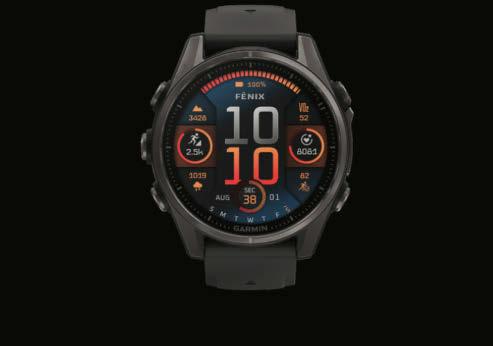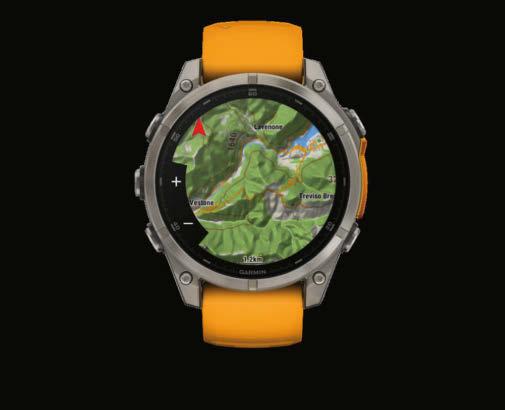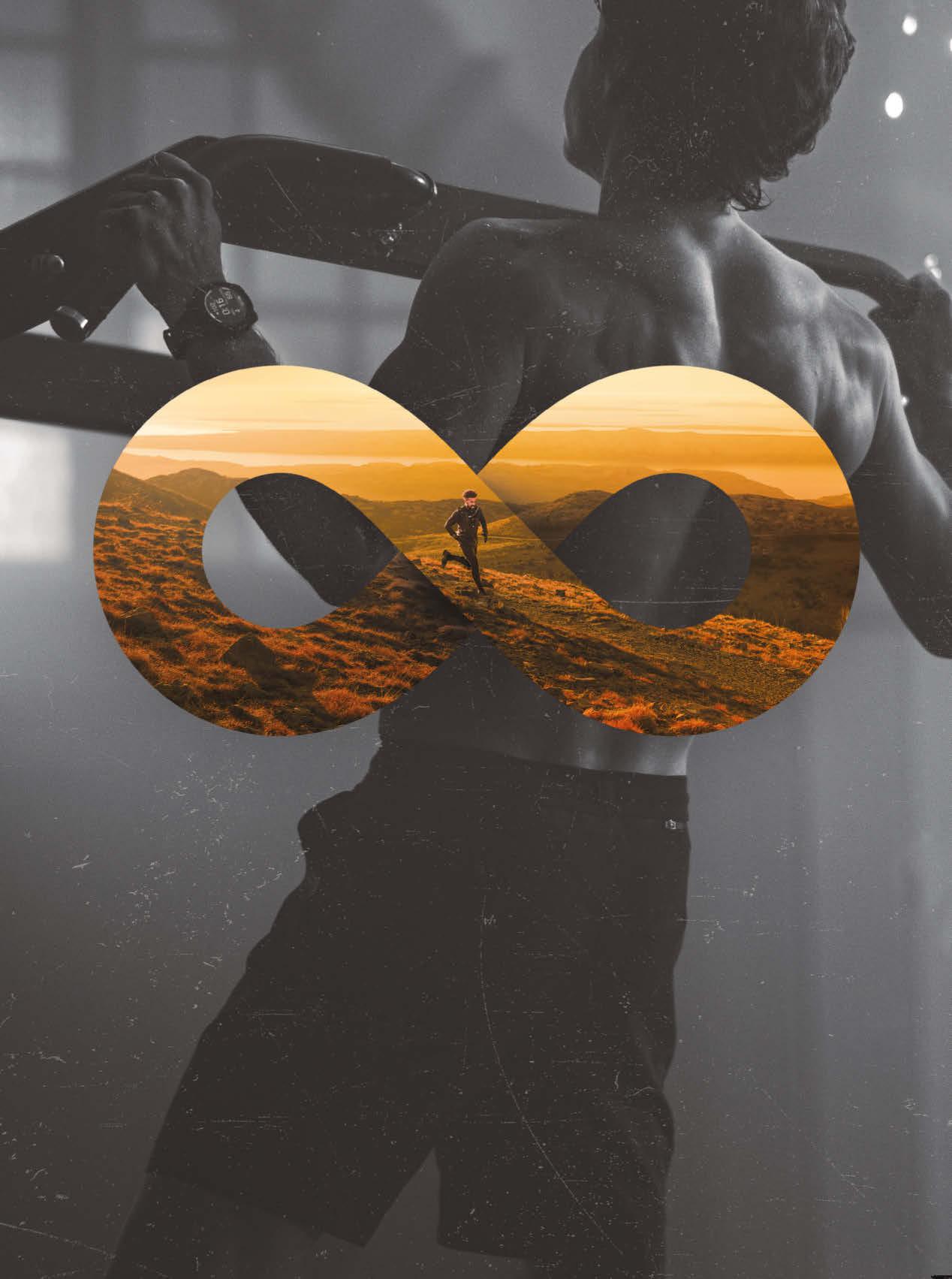BEYOND THE ORDINARY
MOVING MOUNTAINS
Quadriplegic climber
Ed Jackson on his trailblazing journey
WARHOLM VS DUPLANTIS
Two world champions go head-to-head
SEA LEVEL TO SUMMIT
Gear to elevate any adventure



BEYOND THE ORDINARY
Quadriplegic climber
Ed Jackson on his trailblazing journey
WARHOLM VS DUPLANTIS
Two world champions go head-to-head
SEA LEVEL TO SUMMIT
Gear to elevate any adventure


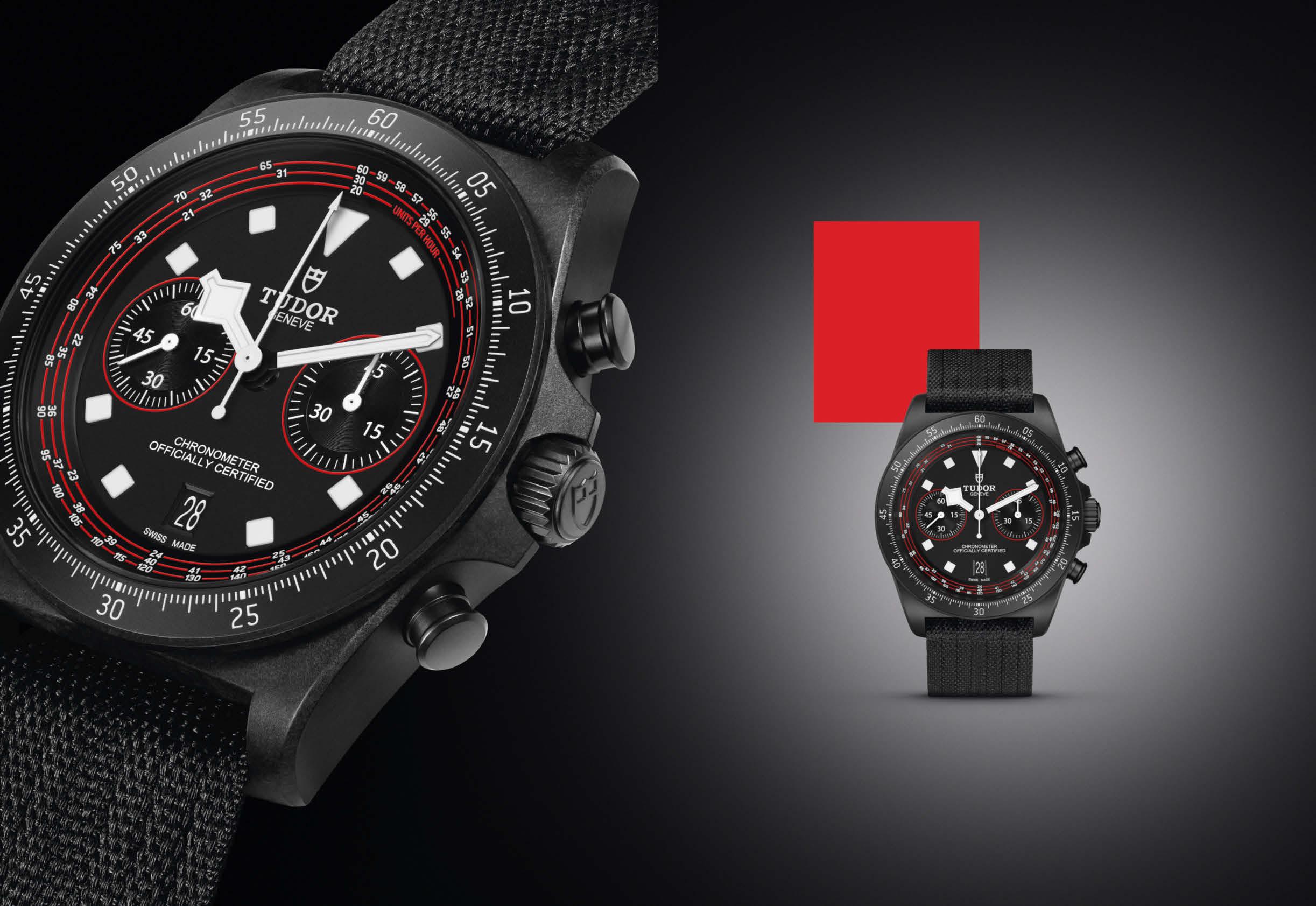







Alex King
Revisiting Finnish skate activists Ramp Dogs after five years away, the British writer was amazed by their impact on the local scene. “It shows what skaters and young people more broadly can achieve if they get organised,” King says.

Jessica Holland
For this issue, the London-based writer spoke to photographer and surfer Mike Coots about the shark attack that cost him a leg, and his advocacy for the creatures since. “His lust for life is infectious,” she says. “He doesn’t seem to let fear hold him back.”

Based in Madrid, Tripodo has shot for Time and the New York Times. This issue, he got up close with Mondo Duplantis and Karsten Warholm for their historic 100m sprint. “The tension was palpable,” he says.
This issue of The Red Bulletin is packed with freethinkers achieving unlikely dreams. Our self-starting cover star, South African musician
Moonchild Sanelly, puts her success down to manifesting. Having written down the names Beyoncé, Diplo and Gorillaz, she has now worked with all of them – and more – on her wild journey to global superstardom. Former rugby player Ed Jackson would probably prefer the term ‘goal setting’. After an accident made him quadriplegic, Jackson gave himself the lofty target of climbing the world’s tallest mountains. Now he’s been on high-altitude adventures that would challenge the most able pros. Plus, we meet the motley crew of Finnish skateboarders who found an innovative path to achieving skate nirvana, and we go inside the ultimate athletic head-to-head as two world champions do battle. Enjoy the issue.
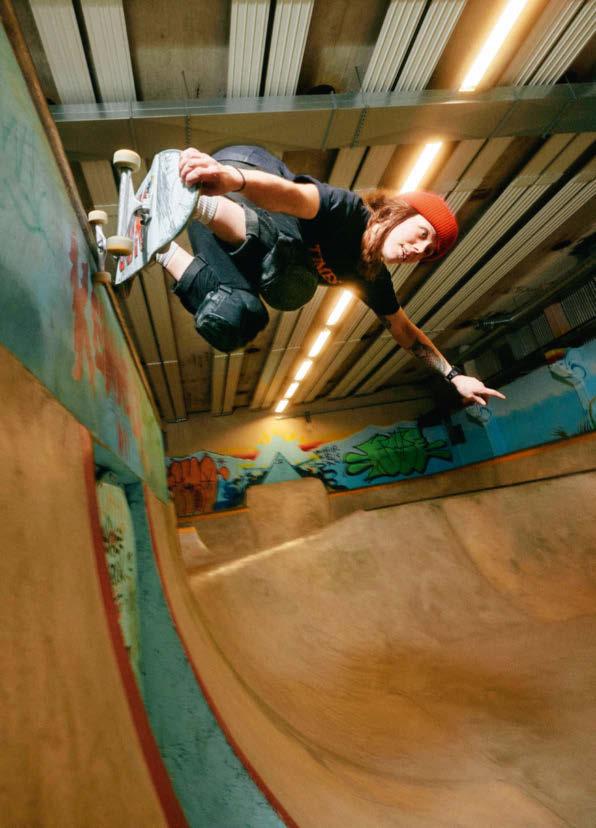


When climbers talk about Digital Crack, they’re not discussing social media but giving a shout-out to the Mont Blanc massif – it’s the name of this 8a-graded route. Here, we see climber Michał Czech on the ascent, shot by fellow Pole Marcin Ciepielewski, whose image was a Red Bull Illume Image Quest semi-finalist (Masterpiece by Sölden category). “Climbing the thin, sharp granite crimps on this route at 3,800m at 4am was a challenge,” says Ciepielewski, “but thanks to our preparations we caught the best light conditions.” redbullillume.com
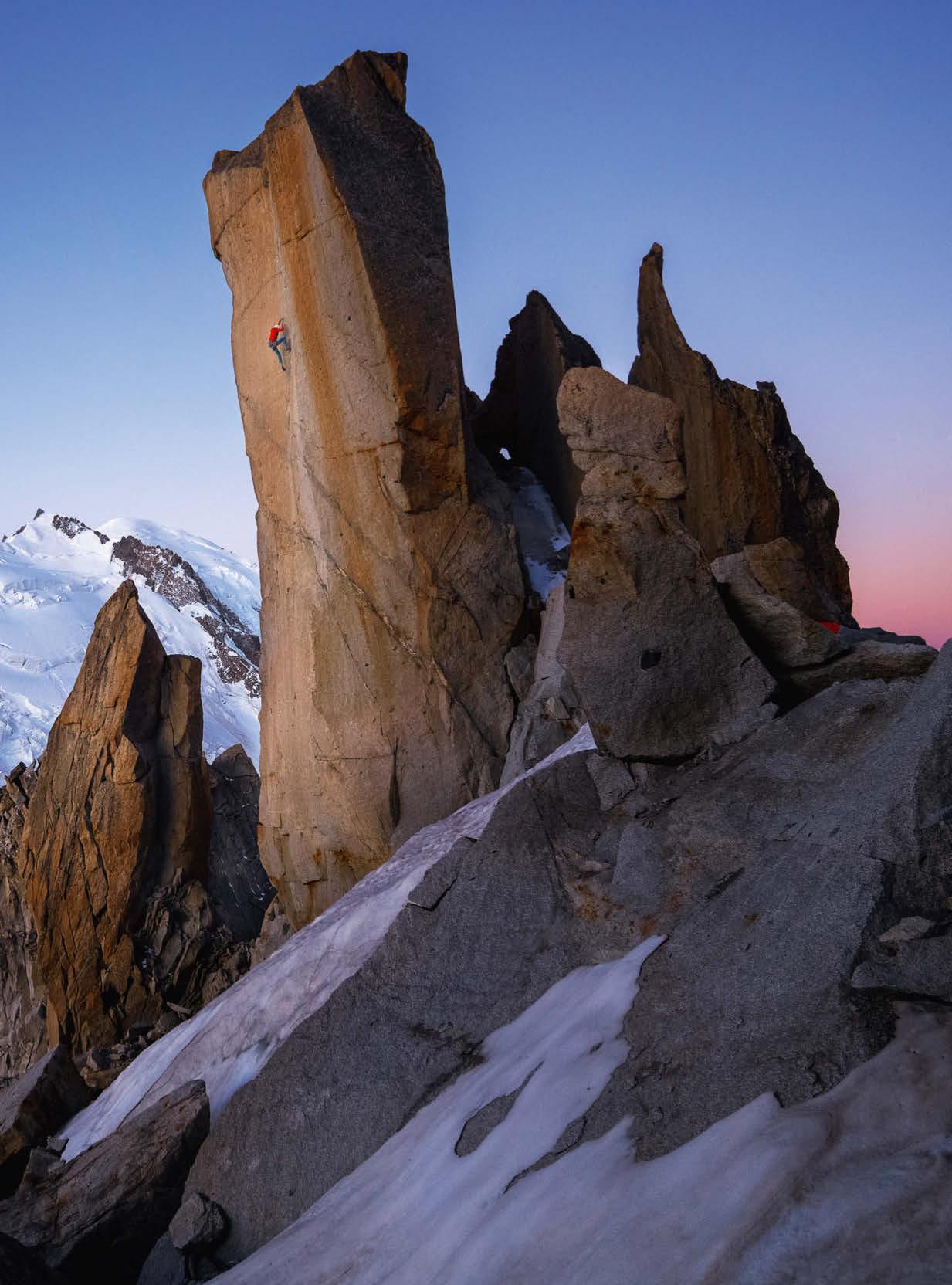
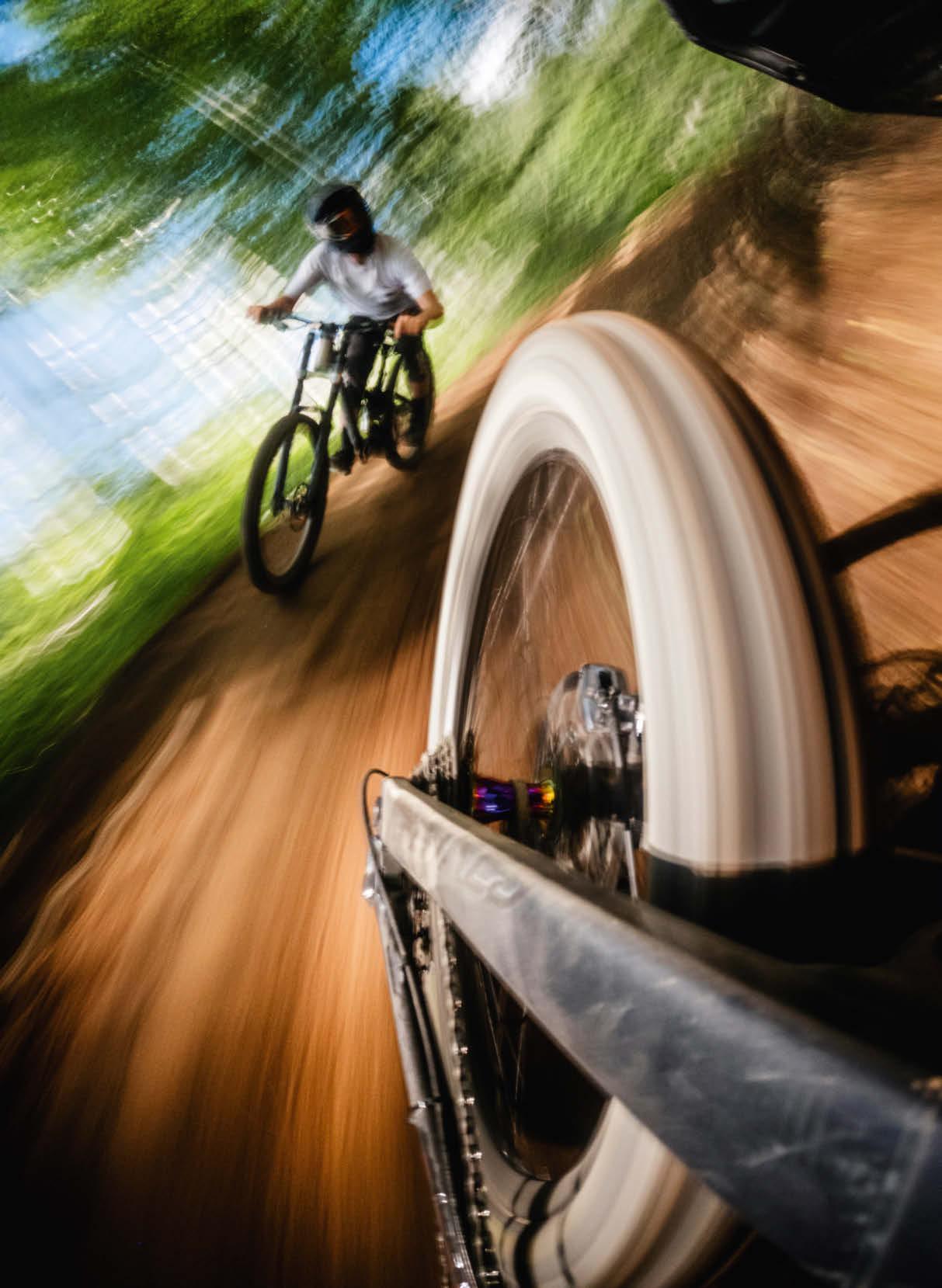
Photography allows you to see life from a different angle – as Daniel Bernstål’s image of MTB-ers Alexander Bäckvall and Hampus Jonsson riding a downhill track in central Sweden shows. “The shot came into my head after scrolling through GoPro’s Instagram,” says Bernstål. “They have a lot of cool angles when it comes to video, but it’s not often that I see good action photos. That got me thinking, ‘Can I make one?’” This seatpost-mounted GoPro shot won him a semi-final place in Red Bull Illume Image Quest (Masterpiece by Sölden category). redbullillume.com
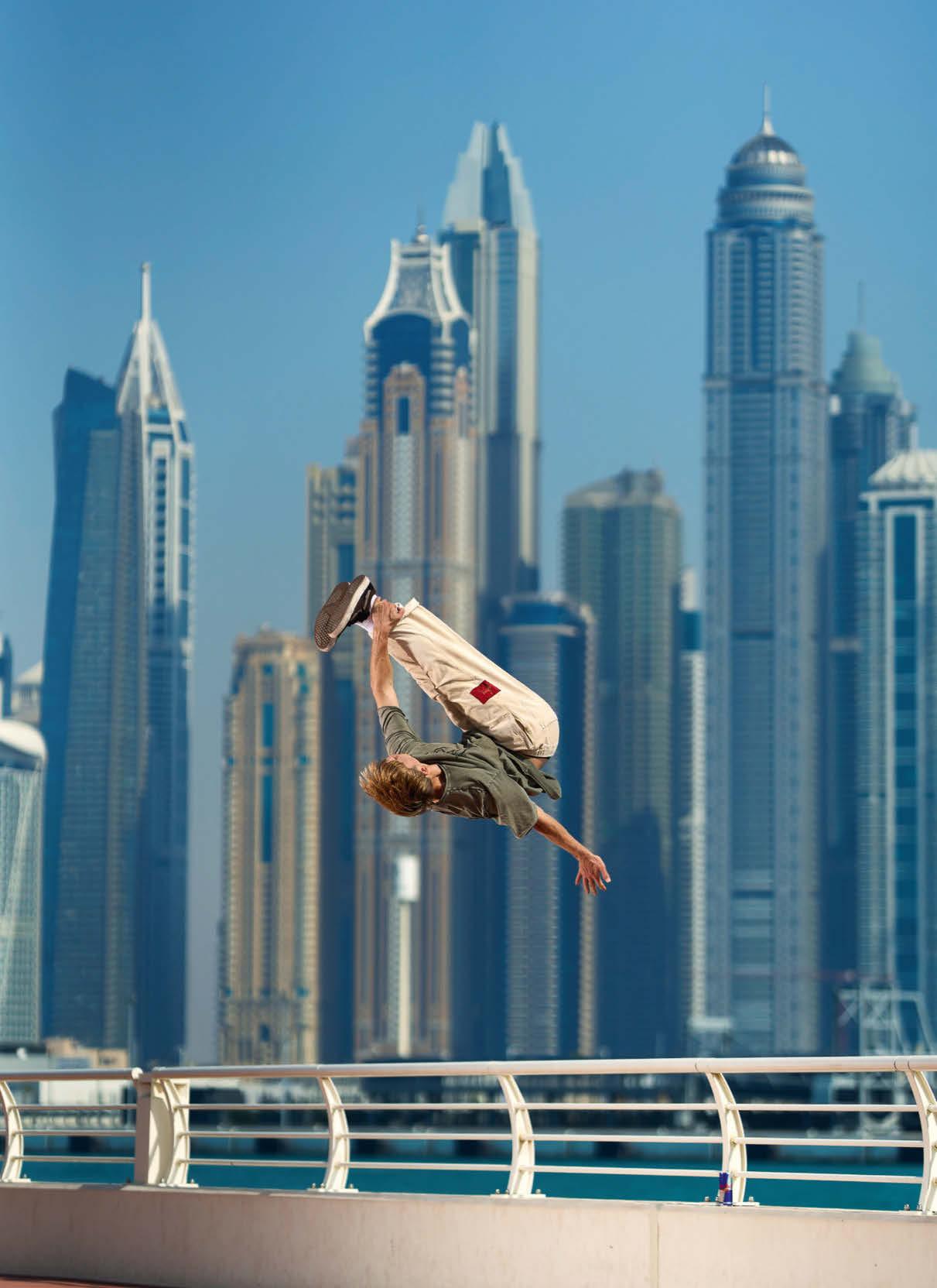
Yes, we know, a towering spectacle. Oh, and the buildings are pretty good, too. “This spot is cool because you can’t get here without a car, and usually tourists don’t come because there’s no entertainment,” explains Latvian photographer Volodya Voronin, “but the view of the Dubai Marina district is quite beautiful.” The main attraction here, though, is parkour ace Evgeny ‘Archie’ Aroyan, whose freerunning frenzy helped Voronin clinch a place in the final of Red Bull Illume Image Quest (RAW category). “In Dubai, heat is always the main challenge, so you need to be fast to set everything up and do it quickly,” adds the photographer. “Archie did several flips in different air shapes and we later chose the best one.” redbullillume.com

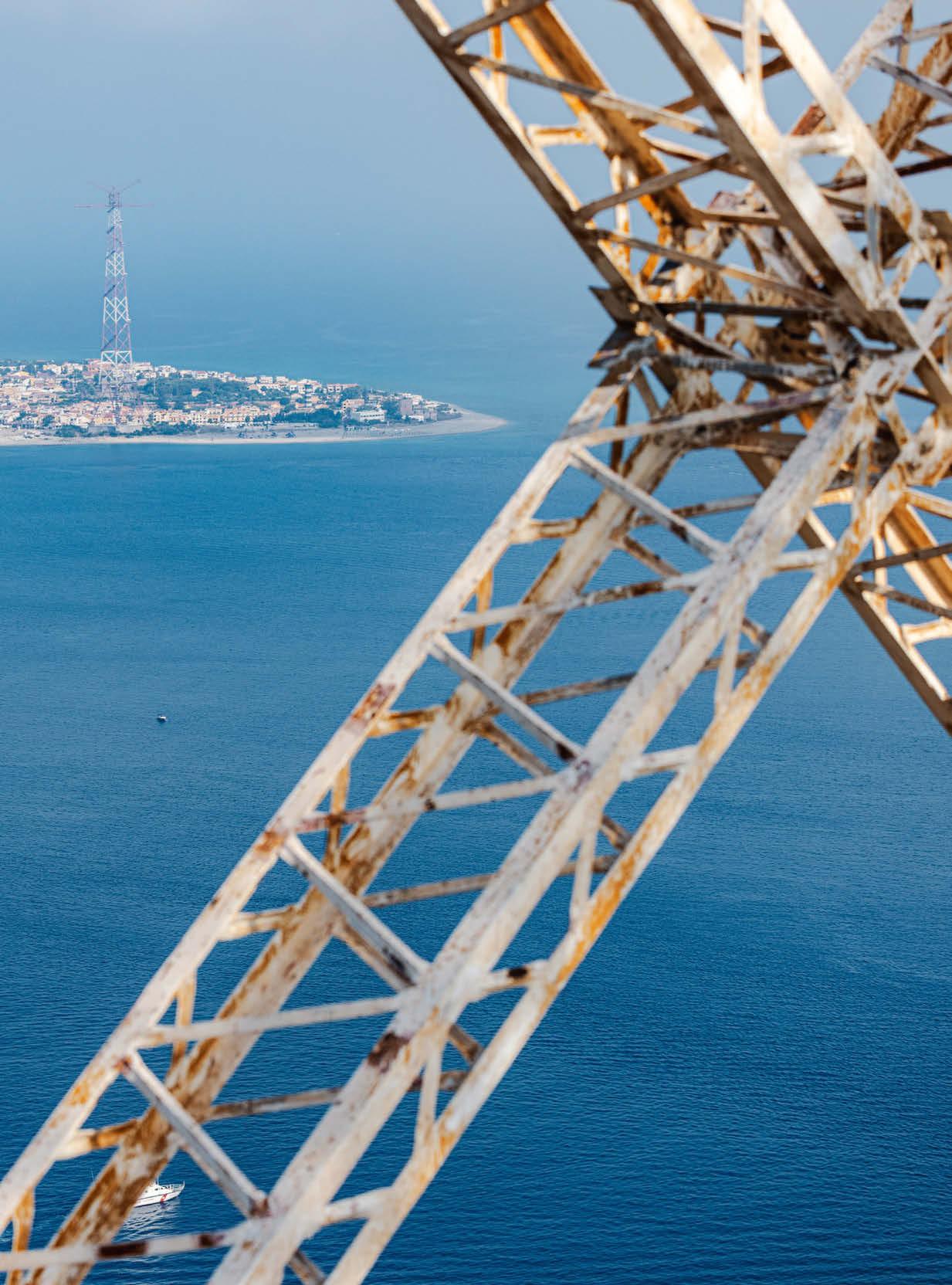
The Strait of Messina, a narrow strip of water between Sicily and Calabria, southern Italy, is home to fearsome sea monsters named Scylla and Charybdis. So says ace poet Homer in his eighthcentury BC page-turner The Odyssey, and who are we to argue? Not that top slackliner Jan Roose needed any greater a sense of jeopardy as he strode 3.6km along a 1.9cm-thin line, 130m above the strait, this July. “I feel Jan-tastic,” declared the Estonian after his world-first crossing. Not so the creatures of the deep, who remained hungry that day. Watch the video at redbull.com

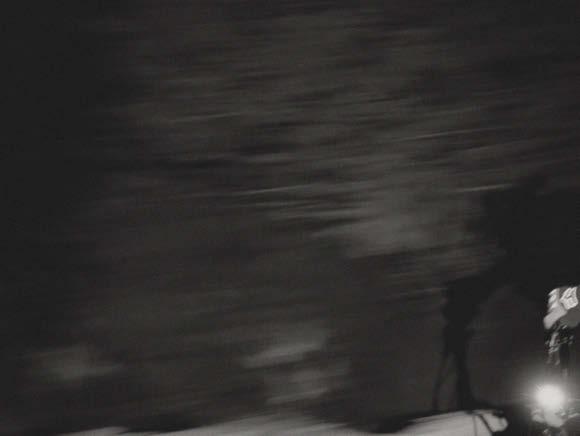
When the day ends, the fun begins.



























Quickly switch between modes on helmet lights by tapping either the body of the light or the helmet without needing to locate the button for fast control to match the pace of the trail. Reflex automatically adjusts the light to provide boosted output when riding hard and fast then intuitively dims for the slower sections such as climbs. This allows much higher outputs in Reflex mode.



Nilüfer Yanya
Four songs that encouraged the London-based singer-songwriter to follow her instincts
Nilüfer Yanya’s dark, emotionally charged indie-pop has won acclaim from both critics and the public over the past decade. Her first two albums, Miss Universe (2019) and Painless (2022), were named among the year’s best by media outlets including The Independent, NPR and Pitchfork, and as well as headlining her own sold-out shows worldwide she was invited to tour with Adele, The xx and Mitski. When working on her new album, My Method Actor, the 29-year-old and her writing partner, Wilma Archer, took refuge from music industry “noise” to reconnect Yanya with her authentic voice. “For me, writing is problemsolving,” she says. “It takes a certain kind of courage to fully trust your instincts... to let it lead you somewhere.” Here, she shares four tracks that inspired the songwriting on her new release… Nilüfer Yanya’s third album, My Method Actor, is out now on Ninja Tune; niluferyanya.com

PJ Harvey Rid of Me (1993)
“I love this song because of its simplicity. There’s a constant muted strumming [throughout]. There’s so much going on, but the strumming doesn’t change – [that’s] what makes it such a strong song. That’s what I feel like I’m trying to achieve with my favourite songs of mine. Knowing songs like this exist is a really big comfort.”


Kae Tempest More Pressure (2022)
“I love all of Kae’s work, but particularly this track. It’s less free-form than their other work; it has a real riff pushing it forward. [On my last tour], I played this constantly when I was in hotel gyms. I’ve seen Kae live a few times and they blow me away every time [with their] delivery and the way they can captivate people using just their voice.”

Westerman Easy Money (2018)
“Westerman is a friend [of mine], and I love this song. It’s weird when someone is a friend but you can totally see their music as a separate thing. He has an alternative, indie sound that also has elements of folk and uses interesting harmonies. I still listen to this song constantly. He has this amazing, unusual old-timey type of voice.”

Big Thief Simulation Swarm (2022)
“When I was making my new record with Will [her writing partner Wilma Archer], we were talking about how it’d be so nice to have a unifying sound on the record, and we referenced this track a lot. It has something intangible that makes it sound like they’re all coming from the same place. I don’t know how bands manage to do that!”
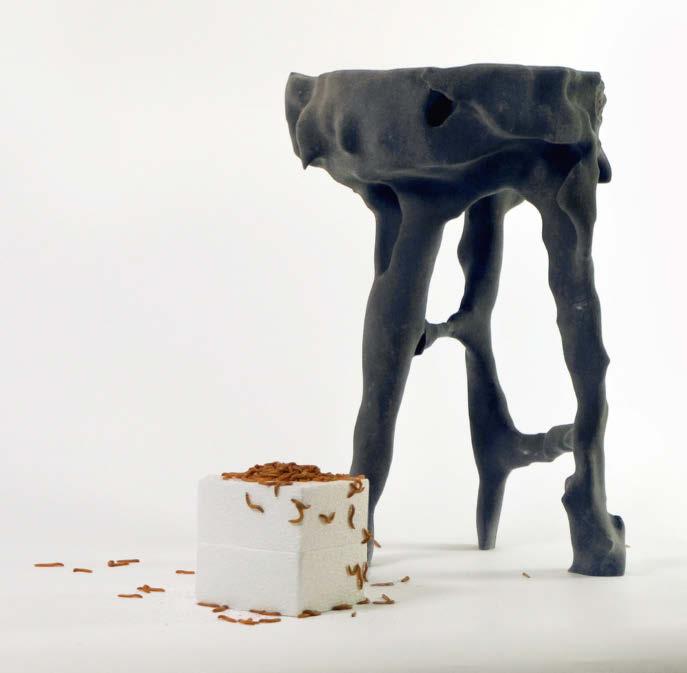
Oxman’s work in this field –the Londoner launched a furniture project that would make mealworms his creative partners. The result is Digested Objects, a threelegged stool cast from designs created by the larvae.
EIiot injected foraged blocks of polystyrene with sugar trails, creating a scaffold for around 200 mealworms to work from. The insects begin by chomping through the high-calorie sugar, then move on to the polystyrene itself, which they can comfortably live off thanks to a ‘superpowered’ bacteria, exiguobacterium, which breaks the polymer down into a more organic matter.
This designer made furniture by collaborating with mealworms, highlighting the environmental benefts of the unloved larvae
When a delivery of hundreds of mealworms arrived at the door of industrial designer Will Eliot, he was dragged out of his comfort zone – even though he was the one who’d ordered them. “I think there’s something, both social and innate in our DNA, that probably tends to avoid that sort of stuff because it’s associated with decay and death,” he admits.
But the 31-year-old from London had grand plans for these larvae, commonly used as chicken feed. Eliot’s design practice, Biocrafting.Studio, specialises in biodesign –collaborating creatively with the natural world – and he’d learnt that mealworms could Biocrafting.Studio
safely digest polystyrene. “It totally blew my mind. The fact a living creature could do that really fascinated me. It’s not just something coming out of the lab; it’s a real organism that’s able to do this.”
On a global scale, this ability could play a vital role in the war against plastic pollution. But it was the implications for design that piqued Eliot’s interest: “What if the world we lived in wasn’t designed by humans but something beyond humans?”
While other artists have experimented with the design potential of mycelium (fungal threads) and silkworms –Eliot was particularly inspired by architect/scientist Neri

Once the mealworms had created a tunnel system in the polystyrene – this takes around a month – Eliot scanned the shape they had created, scaled it up and 3D-printed it, first as a prototype in jesmonite (a sustainable alternative to concrete) then in black sand. The stool’s gnarled appearance resembles tree branches or coral, and Eliot compares the mealworm designs to the imperfections you might find in a forest: “There are these little nooks and crannies you wouldn’t think to make as a human. But it has made sense to them – probably because one bit was easier to eat than the other! You see patterns emerging. There’s this growth of movement that has been frozen in time, almost like a relic or an artefact.”
Though he acknowledges that many of us might find mealworms “a bit gross”, Eliot likes the idea of rehabilitating their image: “The beauty and the ugly is something I often think about, like the ugly parts of nature. Obviously flowers and bees are nice, but I think things like worms and mushrooms are all essential parts of nature with huge uses in the natural ecosystem that we could be leveraging.”
IG: @biocrafting_studio
F U L L O F H OT A I R .
Es pe c i a l l y o n t h e t r a i l W he n yo u ’r e
n e go t i a t i n g u n s t a b l e s u r f a c e s i t ’s b e s t t o
h a v e p le n t y o f g i v e A i r d o w n a ppr o p r i a t e l y
t
s o f t s o i l s i t u a t io n s O t he r w i se , i t ’s li k e a
b a l le r i n a w a l k i n g p o i n t e t h r ou g h a e l d o f m u d Yo u ’ l l s i n k pr e t t y q u i c k A n d m o r
t h r e a t e n i n g t h e i n t e g r i t y o f t h e t r a i l f o r
o r o a de r s w h o f o l l o w yo u r p a t h




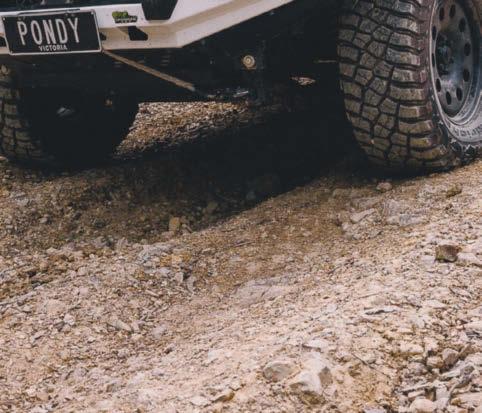
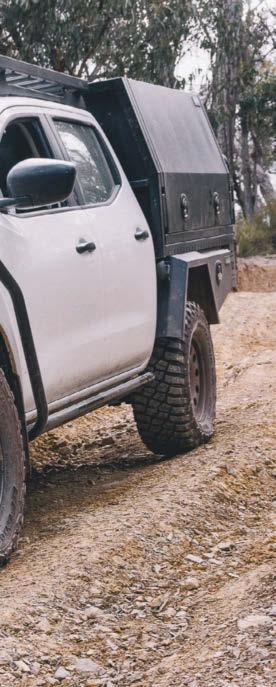



Luc k i l y t h e B FG oo d r ic h ® A l l -Te r r a i n T/A®
KO 2 ® i s j u s t a s t ou g h o n t h e s i d e s a s i t i s
o n t h e b o t t o m S o w he n i t de a t e s , m o r e
t i r e m e e t s m o r e g r o u n d , i t ’s j u s t a s s t r on g ,
a n d t h e E a r t h b e l o w d o e s n ’ t h a v e t o b e a r
q u i t e a s m u c h w e i g h t I t ’s li k e s t r a p p i n g
s n o w s h o e s t o yo u r s n e a k e r s t o c r o s s a e l d
a f t e r a s t o r m Yo u r w e i g h t i s t h e s a m e b u t
s ud de n l y yo u c a n w a l k o n w a t e r
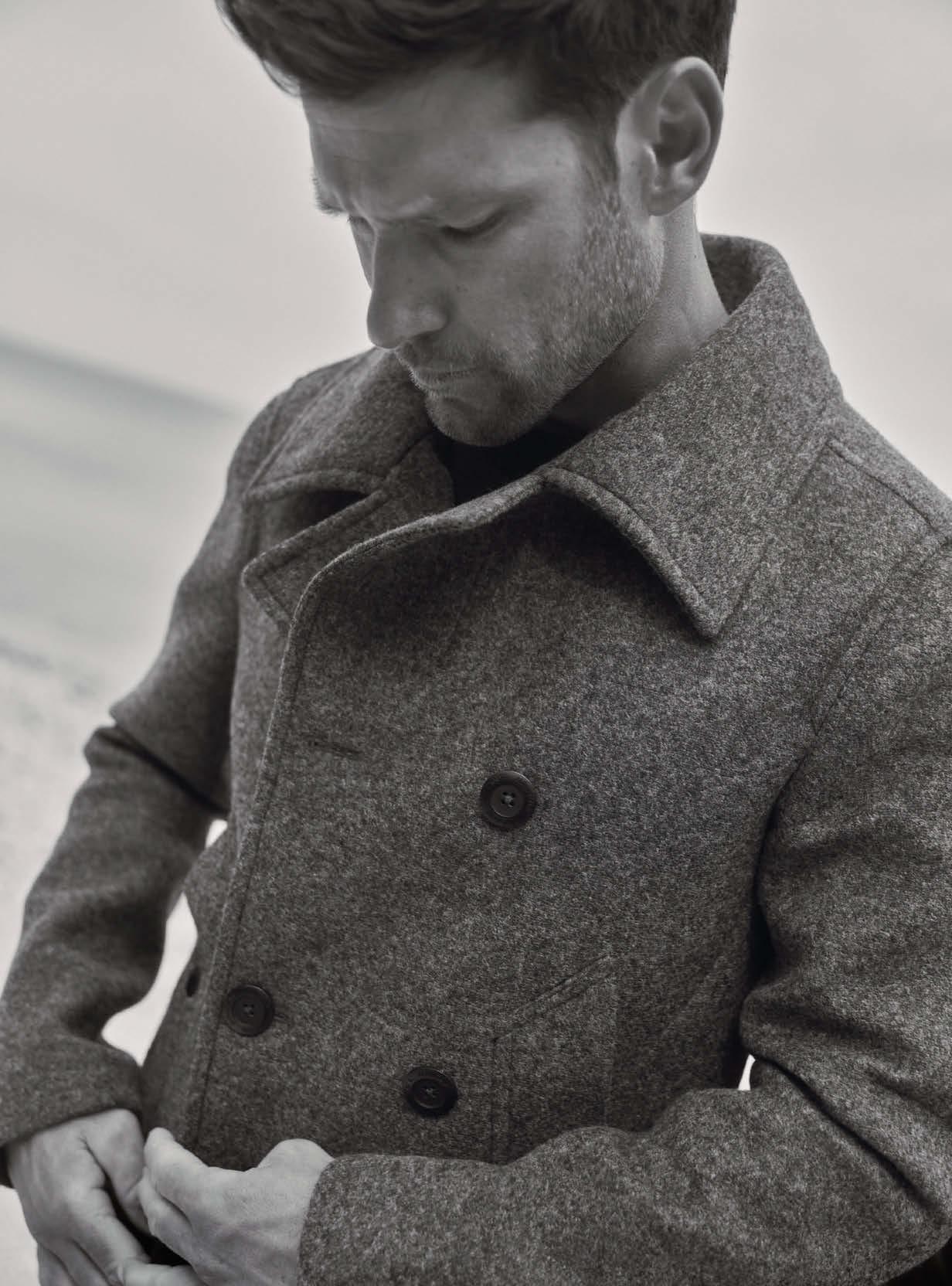
Even in Canada, where curling is popular, the sport is subject to some commonly held stereotypes. “It’s one of those sports where folks say, ‘I could probably get into the Olympics for curling!’,” says Vancouverbased filmmaker Josephine Anderson. “People think it’s easy. They think it’s boring, too. It’s a slow sport – it takes about two to three hours to finish a game.”
It was while playing for a recreational team herself that the documentarian saw the potential to tell a fresh story about the sport in which two teams slide granite stones down large sheets of ice, towards a target. “I wasn’t very good at curling, but it was fun,” says Anderson, whose previous films have centred on freestyle wrestling and mountain biking. “We were all fumbling around, and it struck me that it was a lot like being a teenager – awkward! I began to wonder what it might be like to smash those two worlds together: this world of curling, which is weird and wonderful and misunderstood, and teenagehood, which is equally misunderstood.”
The result is Curl Power, a film that follows Team 4KGirl$, five teenage curlers from British Columbia striving to become Canadian national champions. Over three-and-ahalf years, Anderson trailed the young women as they were coached by three of their mothers, all former Olympic and world champion medalwinning curlers themselves.
“I’m so glad I followed a team of girls with all-female coaches,” Anderson says. “There’s something so inspiring about watching a team of girls work so hard together, endure moments of interpersonal conflict or other challenges in their lives, but lean on each other through the chaos of teenagehood.”
The logistics of filming on slippery ice proved tricky, but Anderson found that multiple cameras enabled her to

Think curling is easy, or boring? This new flm on the journey of a young, all-female Canadian team might change your perspective
capture the beauty of the game: “It’s kind of poetic to watch. The shots are so pinpoint-precise and very difficult to pull off, though professional curlers make it look really easy.”
As Anderson knew, it’s anything but. Players require not only exceptional handeye coordination and a tight core to maintain balance but also – with a game lasting up to three hours – mental fortitude. “It’s hard to stay in that middle zone between overthinking and being focused. These athletes are good curlers because they’re not tripping themselves up with too much thought.”

And in following such a young team, Anderson was struck by curling’s unusual position as a sport where youth isn’t necessarily an asset. “The best curlers are not typically 18, 19,” she says. “It’s a gradual climb. You’ll see people in their thirties, even forties, who are really at the top of their game because they’ve perfected that body-mind balance. There is a clash between the sort of character qualities top curlers have and the nature of being a teenager, because they are still coming into themselves. It’s kind of beautiful to watch them attempt to master it.”
josephineanderson.ca/ work#/curlpower/
Cardboard art that blurs the line between comic-book fantasy and the real world


In a video on Instagram, the artist Nonamey is cooking. Standing in a kitchen with fuchsia-pink walls and neonorange worktops, they put a pan on the hob, open a can of tomatoes and chop basil. But the pasta dish they plate up isn’t edible. Like all their works, everything in the video is made from brightly painted cardboard: the walls, the worktops, the knives, the sink, the oven, even the spaghetti. Based in Portland, Oregon, Nonamey has been working with cardboard their whole life: “Probably from the moment my parents first gave me a
refrigerator box. I think most of us have an early relationship with the cardboard box because it can be a spaceship, a castle, a store… It can be anything we imagine it to be.”
They started out working exclusively in black and white but, at 27, moved to colour: “That was a moment of emotional liberation in multiple ways, because it was also the year and age I came out as a queer person. Working with colour and coming out went kind of hand in hand.”
From that point on, Nonamey’s technicoloured visions were realised in life-
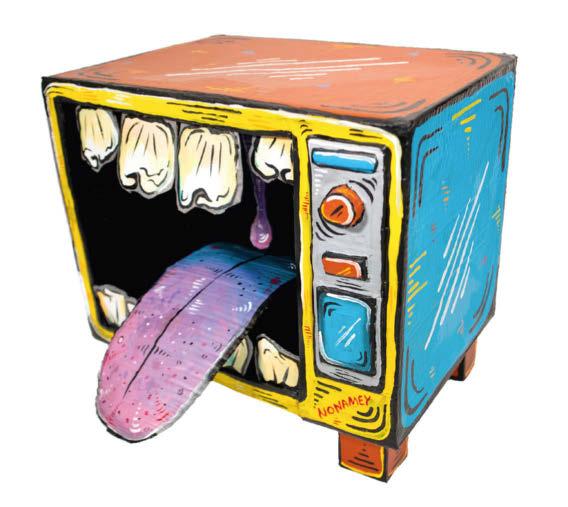
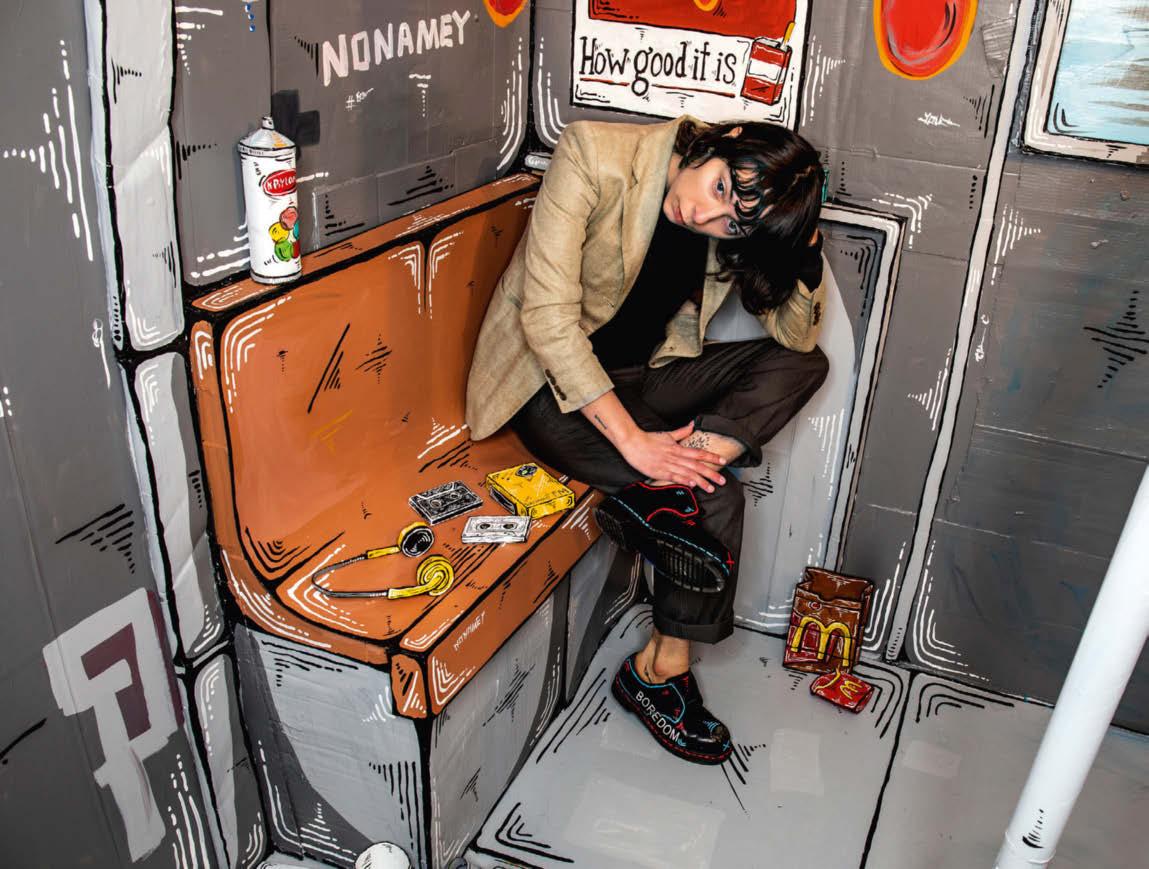
size cardboard installations: the backstage area of a drag show, a subway carriage, a motel, and their latest work, Teen Dream, a nostalgia-filled bedroom featuring ’90s band posters, a turntable, a touchtone phone, a guitar and amp, and a VHS player.
The imaginary girl who lives here is based on Nonamey’s own teen self, who was femmepresenting, and identity is an important factor in their work. “As an Indigenous artist [they are a two-spirit Ojibwe from the Bad River and Lac du Flambeau tribes], everything I create is indigenous art, but
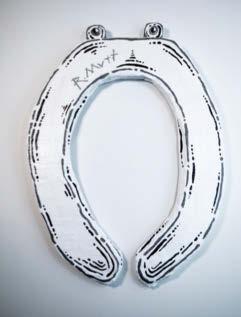
not stereotypically so,” they say. “I get a lot of joy out of inserting personal sculptures into my installations that say a little about my indigenous identity or my queer identity so other individuals may identify and say, ‘Oh, this makes sense to me.’”
Although Nonamey finds cardboard easy to source – 95 per cent of what they use is recycled, much of it donated by friends – it can be a challenge to work with. “The cardboard box wants to be a cube; it wants to have hard edges,” they say. “So, to work with softer edges or curves, a
lot of manipulation is required to break up what I call the honeycomb. It takes time, but it’s incredibly meditative.” Their finished work has the effect of a graphic novel come to life. “It does have this sketchy effect to it,” explains Nonamey. “Every corner has a motion line, because I want it to feel alive. I want them to feel electric, even though they’re stationary. I would say that it looks like you’re stepping into a comic strip, essentially… In a sense, I become a character in this narrative space I’ve created.” IG: @nonameynonamey

Homegrown genres such as drum’n’bass and UK garage owe their existence to the nation’s record stores. A new project blows the dust of this long-neglected chapter in the evolution of Black music
Simon ‘Schoolboy’ Phillips’ love affair with record stores goes way back. “I’ve been a DJ since I was 15,” says Phillips, aka DJ Schooly. “The ‘schoolboy’ part of my DJ name came from me jumping on the bus to the record store before school and waiting for the doors to open. They’d say to me, ‘Shouldn’t you be at school?!’”
After three decades as a successful club and radio DJ, the Leicester-born 52-year-old has channelled his experiences into a new project, The Record Store & Black Music: A UK History. Encompassing a book, a website, a podcast series and a documentary (launching this Black History Month), the project explores the vital role of UK record stores in Black music history. “The new generation see vinyl as just a cool music-delivery system,”
says Phillips, “but for us, it was our lives. Without the record stores, there’d be no UK garage, no drum’n’bass. They’re where the music was, where the producers were, most of them working behind the counters.”
The Record Store & Black Music: A UK History draws on 100-plus hours of interviews with store owners, customers and DJs including Jazzie B, DJ Spoony and DJ Paulette. Phillips is keen to show how cultural hubs such as Ainleys in Leicester and Birmingham’s Summit Records facilitated the cross-pollination of tastes, ideas and genres outside the mainstream. “[The industry] was a closed shop unless you were signed to a major label. But these stores allowed you to press your records, sell them, make deals. You could break purely from being visible there.”

The multidisciplinary project is the brainchild of Vijay Mistry, former owner of 2Funky Records and founder of social enterprise 2Funky Arts. “When I looked into it, there was nothing documenting Black music record stores,” Mistry says. “It was very indie-, rock- and pop-based. But we’re talking soul, hip hop, reggae, drum’n’bass, garage, dub and, later on, grime.” With much of this history existing only in the memories of those who lived it, this is the first time such stories have been collated to give context to the present-day musical landscape. “It’s important for me to tell the story from a front-seat perspective and finally give flowers to our past and present heroes,” says Phillips. “We have records that have shaped the music we listen to today. These are our Elvises, our Coldplays, our Bowies, all of them rarely credited for creating genres, movements, and influencing generations. There’s always a starting point, and for Black music it was record stores.” legacyproject.online

This Hawaiian surfer doesn’t believe in limits: losing his leg to a shark hasn’t stopped him chasing waves, or falling in love with the creatures that attacked him
Words Jessica Holland
Mike Coots was just 18 years old when he was attacked by a tiger shark while bodyboarding close to his home in Kaua‘i, Hawaii, resulting in the loss of his right leg. Now 45, he remains an avid surfer, having resumed the sport the second he was given clearance by his doctors; Coots now surfs with a prosthetic limb.
That’s not even the most remarkable part of the Hawaiian’s story: he went on to fall in love with the creatures that had almost killed him. After training as a photographer, Coots began diving with sharks, photographing them underwater and advocating for their conservation. Last year, he released a coffee-table book of his surprisingly intimate images, SHARK: Portraits.
The Red Bulletin tracked down the inspirational surfer to find out how he not only overcame a life-altering catastrophe but actually found gratitude for the new world it opened up.
the red bulletin: Is it possible to describe the experience of fighting off a shark with you in its jaws?
mike coots: It was just complete fightor-flight instinct. I tried to push my legs out of the shark’s mouth with my hand, but that didn’t work. I punched it in the head and it let go of my legs. I didn’t realise until I was paddling in that one of them had been completely severed. It wasn’t scary then; it was this real peaceful feeling. A little wave came and I caught it right up to the sand. One of my friends made a tourniquet with my [bodyboard] leash. Then another guy threw me in the back of a pickup and we hauled butt to the hospital.
How long was your recovery?
I almost lost my other foot, I had big lacerations elsewhere on my body, and my hand got pretty mangled up from when I’d put it in its mouth. But I just felt lucky to wake up the next morning in the hospital alive with my parents by my bedside. A month later, I was back in the water, just with one less limb. It was a challenge to learn how to use a prosthetic to drive, ride a bicycle, run and hike, but in a way I enjoyed figuring out how to adapt. I would buy used [prosthetic] feet off eBay and try to make the ultimate surfing foot.
Was it difficult getting back into the water?
The hardest part of that month [after the attack] was being out of the water and not being able to surf. Statistically, it’s much more dangerous for me to drive my car than to be in the water with sharks, and if something were to happen, [being in the water] is what I love doing. If I were to sit on the couch all day and play it safe, that’s not really living. Getting back in there was one of the most beautiful feelings I’ve ever had. It felt like returning home.
But as a photographer you seek sharks out. Why?
Following the attack, I studied to become a fashion photographer. Then a fellow shark-attack survivor urged me to watch a [2006] documentary called Sharkwater. I was totally blown away by it. For every shark that hurts somebody, we hurt so many more sharks [every year, an estimated 100 million are slaughtered for their fins]. As somebody who loved the ocean, I felt compelled to use my story to help make the oceans a healthier place. With a group of [other] shark-attack survivors, I spoke to Congress and got a bill passed to
strengthen protections on sharks in the US. Now, the possession of shark fins is completely contraband. I also spoke to the United Nations on marine-protected areas. Then I got invited to go shark diving and fell in love with being with sharks underwater. I found that sharks are the greatest subject on Earth to photograph. They’re beautiful.
How did it feel to encounter a tiger shark after the attack?
I’ll never forget it. It was at [tiger sharkdiving hotspot] Tiger Beach in the Bahamas in 2016. I was very nervous but also really excited. I started shooting away, but then, about 10 minutes in, I put down the camera and enjoyed the moment. It was awe-inspiring. I felt a full 180° turn on what I thought sharks were. Some of my best shark photography was captured that day. All the fear just seemed to drift away.
Why was it so important for you to face your fear?
We’ve got a saying here in Hawaii: “If can, can. If can’t, still can.” It’s the idea that you can do anything you put your mind to. People see my prosthetic and think to themselves, “He’s disabled. Poor him.” But I feel like everybody’s got something in their life that could hold them back from really living their dreams. Actually, the biggest thing holding you back is your own mind. Everybody’s got their own voice, their own skills, something that will make this planet a better place. It’s important to find that voice and listen to it.
Birthplace Kaua‘i, Hawaii Favourite sharks Great whites, which he photographs from the safety of a cage, and tiger sharks, which he swims with unprotected Photography techniques Coots often shoots sharks using a portrait lens: “I want to shoot them in a different way so maybe you can see a little bit of yourself in them” No room for regrets Coots says that if he could go back to the day of the attack, he would still choose to go surfing, even knowing he would lose a limb Watch The Call, a documentary about Coots’ remarkable journey from shark-attack survivor to advocate, at the Ocean Film Festival; oceanfilmfestival.co.uk

“Sharks are the greatest subject on Earth to photograph. They’re beautiful”
The Sydney-born,
Los
Angelesbased musician can boast a rare talent for whistling – and she’s turned this underrated art form into a lucrative career
Words Lou Boyd Photography Brian Overend
Ten years ago, having made the big move from Sydney, Australia, to Los Angeles, Molly Lewis looked out at the expansive and expensive city and wondered how she would ever find success. Little did she know then that all she had to do was purse her lips. Today, at the age of 33, Lewis is Hollywood’s favourite whistler. Skilled in the art since childhood, she’s built a successful career on LA’s art-rock scene, working with artists such as Karen O and Dr Dre, appearing on the soundtrack of the Barbie movie, and staging her own sold-out ‘Café Molly’ lounge shows with a full band.
In February this year, Lewis released her debut album, On the Lips, inspired by all those nights spent gigging around the city. “I wanted the record to feel like a live show, to feel like you’re at a lounge show where there’s an intro, a couple of covers, and a kind of ebb and flow of pace and moodiness, like descending into a late evening in a jazz club,” she says. Here, Lewis revisits the discovery of her underrated talent, which blossomed into an unexpected passion and ultimately a lucrative career…
the red bulletin: What’s your musical background? And how did you start whistling?
molly lewis: Put it this way, I didn’t go to whistling classes when I was a kid. I grew up playing piano, but I was a bad student. I always had a very good ear, so I didn’t learn to read music. I could piece things out by myself, which made me lazy. Then one day I just started whistling to myself.
How did your parents react to your sudden interest in whistling? They encouraged it! They showed me a documentary about a whistling competition [Pucker Up: The Fine Art of Whistling] and introduced me to this greater world of whistlers. I knew I was good at it, and I started researching and learning about other famous whistlers. That’s when I thought to myself, “This is something I could do.”
What does the world of whistling look like?
It’s a small, very niche community with a lot of competitions. That’s the only time I ever get to meet other whistlers. Most aren’t making original music; it’s mostly covers and different variations of classical songs, and most people aren’t whistling professionally full-time. There’s one world-class whistler from the Netherlands called Geert Chatrou. He performs with Cirque du Soleil and has whistled with philharmonic [orchestras] and released records. It’s really just me and him.
How does it feel having a career in such a sparsely populated space? [Laughing] It feels great! It’s difficult to make a living in music, so I’m very lucky in that regard. I feel bad for the other musicians in LA who are trying to get noticed or fit into a saturated space.
How much daily practice do you do? I feel like a brat saying this, but I don’t do any daily practice. I remember being at university and walking past rooms where classical music students were practising eight hours a day. I don’t need to practise like that; whistling is something I do when I’m walking in the park or cooking at home, or just whistling along to something I’m listening to. It’s kind of inadvertent practising.
You’ve collaborated with so many huge names in music, from Dr Dre and Karen O to Mac DeMarco… It’s wild! Dr Dre hit me up to go and do a studio session with him. I figured that I was going to be improvising over beats, which I had never done before, so I sat in the car outside the studio beforehand and practised whistling over his tracks! Karen O messaged me out of the blue and asked me to perform at an event she was doing. When I went backstage after the gig, Johnny Depp and David Lynch were there. They were like, “Oh no, we missed your song. Will you do it for us now?” So I just performed for them right there and then, backstage. And Mac DeMarco is now a friend of mine – we go camping together.
Last year, Mark Ronson asked you to contribute to the Barbie movie soundtrack. How did that come about? My producer, Tom Brenneck, came into the studio one day and said, “Mark Ronson has asked for your phone number. Expect an interesting phone call.” When Mark called, he told me they wanted to take the Billie Eilish track from the movie [What Was I Made For?] and orchestrate an instrumental version. They wanted a lush, 1930s-style orchestral version to play during the part of the movie where Barbie goes back in time and meets her creator. I whistle Billie’s melody over that scene.
You’re working at the top of the Hollywood music industry – have you ever been recognised by a fan? I was once recognised for my whistle! I was whistling on the street and someone heard me and said, “Are you Molly Lewis?”
Do you think that more professional whistlers might start emerging? Could we see a deluge of whistling albums released a few years from now?
Ha! They’re not allowed. This is my thing.
Name Molly Lewis Trophies First place, Live Band Accompaniment (Female), Masters of Musical Whistling (MMW) 2015; Second place, All-Around, MMW 2023 Releases The Forgotten Edge EP, 2021; Mirage EP, 2022; On the Lips, 2024; all on Jagjaguwar Website molly-lewis.com
“I was whistling on the street and got asked, ‘Are you Molly Lewis?’”

The Wigan-born adventurer and expedition leader is making history by travelling from the lowest geographical point to the top of the highest mountain on all seven continents
Words Tom Ward Photography Aaron Rolph
From deserts to jungles, icecaps to oceans, British adventurer Oli France has traversed the lot, and all by the age of just 33. A qualified expedition leader and fellow of the Royal Geographical Society, Wigan-born France has visited 75 countries and summited mountains including Halgurd – the highest peak in Iraq – and Mount Nyiragongo, an active volcano in the DRC.
His latest challenge, The Ultimate Seven, will see France become the first person to travel from the lowest geographical point to the highest on all seven continents, all under his own power. This epic feat of endurance will span 24,000km across 20 countries.
France completed the African leg in September last year, cycling 2,634km from Djibouti to Tanzania before summiting Kilimanjaro. This March, he nailed part two, cycling 5,774km from Death Valley, California, to Alaska before climbing to the top of Denali. Next up is a 2,400km cycle through Argentina, from the salt lake Laguna del Carbón to the Andes, followed by a 6,961m ascent of Aconcagua.
Here, he discusses the highs and lows of the adventurer’s life…
the red bulletin: How did you turn adventure into a career?
oli france: I grew up working-class in Wigan, playing football and rugby league. I wanted to spend every waking hour outside, but I didn’t discover conventional exploration until I went on a rock-climbing weekend at the age of 17. For the first time in my life, no one was telling me to get down; they were encouraging me to go up. Off the back of that weekend
I studied outdoor leadership at university. I met like-minded people and spent my summers working in the Middle East, Africa, North America… I developed this passion for adventure.
You’ve done a lot of amazing things already, but The Ultimate Seven takes it to the next level. How did you come up with the idea?
I’ve dedicated most of my adult life to adventure. As I’ve travelled, I’ve always had new ideas. Some fizzled out, but I had this one a decade ago and it stuck. At first I thought, “No, it’s too big, too scary, too hard, too logistically difficult.” Then, as I built my skills and experience, I got to the stage where I thought I could take a crack at seven really bold, humanpowered journeys that would challenge me in every conceivable way.
What’s been the biggest challenge you’ve faced so far?
Making the expeditions happen is really hard. The North American leg was the biggest, most expensive expedition I’ve ever put on, which meant convincing a lot of people to help me make it happen. And it really challenged me on a physical level. Three days into North America, my body was in bits, with 10 weeks still ahead of me. I was taking painkillers to be able to sleep at night. You’re dealing with potential dangers and risks, and an endless list of doubts: “Can I make this happen? Will I let everyone down?”
How do you balance the risks?
We spent three-and-a-half weeks on Denali, gradually working our way up. The higher I got, the more the risk escalated, whether that’s crevasses or avalanches. The temperatures only got lower, the altitudes more consequential. Two people died – we saw one of them being helicoptered off, and he didn’t
make it. You have to leave your ego at home. And ignore any kind of ‘summit fever’. In a mountain environment, forces exist that are way more powerful than us.
What drives you?
The ‘why’ evolves over time. I grew up with a map on the wall, wanting to see the world. As I got into guiding, I was motivated to meet as many different people as I could. With The Ultimate Seven, I’m a father of two young children and I want to inspire them. On Denali, I didn’t want to say to my kids, “I tried this really hard thing, but it got too difficult, so I just quit.” Having that conversation was unthinkable.
What are you most looking forward to on the South American leg?
It’ll be a world first – no one has done this. A challenge on day one will actually be getting to the starting line. The lowest point in South America is private land, so there are potential difficulties there. After that, it’s very windy up on the mountain, with brutal storms. And it’ll be the highest mountain I’ve climbed to date.
What advice would you give to any would-be adventurers?
Historically, adventurers tend to come from a more elite upbringing. I was a kitchen salesman in Wigan – I had no silver spoon, no one to point me in the right direction. There were so many reasons why I shouldn’t be doing this. Now, I spend some of my time going into schools and trying to do my bit to share my own journey. I hope people can feel inspired by it and have that willingness to take those leaps of faith. I tell people, “Nobody will back you, nobody will believe in you. The biggest thing you can do is back yourself. If you can do that, you can make big things happen.” Instagram: @oli_france
Tackling North America in numbers
50kg of bike weight 35kg of sled weight during the ascent of Denali 55,000 kcal consumed daily while summiting Denali 6kg of lost body weight 200 items in his backpack 2 punctures while riding -30°C at Denali’s summit 32°C of intense heat while crossing Death Valley
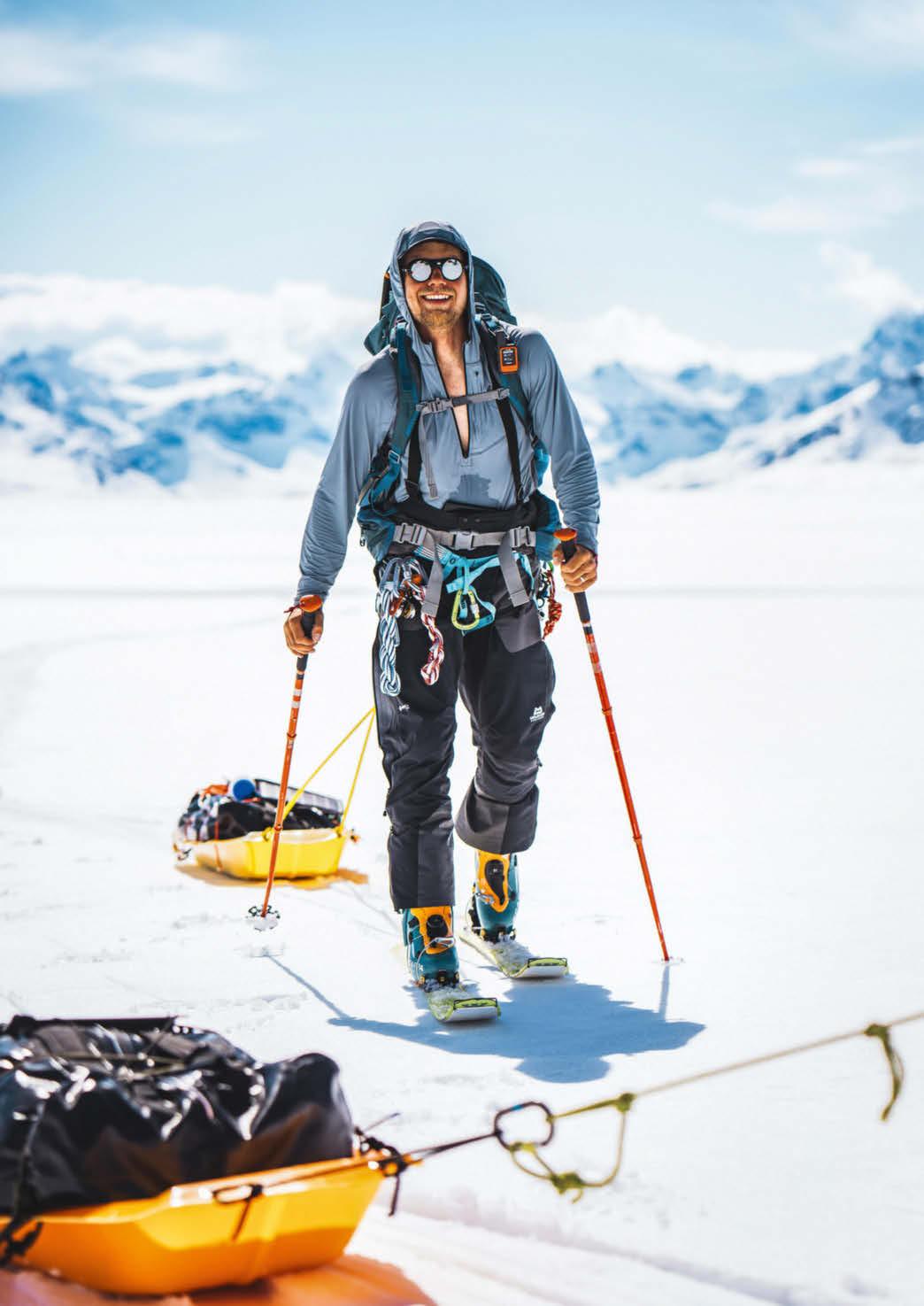
“I was a kitchen salesman in Wigan – I had no silver spoon”
This effervescent South African musician has always known she’s a global superstar. Now, finally, the rest of the world is catching up

When Moonchild Sanelly was in her twenties, she trademarked her hair. The then-unknown South African poet, dancer and musician – born Sanelisiwe Twisha – was performing her poetry on the Durban open-mic scene by night and studying fashion at college during the day. Though she didn’t have a public profile at the time, the young artist was resolute about copyrighting her sapphire-blue woollen braids, legally branding them the ‘moon mop’. For Sanelly, it was a logical move.
“I knew my power,” she says, looking back. “People thought I was crazy, but I just knew I was going to be great. And I knew that someone would take my thing before the spotlight had a chance to hit me. No thank you.”
Today, as predicted, those eye-catching braids and the woman who owns them are globally recognisable. Over the past decade, Sanelly’s music has spread across every continent. Her self-coined ‘future ghetto-funk’ sound blends homegrown influences such as Amapiano – a fusion of deep house grooves, jazz and traditional South African rhythms – and house subgenre gqom with electronica, Afro-punk, pop and hip hop, adding Sanelly’s signature sex-positive flair and a dash of her indigenous language, Xhosa. “I’m not limited by labels,” she proclaims. “My storytelling is elite in any genre. Whatever the genre is, give it to me and I’ll give you the story.”
Released in March 2015, Sanelly’s debut album, Rabulapha!, announced her arrival on the music scene with a bang. A 12-strong collection of chaotic and experimental electronic tracks, the release
“People laughed when I said I wanted to work with Beyoncé. Who’s laughing now?”
earned Sanelly a nomination for Best Alternative Album at the 22nd South African Music Awards and placed her at the centre of the country’s gqom scene. A string of singles followed – Buthi Madlisa (with South African hip-hop artist Jay Cubed) and Guest List in 2016, plus guest features on other musicians’ tracks – further cementing Sanelly’s status. Then, in 2019, she received the call of a lifetime. Beyoncé got in touch, asking Sanelly to co-write and perform on her upcoming track My Power, which would feature on the soundtrack album The Lion King: The Gift. “I worked hard on that track!” Sanelly laughs.
Her star continued to rise following the release of an EP (Nüdes) the next year, and another studio album (Phases) in 2022. Now Sanelly was attracting the attention of some of the music industry’s biggest names, partnering on tracks by the likes of Diplo, Wizkid, Ghetts and Steve Aoki. “Moonchild is a global superstar waiting to happen,” said Gorillaz founder and Blur frontman Damon Albarn before inviting her to join the Gorillaz World Tour in 2022.
These team-ups were not an accidental career move for Sanelly. “Collaborations help me to be discovered in different places around the world,” she says with a smile. “It’s about inspiration, but it’s also about making the most of every single opportunity you have.”
In June this year, she joined forces with another unique and inspirational female artist, Rebecca Lucy Taylor, better known as Self Esteem. Big Man is a noisy, defiant pop song written from the perspective of a ‘good boyfriend’. The track’s success, along with Sanelly’s wildly triumphant weekend performing nine times across seven stages (including a special appearance in the BBC’s Park Studio) at this year’s Glastonbury Festival, her single Scrambled Eggs (released in May), and a spot on the ColorsxStudio channel on YouTube (in July) has thrust her into the mainstream spotlight at a level she’s never experienced before.
The sudden success might have come as a surprise to another artist, but not to Sanelly. “It’s exactly where I belong,” she says. “Global domination is on my list. I’m a global superstar born in South Africa.”

“I was always told to ‘do you’ and trust in my creativity”
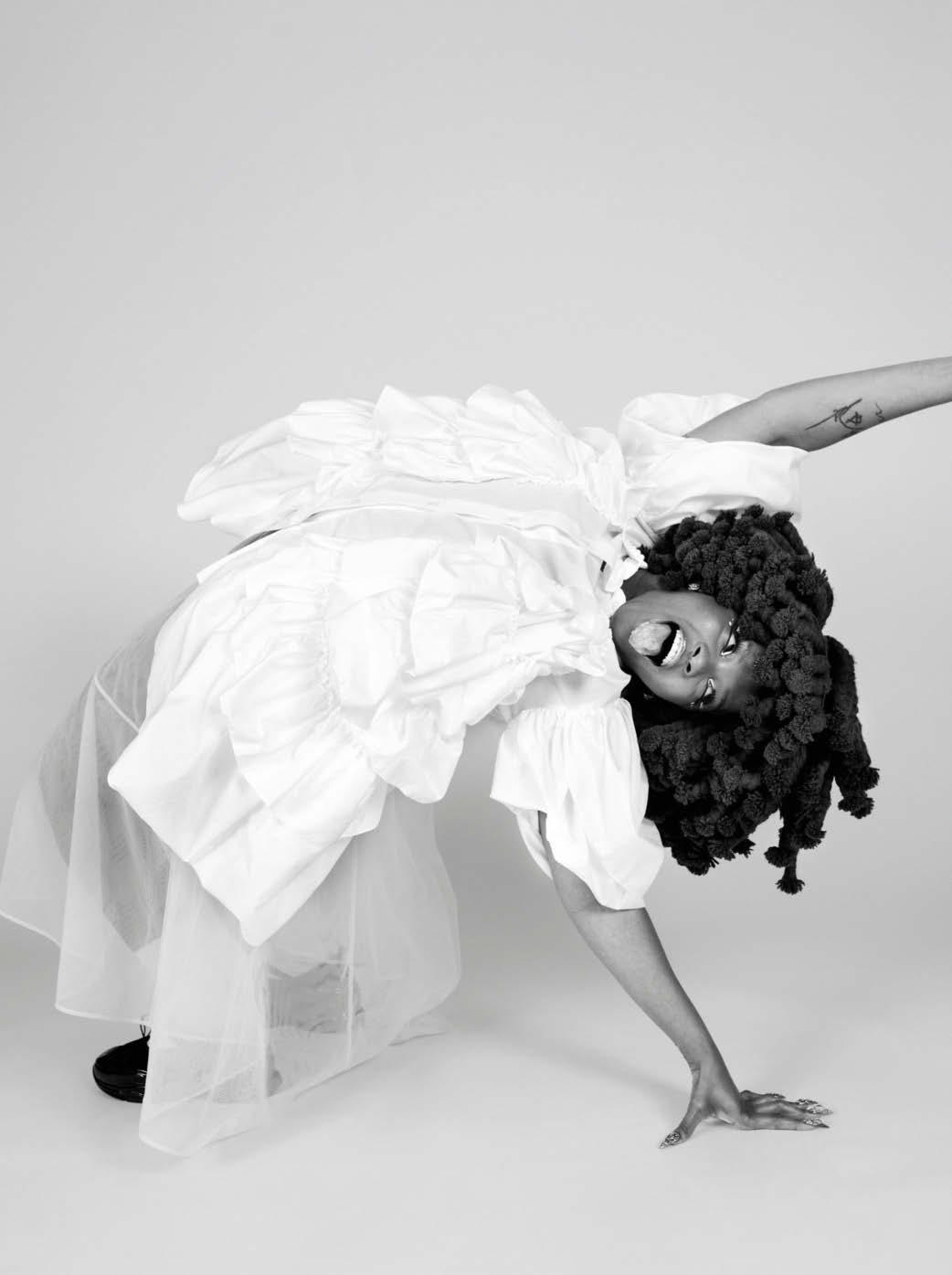
Full strength: “My mum taught me to shine, to never dilute my power,” Sanelly says
On the morning of her Red Bulletin cover shoot in London, the everenergetic Sanelly dances around the set with her talent manager, back-up dancer and friend Ashwin Abioye Bosman. She arrived in a long sheer gold dress with black underwear, and her signature braids bounce as she bounds about the studio, meeting the styling team.
Over the next few hours, Sanelly emerges from the dressing room in an array of incredible outfits, her energy and excitement only increasing as the day progresses. “This is your happy place!” a member of her team shouts across the studio floor teasingly as Sanelly expertly twists, twerks, bops and flirts in front of the camera, pausing only to crouch before the monitor occasionally and show her appreciation of the photographs being taken.
We’re here today in anticipation of the release of Sanelly’s third studio album, Full Moon, recorded with producer Johan Hugo (Mumford & Sons, Kano) and due out early next year. In addition to the energetic, dance-fuelled beats that have made her name, the new record presents a more personal, reflective and previously unseen side of the South African artist; her trademark mix of braggadocious bars and cheeky lyrics is accompanied by more introspective, thoughtful tracks.
“This album scared me,” Sanelly admits. “It freaked me the fuck out, the release of these feelings, finding the words for situations that happened on my journey. I allowed myself to go there, to feel. The words flooded out and I could finally express myself fearlessly.”
She’s referring to experiences stretching back to her early career and childhood. Sanelly was raised in Port Elizabeth – a city known officially as Gqeberha since 2021 – in South Africa’s Eastern Cape Province by her jazz-singer mother. “My mum taught me to shine, to never dilute my power,” she says. “She knew and loved a lot of different people, because she had a jazz club where they would gather. I grew up around all kinds of people. I knew about the criminals married to cops, the teachers who were in the closet… I knew them all.”
The youngest in her family, Sanelly’s early life was steeped in creativity. She saw her cousins and siblings succeed as kwaito dancers and hip-hop producers, so a life in the arts never seemed out of reach. “My mother never turned my dreams into hobbies,” Sanelly says. “I’ve realised over the past few years that I grew up with creative privilege. I was surrounded by colourful, artistic people, and I was told to ‘do you’ and trust in my creativity. If my

DJ MAPHORISA & SHIMZA
feat Moonchild Sanelly Makhe
Released in 2018, this gqom anthem cemented Sanelly’s presence on the South African house music scene. Don’t let the synth-led beat and dancefloor-based music video fool you – this track packs a powerful message about sexual assault and misogynistic culture.
BEYONCÉ
feat Moonchild Sanelly, Yemi Alade, Nija Charles, Tierra Whack, Busiswa Gqulu and DJ Lag My Power
Beyoncé recruited five incredible Black female voices (plus gqom producer DJ Lag) to work on this track for the soundtrack album The Lion King: The Gift. With its infectious beat and its lyrics about social awareness, empowerment and solidarity, the song celebrates the inherent power of Black women while drawing attention to the systems that want to take it away.
“I’m exactly where I belong. I’m a global superstar born in South Africa”
MAJOR LAZER
feat Moonchild Sanelly and Morena Leraba Hands Up
Hands Up appears on the Reloaded edition of Major Lazer’s 2020 album Music is the Weapon, which features a diverse, global mix of guest artists. The track is a club anthem combining Sanelly’s distinctive vocals with those of Lesotho rapper Leraba, plus solid production from Diplo.
GORILLAZ
feat Moonchild Sanelly With Love to an Ex
This ode to self-empowerment and independence perfectly blends the sonic worlds of Sanelly and Gorillaz (pictured). Telling the story of an ex who wants to reconnect, Sanelly’s verses promote the importance of selfsufficiency and of casting off stifling or unsupportive relationships from the past.
MOONCHILD SANELLY
feat Ghetts Strip Club
Released in 2022, Strip Club was Sanelly’s second team-up with rapper Ghetts; they first collaborated on his tune Mozambique, out the previous year. This booming track celebrates the strippers and twerkers hustling for survival: “Come to the strip club, come watch the girls dance, come give the girls cash…”
mother ever saw me walking behind a group of friends, she’d tell me, ‘No, you should always lead in whatever you do.’ She was a hustler, you know?”
Then, when Sanelly was 17, everything changed. Her mother died suddenly, and Sanelly’s home life became less supportive. Eventually, she decided to leave, moving to Durban on her own to pursue an education in fashion. “I ran away from home at 19 and never went back,” Sanelly says. “I’m not gonna cry about [my family] not supporting me, but they will never see me fall. It’s like, ‘Watch me now. I know that you’re watching.’”
Living alone in the coastal city while studying fashion design at Linea Academy, Sanelly found her place in the local hip-hop scene, performing slam poetry and supporting herself by making and selling clothes. Then, on the brink of a move to

“In my head, there’s always animation and a story happening”
Johannesburg, and with just £25 to her name, she found out she was pregnant. Sanelly made a decision: she’d continue to support herself and her daughter without giving up on her artistic ambitions.
She touches upon these experiences on her new record. Falling, an uncharacteristically gentle and contemplative track, allows the audience a rare glimpse of Sanelly’s vulnerability and uncertainty. “I’m scared of falling, scared of losing… Bitch, I know my family looking,” she sings. “‘It’s not my baby,’ that’s what he said. Kicked me out without a test. Had to find a house for kids, now I’m in it.” It’s a revealing song, and one that Sanelly says she’s proud to have created. “[Writing Falling] was a process,” she says. “It felt like part of the forgiving process, and I knew there was another process I had to go through still – one of letting go.”
Was it a challenge, then, to write and record songs this personal? Sanelly laughs at the idea, waving away the concept of writer’s block with her perfectly manicured fingers. “I’ll write a song right now!” she says. “I’m one of the fastest songwriters you will ever meet. I always find a way for the song to get done. I think it’s because I talk a lot of shit, and in my head there’s always animation and a story happening. My mind is always racing away with itself.”
Astand-out track on the new album is To Kill a Single Girl (Tequila), a song that highlights another important facet of Sanelly’s story: her sexually explicit public persona, and a passion for sex positivity. The track tells of a new relationship that has allowed her to transcend stereotypes: “I am so much more than sex,” she sings, “and he sees it.”
Sanelly is relaxed and open during our interview, which is all the more impressive given that in the past she’s been misquoted and vilified by the media for her sexual fluidity, and for advocating sexual liberation for all. In 2018, after she spoke in an interview about the need for safe-sex parties, it was claimed that she planned to open a brothel in South Africa. The news spread across the world, and Sanelly discovered that for the next year she was unable to take out loans or rent property in her home country. “It came from ignorance,” she says. “It was a journalist who wasn’t aware of sex parties and what they actually are.”
The truth of what Sanelly was saying was much more interesting. “I was talking about opening [sex parties] for the Black community,” she explains. “A space where no one cares about your body, shape, type or size, where you can walk around freely without being worried about someone touching you. A place where everyone recognises consent and permission. To me, the type of venues that are accepted by society – mainstream clubs – that’s where you disappear, that’s where you get [your drink] spiked, that’s where someone spanks you. So many people don’t know about these other spaces where you can actually exist safely as a vagina owner and no one bothers you.”
Though it cost her money and time, Sanelly hasn’t allowed the misinterpretation of her words

Eyes on the prize: Sanelly believes in the power of manifesting.
“Your words are your love letter to the universe,” she says.
“Just write your letter, put it out and use the right words, and everything else will come to you“

Ghetto superstar: Sanelly‘s ‘future ghetto-funk‘ sound, eye-catching personal style and sex-positive message have won her plaudits and admirers around the world
to stop her speaking openly about her belief in the need for such liberating spaces. “In these spaces, you choose what you want,” she says. “You’ve got the freedom. And I just needed my community to have access, to know about this stuff. Because I’ve always been the only young Black girl in these spaces, but I know there are other funky motherfuckers like me, man.”
While Sanelly was in Sweden recording the new album, she began trending back home – now quite a regular experience for the singer. “I wasn’t even there and I was trending in South Africa again for being a prostitute, a whore, whatever,” she says, rolling her eyes. “According to some South Africans, because of my homosexuality [Sanelly is sexually fluid and has dated men and woman in the past] I’m probably fucking someone to breathe.

“I’m not limited by labels. My storytelling
“It’s the fact that I own my body, I shake my ass, I do all those things,” she continues. “I know for a fact that if I attached my half-nakedness to tradition, it wouldn’t be viewed the same way. There are [other] people who shake their ass in South Africa, but because they attach to traditional music it’s allowed. Then I come through, just owning my body, and they can’t take it. So, I’m like, ‘Fuck you, motherfuckers. You guys are animals. I’m going to own it.’”
One of Sanelly’s most trusted tools when writing songs and chasing goals is manifesting – vocalising a specific outcome and asking the universe to provide it for you. It’s a technique she’s used her entire adult life. “I remember when I didn’t have money,” she says. “I’d run away from home, I was pregnant, and I only had my notebook. I started writing things like, ‘By the end of the day, I’ll have a custard slice.’ I realised that if I wrote something down, by the end of the day I’d always have it. I started paying attention to that and thinking on it. I was like, ‘Wait, what would happen if I wrote bigger?’ That’s when it started.”
Sanelly began making her manifestations more ambitious. She wrote that she wanted to release an album, that she wanted to be a global artist, that she wanted to work with Beyoncé, Diplo, and one of her favourite bands, Gorillaz. Suddenly, these statements started coming true. “Your words are your love letter to the universe,” Sanelly says. “Just write your letter, put it out and use the right words, and everything else will come to you. You speak with intention. You own everything that you want. Not everyone believes it, but fuck it. They all laughed when I said [I wanted to work with] Beyoncé. Now who’s laughing?”
Whether through manifesting or being an irresistible force of nature, Sanelly has already come a long way from where she started. With her new album, a European tour, and the world waiting with bated breath for her next move, she’s no longer a lone 19-year-old with no money, or a young mother chasing a dream. She’s a 39-year-old global pop star with three teenage daughters, a long list of accomplishments, and an even longer list of goals still to achieve. On the closing track of Full Moon, Sanelly meditates on the journey so far. “I was so young, in love, from home I ran, you took me in, for that I’m glad, so thanks,” she sings to her audience. “I put my hands in the sky, ’cause I’m proud of the girl that I’ve become.”
Of all her triumphs, Sanelly says that following her mother’s lesson to never dilute her power is her proudest – not just for herself, but for her three daughters. “If I died today I’d know that, through how I live my life, they have grown up seeing that their dreams are valid,” she says. “When I went to Jo’burg, I said, ‘I’m not just going to teach [my children] how to survive, I’m going to show them how I’m going to win in this thing, so that they know it’s all possible.’ Their entire existence was paid for through me living my dreams. And no one can convince them otherwise, because it’s not a dream any more, it’s real life.”
Instagram: @moonchildsanelly
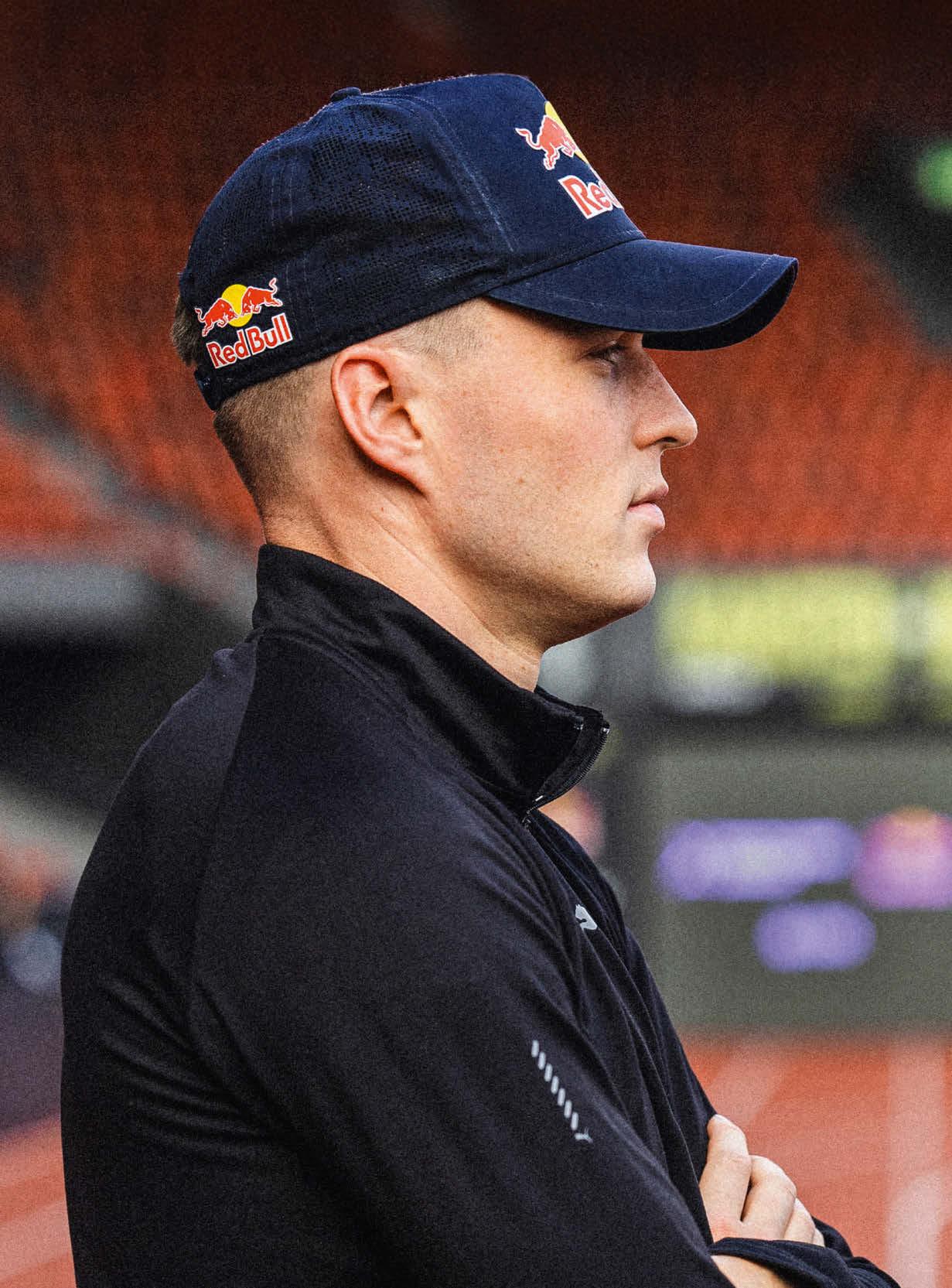
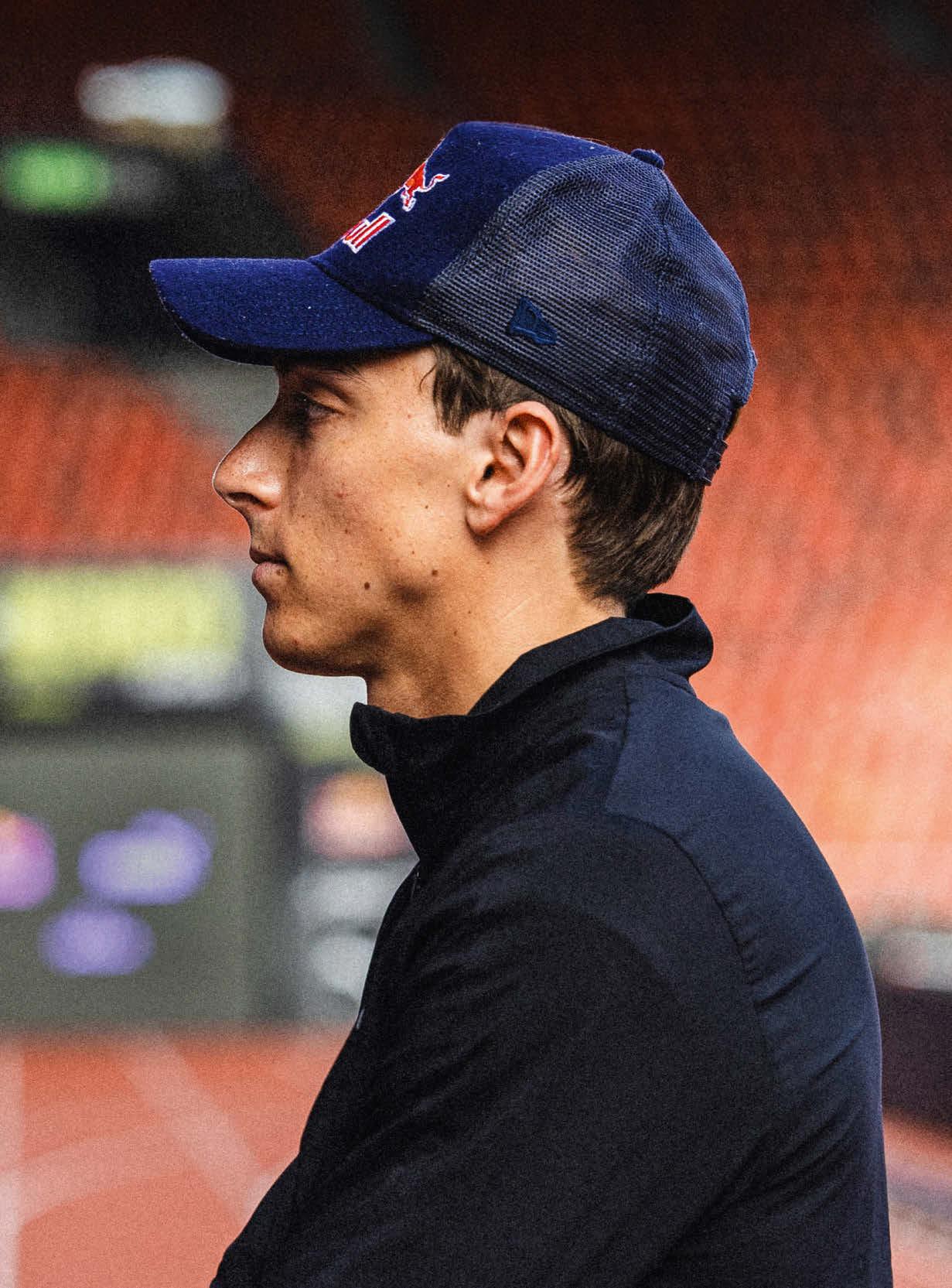
Two of this generation’s greatest athletes – Mondo Duplantis and Karsten Warholm – in a 100m sprint duel? This is the story of how one of the year’s most unexpected, unpredictable and talked-about sporting events took place
It began with an overheard conversation at a World Athletics meet.
Or, as is the way, with a clip of it shared on social media by a fan. Featuring two sporting superstars casually spitballing, the moment was assured online clout. What the poster couldn’t have foreseen was the chain reaction it would ignite.
Here’s how the 60-second clip unfolds. Ahead of the Monaco Diamond League in July 2023, Sweden’s Mondo Duplantis – at that point world and Olympic pole-vaulting champion, with six consecutive world records to his name – is practising sprints with Norway’s Karsten Warholm, the world’s fastest 400m hurdler. Someone suggests they should do a 100m race…
“I’d like to,” muses Duplantis.
“Yeah?” says Warholm, surprised. “We could, but we should schedule a time. When it’s safe for both of us. Not here.”
“Not here,” repeats Duplantis.
“I’ll give you a pair of the spikes I use,” says Warholm, asserting himself, “so you don’t have any excuses.”
“Yeah, it’s gotta be fair, bro. You’ve got these juiced-up kicks,” says Duplantis, slyly examining Warholm’s fire-orange Puma running shoes. “I’m not saying I’m going to kick your ass, but I can give you a run for your money.”
“It’d be more embarrassing for me if you beat me,” considers Warholm. Both men are fidgeting, posturing. “I’ve got everything to lose.”
That day, Warholm went on to win his 400m hurdles competition, a Diamond League record. Duplantis, in a shock result, finished fourth, only his third nonvictory in four years. “He seemed slightly out of sorts,” a post-event report noted. Both athletes clearly had more important things to focus on. Until, that is, a press conference at the Zurich Diamond League five weeks later.
“Question for Karsten and Mondo,” calls out a reporter. “Before the Monaco meet, there was a clip on social media where you guys talked about a 100m showdown. Is this ever going to happen?”
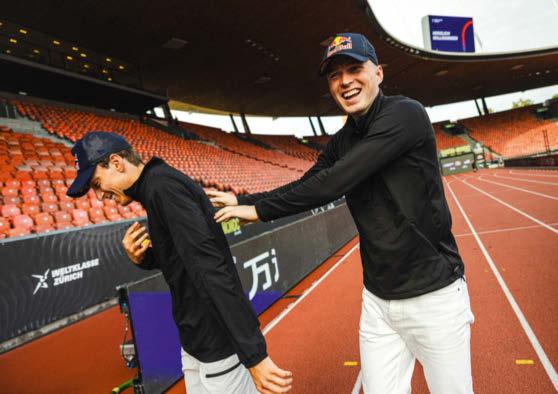
Both athletes shift in their seats. Duplantis shrugs. “I don’t know. It’s something I’d like to do…”
“I’m mixed about it,” says Warholm. “People probably think that I can run super-fast. But I don’t think I’ll see the number nine [as in under 10 seconds] on the clock.”
“I hope not,” exclaims Duplantis.
“It’d be a great match-up,” continues Warholm. “The only thing I want is for it to be when we can do it good. But both of us are down. We’re not guys to dodge the competition, no?” He glances at Duplantis.
“No,” agrees Duplantis. “But I will say this: he’s being a bit diplomatic right now. When I first suggested it to him, he blew me off a little. Now he’s on the mic, acting like it would be a great competition.”
“I wouldn’t accept if I thought I was going to embarrass you,” says Warholm.
“I’m aware that I’m going into this a bit of an underdog” Mondo Duplantis
“You’d never challenge me if you didn’t think you had a fair chance of winning.”
American six-time world-champion sprinter (and, following the 2024 Olympics, the world’s fastest active 100m sprinter) Noah Lyles, who has been sitting silently next to them, can no longer contain himself. “Just say you’re better than him,” he directs at Warholm. “Oh my gosh, all this twinkle-toeing around.”
Having drawn himself into the fray, Lyles is asked for his prediction. “I’m going to put my money on Karsten – you know how to use [starting] blocks,” he says, placing his hand on Warholm’s shoulder before pointing at Duplantis. “I’ve never seen you in blocks.”
“I’m aware that going into the race I’m a bit of an underdog,” concedes Duplantis. “But I think I’m going to surprise people.”
“It’s gonna happen,” says Warholm. The stage was set. Then… nothing.
Twelve months is a long time in sport. In September 2023, just 18 days after the Zurich press conference, Duplantis broke the world record again, clearing the bar at 6.23m. In April 2024, in Xiamen, China, he did it once more. In three vaults at the Paris Olympics this August, he first took gold, then the Olympic record, then another world record. Just 20 days later, at the Silesia Diamond League in Poland, he pushed it a centimetre further: 6.26m. Three world records in one season, his 10th in four-and-
Running hot: the athletes warm up ahead of the race. Duplantis (right) dedicated his training on block starts following the Olympics; Warholm (below) sprint-trains as part of his hurdles routine. Opposite: the two are good friends, believe it or not



Two tribes: among the thousands of ticketbuying spectators on the night, there was a sense Duplantis was the favourite. Below: Warholm enters the arena. His first words: “Shit is getting real”
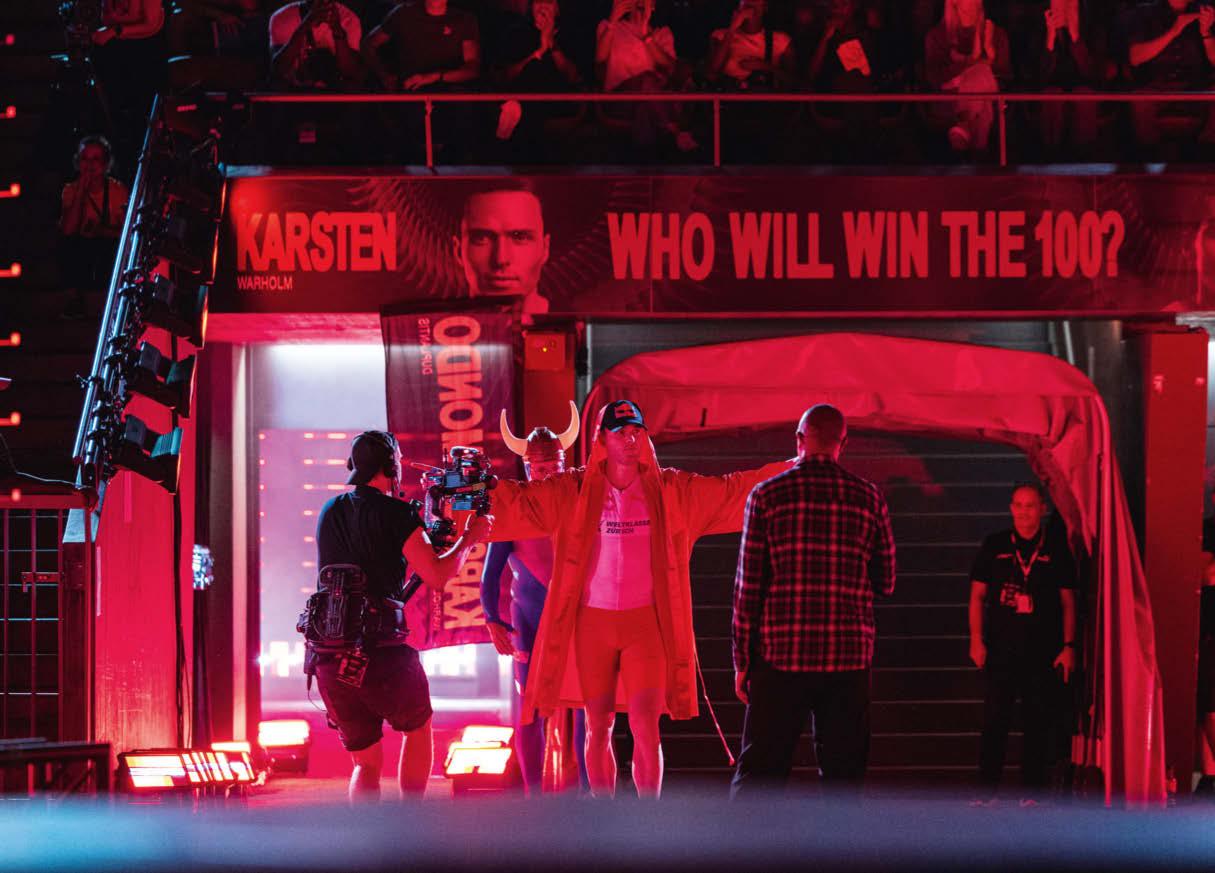
a-half years – Duplantis was literally soaring. “I know I can go higher,” he remarked. “I’d like to jump over 6.30m.”
For Warholm, it was a different story. Just days before that 2023 Zurich press conference, he’d claimed his third world championship. He followed this with gold at this year’s European Championships. Then came tantalising silvers in Oslo and Monaco, pipped to the finish each time by hundredths of a second. Going into Paris, the Norwegian was under pressure.
In Tokyo, four years earlier, Warholm had elatedly ripped his shirt open after taking gold, shattering the 46-second barrier at 45.94s and breaking his own record by 0.76s to achieve the fastest 400m hurdles run in history. But at the Stade de France it wasn’t to be. American Rai Benjamin, beaten by Warholm in Tokyo, exacted revenge. “Rai did a great job,” said Warholm afterwards. “Everybody does what they can to be the better man on the day. Today that was him.”
Amid all the drama, a certain wager seemed, understandably, to have been forgotten. Then, three days after the Olympics, Warholm posted a message to his Instagram: “A battle for the ages. 100m to settle it all @mondo_duplantis!”
Duplantis replied with a simple “LFG”. Let’s fucking go.
The Stadion Letzigrund in Zurich has borne witness to some of the greatest moments in sprinting history. At this stadium in 1960, Germany’s Armin Hary became the first person to run 100m in 10 seconds; in 1984 America’s Evelyn Ashford clocked 10.76s to become the fastest woman on Earth; Carl Lewis achieved a world record of 9.93s in 1988; and Jamaica’s Asafa Powell did it in 9.77s in 2006. It was also here, in August 2023, that the deal-sealing conference between Duplantis and Warholm took place. And this was where the match-up would happen, a year later, on September 4, 2024.
With the race taking place just hours ahead of the Zurich Diamond League, both athletes would also compete in their own events the following day. This begs the question: why would the greatest pole vaulter of all time and the man who redefined the upper limits of hurdling even consider doing a 100m sprint?
“People forget I was doing the decathlon before,” says Warholm of the multi-disciplinary event that includes the 100m. The Norwegian competed in it until 2016, when he switched to the 400m hurdles, becoming world champion the next year. Warholm’s last recorded

Shoe-in for the win: in the end, Duplantis didn’t wear a pair of his rival’s spikes. “I kept waiting for Karsten to send me some,” he joked
100m race was in 2017, aged 21, when he clocked 10.49s.
Noah Lyles may have never seen Duplantis on starting blocks, but the Swedish-American has form with them. Growing up in Lafayette, Louisiana – his father is an American former pole vaulter, his mother a Swedish former heptathlete and volleyball player – Duplantis’ 100m personal best came at the age of 18, at a high-school regional championship where he also competed in the pole vault. “I wanted to save my legs for the 100m,” he said at the time, but that didn’t stop him winning the vault. He then stormed to victory in the sprint with a time of 10.57s.
“I’m not a real 100m runner; I only did it a couple of times,” Duplantis says today. “It’s not my event. But I do enough sprint training to put myself in the conversation.”
In the run-up to the race, both athletes began practising in their home territories – Duplantis in Uppsala, Sweden; Warholm in Oslo. The latter’s Instagram followers might believe his regime involves running shirtless in the sub-zero Norwegian winter and chopping logs in the snow. In truth,
“Losing would embarrass me the most”
Karsten Warholm
it’s a taut schedule that includes three intense days of weightlifting, plyometrics (jump training) and sprints.
“My training is very much sprintfocused,” he says. “And my coach is one of the best – if not the best – sprint coaches I know.” This would be Leif Olav Alnes, the 67-year-old former sprinter who convinced Warholm that hurdles was his calling, and whom Warholm in turn lured away from retirement with the promise of coaching glory. Their relationship is more best friends than mentor-student. “Leif has this thing he says: ‘Speed cannot be forced,’” says Warholm. “You either have it or you don’t. [Mondo] is probably underestimating that I train sprints at a high level.”
“I think Karsten’s sleeping on the fact that I’m fast,” counters Duplantis. “I do more sprint training than people know.”
Duplantis’ coaches are his mother Helena (strength and conditioning) and his father Greg (technical coaching), who achieved a personal best of 5.80m in his career. “We’re a pole-vaulting family,” says Duplantis in his documentary The Next Centimeter, released ahead of the Olympics this year. Greg also appears in the film, summarising the needs of a pole vaulter succinctly: “You have to be a sprinter, a long jumper and a gymnast.”
To audiences wowed by the spectacle of pole vault, the run-up is perhaps an underappreciated component. The faster the sprint, the more energy is transferred into the pole when it enters the box, directly translating into the momentum needed to propel the vaulter. “Speed
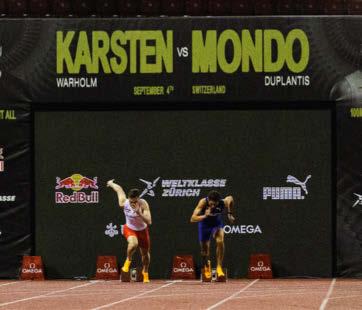
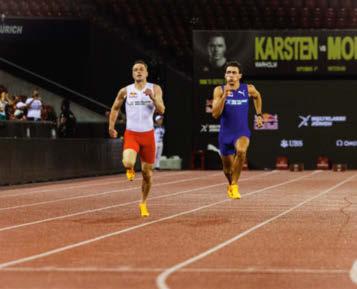
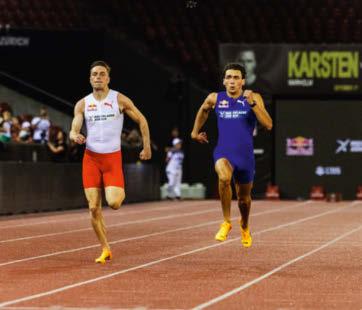

Gone in 10 seconds: even though Warholm clocks a higher top speed, Duplantis’ acceleration proves the decisive edge in a race separated by a mere 10th of a second
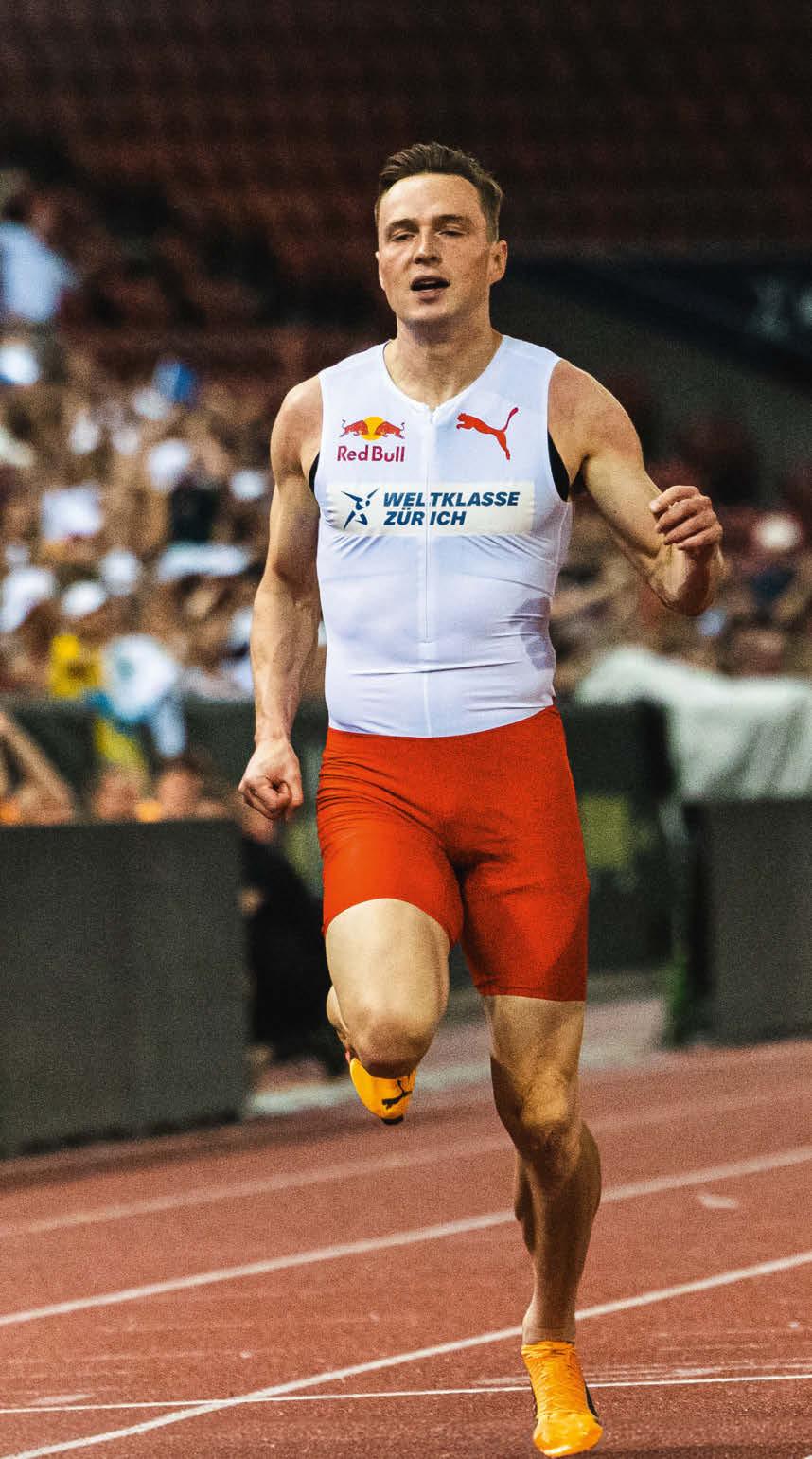

“Neither of us likes to lose. We’re similar in a lot of ways”
Mondo Duplantis


AGE 24 28
3 2 2 10 78
OLYMPIC MEDALS
Three days: sprint sessions. One day: jumping. Practised block starts with Fred Kerley. Doesn’t like lifting weights
Famously doesn’t eat his vegetables. Enjoys fried chicken: “I’m from Louisiana!” he argues
TRAINING
Three intense days (10am to 7pm): sprints, hurdles, weights, jumps. Three moderate days: interval work.
Recovery day: hot tub, building Lego
DIET
Breakfast: bread, eggs and yogurt, coffee and milk. Lunch: a sandwich. Dinner: meat or fish
equals height,” American pole vaulter KC Lightfoot – ranked fourth in the all-time list behind Duplantis – told the New York Times in June this year. “[And Mondo] is faster than all of us by quite a bit.”
In a typical training week, Duplantis limits himself to a day of jumps – partly due to the toll on the body, but also because his technical base is so good. However, he does sprint sessions three times a week. “I do blocks, though probably not to the extent [Karsten] does,” he says. As such, he enlisted the help of US former 100m world champion Fred Kerley.
“We’ve been doing blocks to fix some speed,” Duplantis says. “The first 50m are the most crucial – I need to get him in that section. Since the Olympics, other than in competitions, I haven’t touched a pole, just blocks. I’m a lot more explosive than the last time I ran the 100m.”
As the day approached, there was one thing still to weigh up: what exactly was at stake in a sprint showdown between an athlete who ran the 400m hurdles in Tokyo faster than 18 runners in the men’s 400m without hurdles, and a pole vaulter who’s achieved the top 10 highest jumps of all time?
“Pride and reputation – for an athlete with a big ego, that’s probably the most we can put on the line,” confesses Warholm.
“I mentioned the idea of the loser having to wear the other’s jersey in our normal competition the next day,” laughs Duplantis. “There’s rivalry between Norway and Sweden, but more of a brotherly rivalry. It wouldn’t hurt me to wear the Norwegian jersey, but I wouldn’t want to do it. I hope he’s the one wearing the Swedish kit.”
“There will be nerves – there’s always nerves when I compete,” admits Warholm. “But that’s because it means a lot to me. Mondo is going to be nervous, for sure.”
“I’m pretty good at channelling nerves to my advantage,” says Duplants. “This is different, though. Karsten shows up when he needs to. He doesn’t like losing. But I don’t, either. We’re similar in a lot of ways.”
“Once the gun goes off, everything is instinct,” explains Warholm. “It’s around 10 seconds – there’s no time to think, just to execute. You need to get it right first time.”
“It’s all about foot speed – who is the fastest guy?” says Duplantis. “That’s what makes the 100 metres so beautifully simple. I don’t think there’s anything more primal than racing somebody. Since I was a kid, that was the best feeling. I’ve been in the most intense moments my sport can give, but there’s nothing like those moments right before and after the gun goes off.”
And with that, all that was left was for the race to commence.
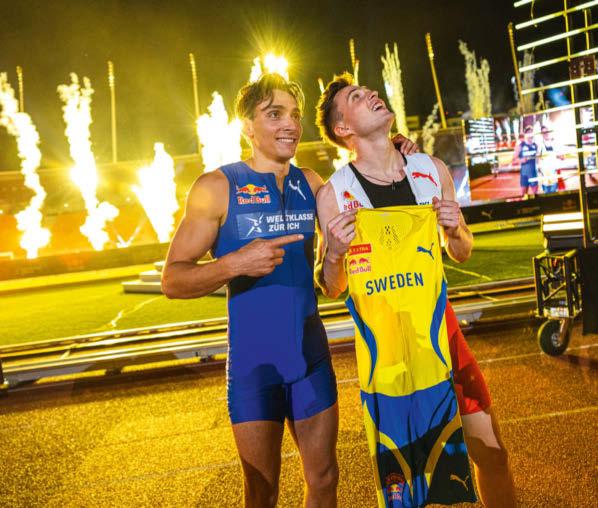
It’s a balmy 23°C in the Stadion Letzigrund as floodlights illuminate thousands of cheering spectators, many of them pro athletes enjoying a late-night show ahead of their own events the next day. The atmosphere is more akin to a boxing match than a running race.
To an orchestral fanfare of Norwegian composer Edvard Grieg’s In the Hall of the Mountain King, Warholm emerges with his coach, Leif Olav Alnes. The former is in a red silk robe, the latter in Viking horns and a skintight speedsuit emblazoned with the words ‘Fat by choice’. “The ‘s’ fell off,” clarifies Alnes. “It’s ‘fast by choice’.”
Duplantis enters next, wearing blue, to the hip-hop beats of Derek Minor’s Lunchtime. He has an entourage of world-champion sprinters in tow: Vernon Norwood, Sha’Carri Richardson, Letsile Tebogo and Fred Kerley. “I brought speed with me,” states Duplantis.
“This is not a popularity contest; it’s a 100m race,” says Warholm, “and I’ve got the best man on my team.” He and Alnes smile warmly at each other.
They remove their robes and set up their blocks. Warholm slaps his shoulders and chest and performs jumping jacks. Mondo stands silent, closing his eyes in contemplation. Both athletes now look nervous. They take their starting positions. “Set…” the announcer calls. They arch their backs. The gun fires.
Both launch forward, Duplantis a whisker faster. Predictions about his acceleration are on the money as he pulls ahead. It’s over as quickly as it begins. Duplantis glances over his shoulder before crossing the line first. His time: 10.37s. The crowd roars as he points gun fingers in the air and mouths the sound of shots fired.
“I’ve got to give it to Mondo,” says Warholm as photographers swarm around them. “He beat me fair and square. Congrats, man.”
“This feels really good, and tomorrow it’s going to feel even better,” says Duplantis, pressing a speedsuit in Sweden’s colours against his friend and rival’s chest. “It’s all yours, brother.”
“Fuck, fuck, fuck,” says Warholm on live TV. And as fireworks fill the sky, the two embrace, grinning.
Watch the replay of 100m to Settle it All on Red Bull TV; redbull.tv
Once the embodiment of antiauthoritarian rebelliousness, skateboarding has in recent years become a globally recognised sport and is even entering the school curriculum. While purists despaired, a tenacious group of Finnish skate punks known as the Ramp Dogs saw opportunity...
Words Alex King Photography Ossi Piispanen


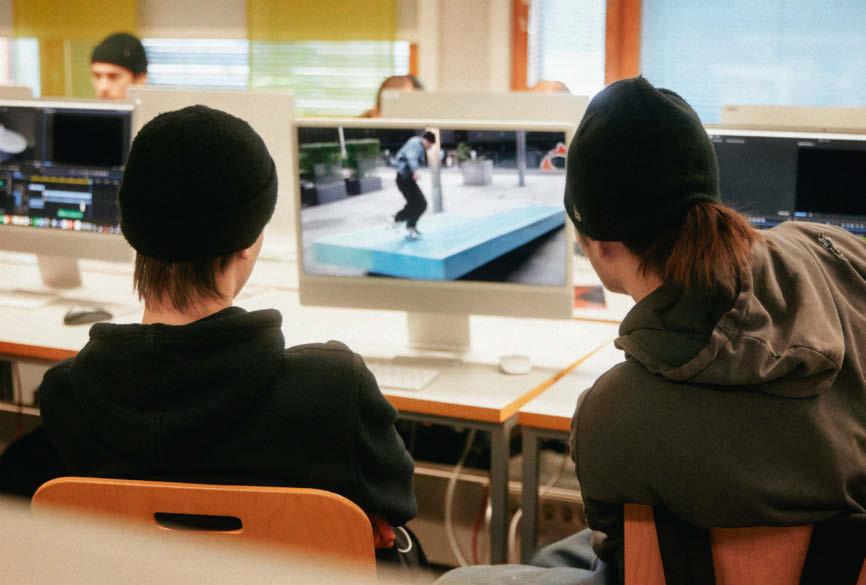
In a classroom in Finland, rows of computers are lined up and blinds pulled down to shield students from the light reflecting off the packed snow outside. A group of teenage boys wearing beanies, hoodies and chains huddle around a monitor, laughing and teasing each other as they assemble clips of themselves skateboarding – and bailing. When their teacher, Vantte Lindevall, gets up to investigate the commotion, he doesn’t give them a telling-off. Instead, he views the sequence and suggests a couple of edits.
“I try to teach them that a skate film can be anything,” Lindevall explains later. “There are no limits, no rules. I encourage them to be more artistic or experimental. It’s about inspiring self-expression.”
Since 2021, skateboarding has been part of the curriculum at Sampo Central Upper Secondary, aka SAMKE, a specialist sports and communication school for 16-to-18-year-olds in Finland’s second city, Tampere. And it’s not a unique case: Sweden opened its first ‘skate school’ in 2006, and in April this year it was announced that skateboarding will be an option for the physical education GCSE in Wales from 2026.
For some purists, however, skateboarding’s arrival in the classroom is a vision of hell. With skate and state now working together, and skateboarding having returned to the Olympics this summer, there’s a fear that the ultimate outsider subculture could become everything it once railed against, losing its uniquely rebellious and independent energy in the process.
This is an issue that’s being tackled head-on in Tampere, Finland’s skate capital. The high-school programme adds weight to the city’s boast of having the best skateboarding infrastructure in the country, from DIY spots to Olympic-standard facilities. But this isn’t the vision of suit-wearing officials; it was grassroots pressure from local skaters that convinced those in power to collaborate.
For more than a decade, a tenacious group of skate punks known as Kaarikoirat – or Ramp Dogs – have been pushing for progress. They’ve spent hundreds of thousands of Euros of public money building and managing skateparks in Tampere’s disused and neglected spaces. Now, as skateboarding becomes so acceptable it’s part of the curriculum, the challenge for the Ramp Dogs – and skating in a broader sense – is how to work with officialdom while retaining the countercultural energy their sport was built upon. When skating goes mainstream, is it really possible to keep things real?
To skate in Finland, you have to be tough. This isn’t Southern California with its year-round sun and smooth concrete. Snow-covered ground and subzero temperatures make street skating impossible for approximately half of the year, so in Tampere the sport has ebbed and flowed with the seasons. With nowhere to skate in winter, the summer influx of skateboarders would disappear, leaving only a dedicated and determined few. Then, in 2010, an unruly group of these core skaters came together
United skate: (this page) students at SAMKE; (right, top) the Musta Pispala punk festival at Tikkutehdas, an old matchstick factory with its own skatepark; (bottom) Ville Natunen at one of the last skate sessions at Tikkutehdas DIY before its demolition


“Skating had no spokesperson. But we didn’t just sit and complain”

to build an illegal DIY skate park in the ruins of an old matchstick factory, a graffiti-strewn red-brick building that had almost been swallowed up by the surrounding forest.
“When me and my friend Ville [Altonen] first saw inside [the abandoned factory], we knew it would be perfect,” explains Niklas Pedersen, 39, now Kaarikoirat’s vice president. “The flat ground was so smooth, and the location was close to the city centre but pretty hidden.”
None of these skaters had any construction experience, but each day more young people –many of whom had never showed up for anything in the past – began lending a hand. And as the build team grew, so did their ambitions. “We basically knew nothing and had terrible tools, but the build process was a lot of fun,” Pedersen says. “We put our own money in at first, then we got more by returning all the beer bottles that people had left around [the place]. Finally, a small grant let us do concrete pours – the first attempts were pretty terrible but still skateable. And we learnt so much in the process.”
Following the initial discovery in 2009, construction took place in phases, with more than 20 skaters involved at its peak, many of them grateful for the distraction from the harsh reality of
everyday life in the post-industrial city. “I have so many friends who are stuck,” Ville Natunen, now aged 33, said in 2019. “They’re unemployed, they get passive and depressed… Eventually, they stop believing they can do anything. Personally, I just wanted to skate. But I also had all this energy, and a desire to build something.”
Tikkutehdas DIY was threatened with destruction from the beginning, though Kaarikoirat were able to resist for a few years. The space ultimately suffered a fate that will be familiar to builders of illegal skate spots around the world – it was torn down when the area was redeveloped in 2018. But the creation of Tikkutehdas DIY had given birth to something more enduring: this tight-knit community of Ramp Dogs, determined to create more space for skate culture in Tampere. “In the beginning, there was no contact with the city’s decision makers,” says Teemu Grönlund, a founding member of Kaarikoirat. “Skateboarding had no spokesperson. But we didn’t sit around and complain; we worked hard, by hand, to make our dreams come true.”
Now aged 38, Grönlund is the godfather of skateboarding in Tampere. The Finn combines a laid-back and welcoming vibe with an overactive mind that never seems to switch off. Grönlund always dreamt of a permanent indoor space that would allow skateboarding to develop without constraints; one where he and the other Ramp Dogs would have access to the very best bowls, ramps and transitions.
It’s largely thanks to Grönlund and his force of will that skaters in Tampere got organised. Although attempts to save Tikkutehdas DIY were ultimately unsuccessful, they gave birth to a radical new approach. In 2012, this group of 20 skaters registered Kaarikoirat as an organisation and began forcing skateboarding infrastructure onto the city’s agenda. These tattooed, board-carrying representatives of the local skate scene caused quite a stir when they began turning up at Tampere City Hall, but they soon started to work out how to use its official democratic processes to get their voices heard. After endless meetings and proposals, Kaarikoirat advised the city on the construction of Iso-Vilunen, which, when it was completed in 2015, became the biggest outdoor concrete skatepark in Finland. But the group weren’t content just sitting on the sidelines.
“We’re not just skateboarders; we’ve been inspired by the deep heritage of DIY culture, and we want to build,” says Grönlund of the ethos that continues to drive Kaarikoirat today. “We don’t want to just wait for the city; we want to get our
“In Finland, people understand sport. They’ll back you”
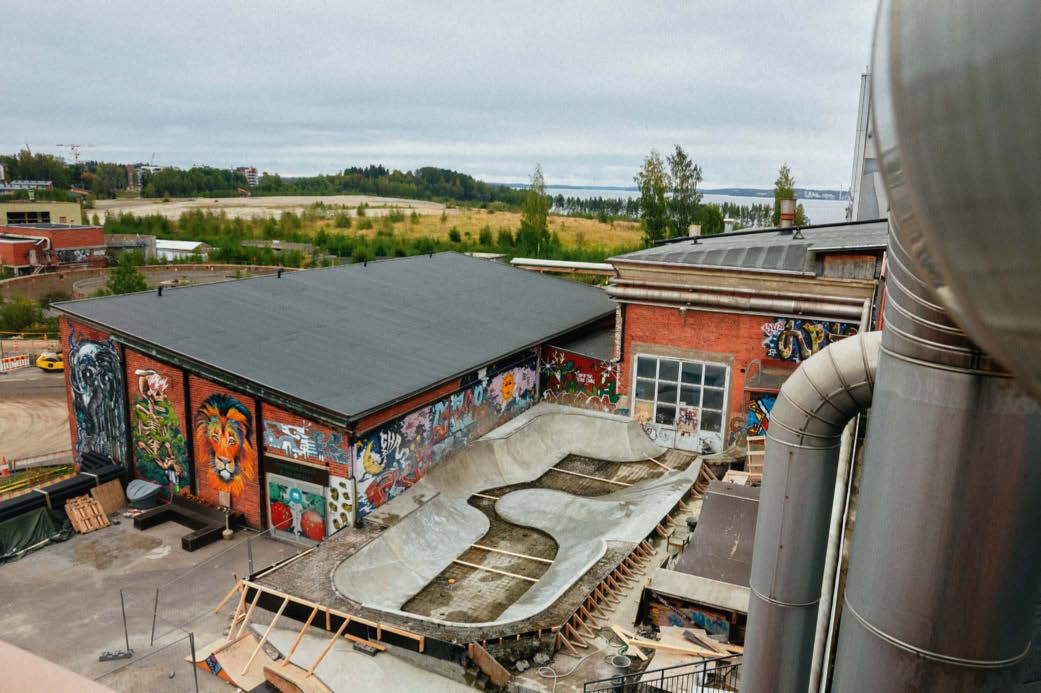
hands dirty and take an active role in creating what we want to see. From the very beginning, it was really important for us to preserve our autonomy, so we’ve had to push back against the city’s instinct to control. If we let the city manage these spaces, they’re so risk-averse that nothing would happen. It would all wither and die, which is what we’ve seen in other cities and are determined to avoid.”
After years of building trust with the city, in 2016 Kaarikoirat were handed the keys to a 480sq-m former factory next to Tampere’s largest lake, Näsijärvi. The area, Hiedanranta, was once the centre of a major forestry industry, but its buildings had sat empty, slowly decaying, before the city came up with an ambitious redevelopment plan. Kaarikoirat required a building to house their ramp dreams, and the city needed people to re-energise the area. A true partnership was born.
Nordic countries’ biggest skateboarding events, which attracts professional skaters from across Europe, plus thousands of others who come to skate and party.
The original Kaarikoirat crew ballooned into a movement that attracted skateboarders from across Tampere and further afield. The Ramp Dogs had proved they could do the impossible, enjoying the best skate facilities they’d ever had while, at the same time, never relinquishing control or losing their raw DIY energy.
Building a legacy: (this page) Kenneli DIY’s outside extension being constructed in 2019; (opposite) Kaarikoirat founding member Teemu Grönlund
With the local unemployment programme covering salaries, the Ramp Dogs went to work on an enormous indoor concrete bowl, Kenneli DIY. They also took over other parts of the building to create a street course and host a wide range of cultural events. This included everything from music festivals – giving Tampere’s impressive roster of punk and psychedelic rock bands the chance to raise the roof – to Trelogy, one of the
Heini Luotola, one of Finland’s top female pro skaters, decided to make the move to Tampere in 2019 thanks to the Ramp Dogs. “I moved here from Jyväskylä after the indoor skate park I’d been working at for the last 10 years was torn down by the city,” Luotola says. “The scene in Tampere was really active; they were getting more done than anyone anywhere else in the country.”
Luotola, who has won eight golds at the Finnish national championships, quickly became a core member of Kaarikoirat and has been involved in each building project – roughly one a year – ever since. “I took part in the Kenneli DIY ‘Builder’s Jam’ in 2017 because I wanted to learn more about how to build transitions,” she says. “I remember such a strong feeling of community coming together to
Pushing forward:
Jussi ‘Kärä’ Korhonen, Ramp Dogs legend and coach for a new generation of vert skaters in Finland; (below) Mans-e-rama skate and music festival, 2019


on
Mikko ‘Kymis’ Kymäläinen skates the deep end of the Iso-Vilunen bowl. Kymis won the Finnish Championship on the same day and came fourth in the international (open series) competition at Mans-e-rama in 2019

“We’re not just skateboarders; we’re inspired by DIY culture”
build something that we all wanted, which had never existed in Finland before.”
Then, as Kaarikoirat were mastering the art of harnessing the city’s official processes, a huge bargaining chip landed: the Olympics.
The announcement that skateboarding would be included in the Tokyo 2020 Olympics sparked debate, some of it heated. Is skateboarding a sport? A countercultural way of life? An art form? One thing is for sure: skateboarding’s growing status has led cities around the world to embrace what was, for decades, considered by some to be an urban menace and something to be discouraged.
“In Finland, people understand sport,” Grönlund says. “If you get an Olympic medal, everyone backs you. That’s why we have ski-jumping towers in every Finnish town, even though you never see anybody jumping down them. The Olympics are a divisive topic, but we were cheering for [Finnish-American skater] Lizzie Armanto to win a medal in 2020 –that would have really helped us finally get proper funding for skateboarding in Finland. And we were all behind Heili [Sirvio] to go for gold this year.”
When Finnish skaters were selected for the Olympics, Kaarikoirat saw an opportunity. Tampere
now has the best year-round Park facilities for skaters such as Sirvio, the 13-year-old Finnish-Australian wunderkind. When she took part in Kaarikoirat’s Mans-e-rama skate and music festival in July this year, Sirvio landed countless McTwists at Muovitehdas, Kaarikoirat’s newest space, built in an old plastics factory in Hiedenranta and boasting the only ramp in Finland where it’s possible to pull off this acrobatic trick.
Grönlund explains that the Ramp Dogs built and now run all this not to cultivate the next generation of Olympians but because they want the very best facilities to skate themselves. “We used Olympic selection to help win over the most resistant council officers, [the ones] who always questioned why they should invest in skateboarding,” he says.
Kaarikoirat were able to prove they can engage hard-to-reach young people and be an ally to the city in achieving its own objectives, from increasing civic participation to urban regeneration and reducing youth unemployment. As Finland battles with an aging population and rural decline, the Tampere city region continues to be the fastestgrowing urban area in Finland.
Thanks in part to the Olympics, but more so their own persistence and organisation, skateboarders in Tampere had broken into the corridors of power and forced politicians to heavily invest in skating
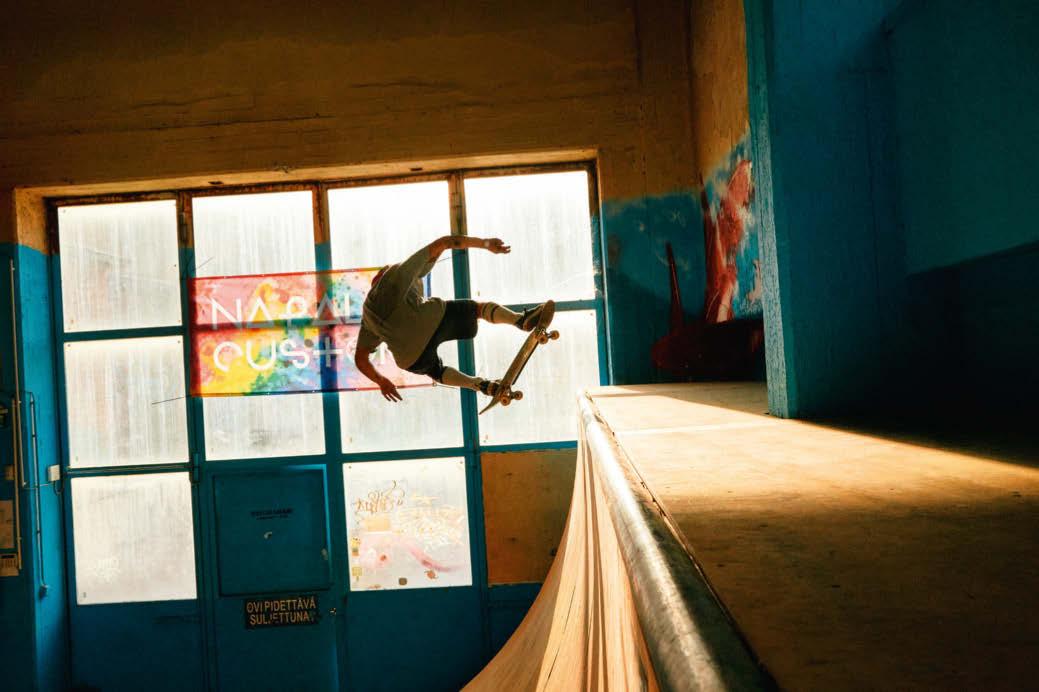

“This journey made us start loving the city”
– and the wider youth culture that surrounds it –while fighting to retain the essence of the scene they fell in love with.
But, as the scene in Tampere has grown, it’s become clear that some aspects of traditional skateboarding culture aren’t worth preserving.
All inclusive: (this page)
Tampere skater
Tiina Santamo at Muovitehdas; (opposite) this ’80s-style vert was built by Kaarikoirat in 2015 for a hiphop festival and was designed in pieces so it could be moved and reused
Skateboarding has long considered itself progressive, a place that welcomes misfits who don’t conform with mainstream society. But in recent years it has been forced to take a long, hard look at itself. It was 2016 before New York City-based skater Brian Anderson came out as gay – the first pro to do so – which sparked a long-overdue discussion of rampant homophobia in the sport.
And in the debate about skateboarding in the Olympics, one aspect that’s often overlooked is the effect that its introduction has had on gender equality in what has always been a very maledominated scene. Competing on an equal footing, there are identical Park and Street events for both men and women. In fact, Finland’s only Tokyo 2020
skateboarding entry was Lizzie Armanto, who finished 14th in Women’s Park. After being shunned by sponsors for decades, big brands rushed in to sign female skateboarders bound for the Olympics.
Things are changing in Tampere as everywhere else. But not quickly enough for some. Kaija Papu, who is non-binary queer, spent years attempting to develop the skate scene in Tampere for women, non-binary and LGBTQ+ people. But Papu, now 44, grew sick of all the pushback and the arguments. “When I started skating in 2004, skateboarders were the outsiders – but they were not friendly to other outsiders,” Papu explains, surrounded by artwork at their flat-cum-tattoo-studio. “You could only be a certain type of skater to be part of the community. A lot of skaters see themselves as beaten down but don’t realise they’re actually part of the problem, beating down on the queers and women in their own scene.”
Papu eventually abandoned skateboarding for climbing, where they felt welcome, and were happy to turn their back on the misogyny and homophobia they had endured in the skate world. Now, the recent cultural shift that has massively boosted participation and visibility for women and LGBTQ+ people in skateboarding is being driven forward in Tampere by skaters such as Tiina Santamo.
Over at the cavernous Muovitehdas, Santamo, who is Grönlund’s partner, is just finishing a session. The 40-year-old is the organiser of Tytöt Shreddaa (Girls Shred), a one-day skate festival for women and marginalised genders that takes place in a few weeks, part of a diversity push coming from Kaarikoirat and other skaters rather than being imposed by the city.
“I got into skateboarding really late, mainly ’cause I never thought it was possible for me,” Santamo says. “During COVID, I saw one of my friends on Instagram and asked to join her. We went to Kenneli [DIY] in the summer, and I skated till, like, 2-3am – I was hooked instantly. I realised there were a lot of other grownass-women who’d just started to skate, so we asked Kaarikoirat for our own private session, and it grew quickly from there. Having that protected space for us helped overcome a lot of mental barriers I’d built up.”
Heini Luotola also recognises skateparks can be intimidating spaces for novices. She’s at Muovitehdas preparing to teach a junior skate-school session with fellow coach Ahto Sorvali as a mixed group of groms wait noisily to start. “We realised the need for specialised sessions,” Luotola says. “We have the safe-space guidelines on the walls. Respecting everyone should be the default, but unfortunately there are lots of incidents where we have to intervene. We want this to be a safe space for everyone. We’re not there yet, but we’re working on it.”
There are only two women among the 16 students on the high-school skate programme, an indication of how far skating still has to go to move beyond a maledominated ‘bro’ culture. Grönlund admits Kaarikoirat could have done more to temper the skate-bro energy in the past, and as the Ramp Dogs grew from a group of like-minded friends to become a major cultural force in Tampere, they realised they had work to do. Transgender skater Enni Kalinainen drafted Finland’s first safe-space guidelines for skateboarding, which

“If we want skating to grow, it must include everyone”

were discussed and adopted by Kaarikoirat in 2021. And after being invited to the well-respected Tampere Film Festival, Kaarikoirat held a panel on skating and inclusion with the Finnish Skateboarding Association in 2022 and 2023.
“What we’re trying to achieve here is social sustainability,” Grönlund explains. “We’re constantly thinking about ways to make this space safer and more accessible. Continuing to hold open spaces like the women and non-binary sessions is just one part of it. We want people from the whole spectrum of society, not just skating but working here, too. That’s a big challenge. If we want skateboarding to continue to grow and develop, it has to include everyone.”
Despite Kaarikoirat’s progress, the future for skating in Tampere remains uncertain. On a bitterly cold afternoon, Grönlund stands in a huge building site in Hiedanranta, strewn with snow-covered piles of rubble. Newly laid tramlines cut through the centre of the sprawling complex where the Kenneli annex –the venue for the street course and Kaarikoirat’s gigs, creative sessions and festivals – once stood; it was partially demolished in May 2022.
“We’ve got a lot of memories here,” Grönlund reflects mournfully as he looks towards the intact Kenneli DIY, housed in one of the remaining old factory buildings. “We used to have gigs here and could make all the noise we wanted. The city put millions of euros into renovating the old pulp mill so we could use it, then they demolished half of it because an architect liked the image of a tram going past the old chimney.”
Despite City Hall supporting many Kaarikoirat projects, they’ve also demolished a fair few. And for Grönlund it’s a reminder that this is an unfinished revolution. Even after the demise of the Kenneli
annex, together Muovitehdas and Kenneli DIY make up Finland’s largest indoor concrete skate-park complex. Yet, Grönlund is aware that all the gains they have achieved could still be swept away if local politics shift, or if the developers think they can profit from exploiting their space.
“We’ve had to fight for our freedom to manage and use the spaces as we choose,” he says. “This was always part of a bigger plan the city had for this area – there’s a risk we’ll be asked to leave entirely in a few years. They renovated the old plastic factory that became Muovitehdas and moved us into there. But we only have an agreement until 2026 – after that, there’s nothing to stop them kicking us out.”
Right now, though, skateboarding is very much alive in Tampere. Just a few metres away from Grönlund, skaters drop into Kenneli DIY’s bowl, as oblivious to the precariousness of its future as they are to the falling snow outside. This is what Grönlund dreamt of as a young skater, now a reality because of Kaarikoirat’s tenacity. And, crucially, it’s a scene that skaters like Grönlund, who remember the rawness of the illegal DIY days, are proud to be a part of.
“There was a gap between the city and the skateboarders living in the city,” Grönlund says. “But this journey made us start loving the city. We felt like it was ours for the first time, and we could have a say in how it evolves. It’s a constant struggle to meet all the needs of this broader community as we move forward together, without getting swallowed up by the paperwork and bureaucracy. But we want to keep this space open for new people and ideas – and never take ourselves too seriously. I hope we can preserve our independence and ensure what we’ve built stands the test of time. It will be a rich legacy for the next generation to build upon.”
Instagram: @kaarikoira

When a catastrophic accident changed rugby player Ed Jackson’s life for ever, he was told he would never walk again. Instead, he resolved to climb the world’s highest mountains
Words Richard Edwards

Aiming high:
It’s April 2022, and night is falling on Himlung Himal, a 7,126m-tall mountain close to the Tibetan border in the Nepal Himalayas. The sun could also be setting on the lives of a group of mountain climbers who have halted their ascent just 250 vertical metres shy of the summit. Exhausted and alone, Sherpa guide Bigraj Tamang, filmmaker Beetle Campbell, personal trainer Arron Collins-Thomas and former rugby player Ed Jackson find themselves in a grim predicament.
As temperatures plummet to -30°C, the group prepare for a night with little more than communal body warmth for company. With no food or water, and their satellite phone out of juice, all they have is a shared ambition. No one dare fall asleep. “Closing your eyes would feel so nice, but you wouldn’t wake up,” says Jackson. “Our core temperature would have dropped and we’d have drifted away.” He recalls just one moment of levity: “I said to Arron, ‘Fuck, Lois [his wife] is going to kill me if we die.’”
Jackson is recounting this in the living room of the house he shares with Lois, near Bath, Somerset. It’s July 2024 – two years on from the expedition – and the rain that has blighted the English summer streams down the windows. In the distance, lowhanging clouds rise and fall over the Mendip Hills. “It crossed my mind,” he says, “that there was a chance we wouldn’t make it.”
Waiting to be rescued by helicopter in the morning, the four climbers experienced one of the longest nights of their lives. Jackson was in trouble, the odds stacked mightily against him – and not for the first time. Just five years earlier, almost to the month, he’d been told he would never again be able to move his body below the shoulders. Jackson is quadriplegic.
On April 8, 2017, the then 28-year-old Jackson was nearing the end of his second season with Welsh rugby union team Newport Gwent Dragons [now Dragons RFC]. At a barbecue with family and friends, he dived into a swimming pool. “I thought it was about 10 feet [3m] deep,” he says. “It turned out to only be four.” The consequences of this momentary misjudgement would be life-altering.
The force of Jackson’s 114kg frame hitting the pool floor fractured and dislocated the C6 and C7 vertebrae at the top of his spine, shattering the disc between, which sliced his spinal cord. “I tried to reach for my head,” he says, “but I couldn’t move.”
Realising the gravity of the situation, Jackson’s father Mark, a retired GP, rushed to support his son’s body in the water. A woman Jackson had never met before held his head so he could breathe. As his son was kept in the pool until the ambulance arrived, Mark made the quick decision to open a major swelling on his neck where the disc had shattered. These actions may be the only reason Jackson is alive today. On the way to hospital, he was resuscitated three times.
Lois, his fiancée back then, was returning from a netball match in Cardiff when she heard the news. On arriving at the intensive care unit, she found him fighting for his life. The prognosis was bleak. “I was told categorically that I was not going to walk again,” says Jackson. His life and career as he’d known them were over.
In the days that followed, Jackson lay in his hospital bed, trying to make his body respond. “You close your eyes and move your toe,” he says. “Your brain tells you that you are. Then you open your eyes and your toe isn’t moving.” That was until nine days in, when one actually did. “That was an intense moment, probably the biggest physical achievement of my life. It meant there was still a connection past the injury. In that moment, all bets were off. I just wanted to see how far I could go.”
As an athlete, Jackson had been familiar with injury. “My neck operation was my seventh, because rugby is a stupid sport,” he says. “You spend hours doing physio, the small movements that matter. You put a pin in the calendar – a game you’re aiming for, or the next season. But this was open-ended. Nine months in, I was losing focus. That’s why I put Snowdon in as a challenge.”
Snowdon is Wales’ highest mountain, second only in the UK to the mighty peaks of the Scottish Highlands. At 1,085m, it’s not tall or technical in global terms, but for Jackson it might as well have been Mount Everest. On the one-year anniversary of his initial prognosis, he walked to its summit. “I didn’t think I’d get to the top. I just wanted to show people I was on my feet,” he says. “I needed that motivation to keep doing the rehab. Having these goals, these mountains to climb, keeps my recovery going.” To comprehend the magnitude of what Jackson achieved in climbing Snowdon requires an understanding of his injuries. “The disc cut the motor nerves to my left side and the sensory nerves to the right,” he says. “I have weakness all down my left side; I can just about get my foot off the floor. I’ve got a loop around my knee so I can lift my leg with my hand to put it into position when climbing, but my hand only has about five-per-cent power. On the right, I’ve got better motor function but no sensation.
“When people hear ‘quadriplegic’, they’re like, ‘But you can walk?’ The technical term is incomplete quadriplegic. All four
“I know that a positive mindset can

First ascent: Jackson climbs Snowdon in April 2018, one year after his accident. “I needed that motivation to keep doing the rehab, because I was losing focus. Having these mountains to climb keeps my recovery going”
NECK
CHEST
“I don’t sweat below the chest. I overheat easily”
RIGHT SIDE OF BODY
“Limited sensation, but functionally strong again”
RIGHT HAND
“Weaker than it’d normally be”
BELLY
“I wear a catheter bag to go to the toilet on the mountains”
Point of injury: C6-C7 vertebrae
HEAD
“I need to concentrate when walking. If I switch off, I fall over”
HEAD
“Spasms affect my sleep. I’m tired before climbing”

RIGHT LEG
“My right leg does all the climbing. My left leg is a passenger”
LEFT FOOT
“No power in my ankle. It would drag around, so I wear a splint”
LEFT SIDE OF BODY
“Weakness all the way down, mostly in the flexors: hip, hamstring and tib anterior that picks my foot up”
LEFT HAND
“Probably got about five-percent power. I climb using a fist. If you saw it after the Matterhorn, you’d know what I mean”
LEFT KNEE
“I manually lift my knee with a hand loop”
limbs are affected, but I’ve got movement. Also, I’m affected by temperature regulation. I overheat easily, so I’ve got to be careful about dehydration, feeling faint, spasms – those can be dangerous, especially on a mountain. And I have an overactive bladder –I wear a catheter bag so I don’t have to keep taking my trousers down on the mountains. My sleep is affected by my spasms, so I’m already tired when taking on a climb.”
“It was only when we were out of hospital, back living a ‘normal life’, that the gravity of what was going on really hit,” says Lois. “Our lives would never be the same. We couldn’t change what had happened; we just had to make the most of what we had.”
The two were six months into their engagement when the accident happened. “We cancelled the wedding date,” says Jackson. But, three months after summiting Snowdon, he and Lois tied the knot in Tuscany, Italy. “Being able to walk down the aisle became a massive goal for me,” he explains. “When I got to the point of standing in hospital, we rang the venue and asked, ‘Can we arrange a new date?’ They said, ‘Actually, we’ve been watching what’s going on. We saved the date, just in case.’”
Gratitude isn’t something you’d expect to find in a person in Jackson’s situation, but it’s what he feels. “There are people who, no matter how much effort they put in, have a complete injury,” he says. “Some are good friends of mine. They live in hope of a medical breakthrough.” This was the reason Jackson became an ambassador for Wings for Life, the charity that is working to find a cure for spinal cord injury. “It would change my life, too, if I could get my bladder sorted or improve my movement. But for them, it’s everything.”
Jackson’s desire to climb mountains while also helping others presented a new opportunity during a trip to Nepal in 2019. “I was invited by a charity, the Neverest Orthopaedics Foundation, to fundraise a spinal unit over there,” he recalls. “I was just saying yes to everything at that point, but I wasn’t prepared for how much I would fall in love with the place and the people.”
Finding new motivation in fundraising, he and Lois, together with Jackson’s former Bath rugby teammate Olly Barkley, founded the charity Millimetres 2 Mountains Foundation (M2M). “I realised the benefit of being outdoors in a group, taking on a challenge disconnected from regular life,” says Jackson. “It’s evolved into organising trips for beneficiaries all over the world and creating

“I was told that I would never walk again”
a community to support people who’ve been through physical and psychological trauma.
“A positive mindset can heal you physically. I experienced that. When I was in a good headspace, my body would react, and vice versa. In hospital, it’s all about what you can’t do, not what you can. It’s time for the language to find a middle ground. People say to me, ‘You can’t have false hope.’ For me, there’s only hope. Hope means something might happen. Hope is hope.”
As Jackson talks, the clouds clear and the sun emerges. The conversation is punctuated by the loud snores of Barry, his bulldog, sleeping soundly under the table. Jackson has just returned from another adventure, Glastonbury Festival. But it wasn’t his first rodeo: “I’m a Somerset boy, and I went to school in Glastonbury – it’s where I started playing rugby. But this was only my second time [at the festival] since my accident, because it’s quite an undertaking, especially in terms of walking.”
Though he hardly needs to qualify his camping credentials, Jackson admits to some concessions at Glastonbury: “We were glamping with a nice shower and lights in the toilet.” But he definitely didn’t ease up on the partying: “We ended up in the mosh pit for IDLES, and one of my friends knows the manager of Keane, so we were [in the wings] as they played. Looking out at the audience from the Pyramid Stage was so cool.”
Glastonbury, of course, is famous for its spiritual energy, said to flow through invisible ley lines. Mention of this brings a philosophical take from Jackson. “I’m not a big hippy, but I’ve become a lot more spiritual since my accident,” he says. “I believe that in terms of energy there’s more going on than we understand.” He also thinks he may have encountered this energy during that night on Himlung Himal. “It was weird. I felt something, a pull,” he recalls. “I knew I was responsible for everyone up there, because they weren’t going to turn me around. It meant as much to Bigraj as to me, but it all fell away; the urge to get to the summit didn’t matter any more. I’m not sure where that feeling came from, but the fact is, if we’d gone on, we all may have died.
“Before we went up, we did this Nepalese Buddhist blessing. You ask the mountain to grant you safe passage, you throw rice at each other and you have a swig of beer. It’s a bit of fun but also a spiritual experience. You pay your respects – [the Nepalese] are very serious about that. That night was dead still and the weather conditions didn’t change. And I had that pull. It was like the mountain was saying to me, ‘OK, you need to get off now, and if you ignore me you’re in trouble.’ I think a higher power was watching over us that day.”
Would the Ed Jackson from his rugby days have pushed on? “Maybe,” he says. “Would I have had the wisdom to stop? I’m not sure.” Instead, he offers a more pertinent take. “Would I have been a better rugby player with the attitude I have now? I’d have been way more level-headed. The highs wouldn’t have been as high, the lows not as low, but I’d have enjoyed my career a lot more.”
At the camp below, surrounded by prayer flags, was Ben Halms, a beneficiary of M2M and former paratrooper who’d damaged his spinal cord in 2018 when his parachute failed to properly deploy, plunging him more than 300m to the ground
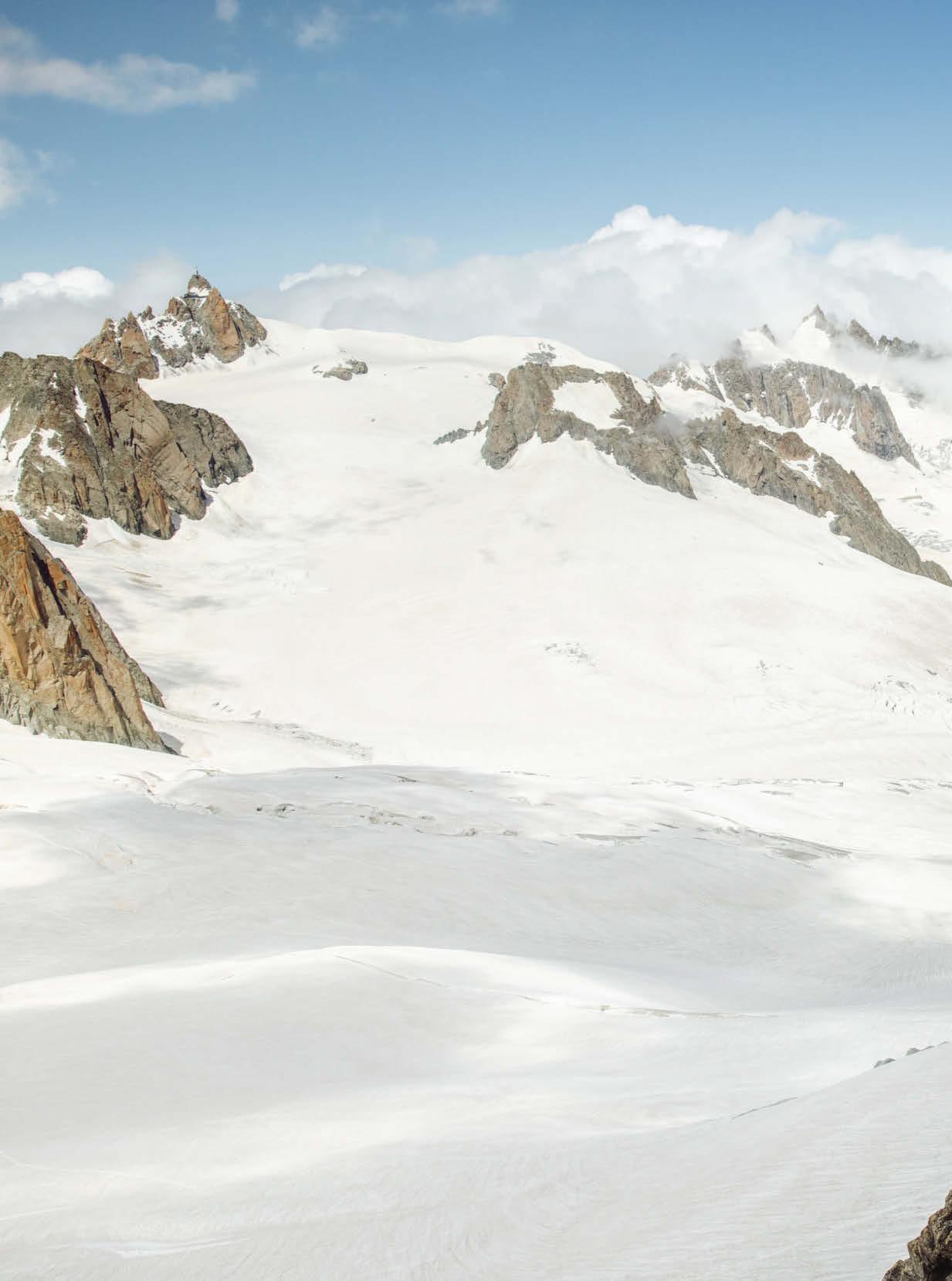
“I don’t want to just be a passenger in these scenarios”
The Matterhorn, July 2024: “I wanted to set myself something I wouldn‘t have been capable of a year earlier,” Jackson says. “To get to a technical ability respected by the climbing community, whether ablebodied or not. I want to get as good as I can be”

Knife edge: Jackson scales Aiguille Dibona in 2022. “It’s one of the Alps’ most spectacular spires, like a dagger sticking up into the air,” says his guide, Leo Houlding. Jackson says, “This was technically the hardest climbing route I’ve done”

Jackson’s journey in mountains
April 2018
Snowdon, UK, 1,085m
September 2018
Mont Buet, France, 3,096m
January 2019
Mera Peak, Nepal, 6,476m
April 2020
Staircase challenge, UK, 5,500 steps (the 8,849m height of Mount Everest)
September 2020
Gran Paradiso, Italy, 4,061m
September 2021
Allalinhorn, Switzerland, 4,027m
April 2022
Himlung Himal, Nepal, 7,126m
June 2022
Toubkal, Morocco, 4,167m
September 2022
Aiguille Dibona, France, 3,130m
April 2023
Vatnajökull ice cap, Iceland, 150km
July 2024
Matterhorn, ItalySwitzerland border, 4,478m
ED JACKSON
in just 12 seconds. Halms had gone down the mountain after suffering from altitude sickness.
“He was on a similar journey to me – he was battling with not being the old Ben,” says Jackson. “When we got to base camp, I was concerned he’d be deflated at not having made the summit, but he was elated – primarily because he thought we were dead. He’d also just found out he was going to be a dad.” Jackson smiles, adding, “It obviously helped when we told him we hadn’t got to the top and had had a pretty fucking terrible time up there.”
Leo Houlding has tackled some of the world’s greatest peaks.
In January 2020, the British adventurer became just the third person to reach the summit of the Spectre, a 2,020mtall Antarctic mountain so remote that only 10 people have ever seen it, let alone climbed it. What’s more, he solo-travelled 2,000km there and back, propelled by a kite ski. In short, he knows mountaineering, so in 2021 Jackson approached him. “I’d never met Ed, and he wanted to climb Mount Blanc,” says Houlding. “Initially, I was very reserved – I only heard the ‘quadriplegic’ part. I couldn’t see how we were going to climb Mount Blanc, so we arranged to do Scafell Pike, England’s highest mountain. I’m fussy about who I climb with – I don’t like climbing with dickheads. I didn’t tell Ed this until later, but half the experience was to see what he was physically capable of, the other half to see if he was a dickhead. We had a blast. In the end, we went to Chamonix and no one climbed Mount Blanc, because the weather was shit.”
The two became firm friends, climbing a number of mountains together. This summer, a film about Jackson’s life, The Mountain Within Me, was released in cinemas. Towards the end of it, we see their 2022 climb up the north ridge of Aiguille Dibona, a 3,130m mountain in the French Alps that peaks at a perilously sharp spire. “It was a real test of my technical ability,” says Jackson.
Houlding scampers up the ridge like a mountain goat, barking words of encouragement to his friend. At one point, he looks back to see that Jackson has his left hand stuck in a hold on the rock face. The pair joke that he’s created a new technique. “I’ve got pinch-grip so I can do shoelaces and stuff, but climbing is very difficult,” explains Jackson. “I often use my fists.”
“I’ve learnt a lot about spinal cord injuries from climbing with Ed,” says Houlding. “They manifest in different ways. At first

“For me, there is only hope. Hope is hope”
glance, you wouldn’t know how disabled he is. When you see him walk, you get a clue, but he’s such an athlete you don’t realise how much impediment he has. Not being able to lift on your left side is a real hindrance in climbing. He can’t reach above his head with his left arm, can’t reach with his left leg. He really has to adapt.”
“I have to concentrate very hard just to walk to the bathroom,” says Jackson. “If I switch off, I fall over. On a mountain, that’s high consequence. The Matterhorn was 20 hours. By the time I got to hour 15, the tiredness was as psychological as it was physical. I can’t do it autonomically; I have to be constantly alert.”
Yes, you read that correctly: the Matterhorn, one of the Alps’ most formidable mountains. In July this year, Jackson scaled the 4,478m-high summit via the Hörnli Ridge, the route of the first ascent in 1865, which claimed the lives of four climbers.
“The Matterhorn really was a personal challenge,” Jackson says. “Himlung Himal was the hardest mountain I’ve climbed, Dibona probably the most technical. That opened up the idea of, ‘Can I combine the two and take on a big technical mountain?’ I wanted to see if I could get to a technical ability that’s respected by the climbing community. I don’t want to just be a passenger in these scenarios. Yes, I do everything slower and inefficiently, but I want to be good at it. These challenges are to create awareness of disability in the outdoors, to inspire others.”
Jackson’s message is spreading. He has a second film out this year, Alpha, about his 2023 crossing of Vatnajökull – the largest ice cap in Iceland – with former SAS reservist Darren Edwards and explorer Niall McCann. Facing 100kph winds and -27°C cold, the trio tackled its longest west-to-east route in 11 days. “Darren’s in a wheelchair – he’s got a complete spinal cord injury – and Niall’s got an incomplete injury where his legs are affected,” says Jackson. “We wanted to do the first all-disabled, unsupported crossing of Vatnajökull. Individually, none of us would have got across that ice cap, but together we could cover each other off.”
Jackson’s next trip is to Kyrgyzstan: “[We want] to do a virgin peak, something over 5,000m. I’m keen for it to be the first-ever first ascent by a disabled team. We’ll then name the route. I’m working with Berghaus to adapt kit for people with disabilities to make adventures like this more accessible.
“Nothing that’s happened has been part of the plan,” he adds, poignantly. “If all this was detrimental to my recovery, I’d find it hard to justify. I’m not saying these expeditions don’t take a toll on my body, but [when you have] these long-term injuries, if you stop, you regress. And it’s not just gaining a few pounds – you regress to the point where you can’t climb the stairs. I’m not naïve to the fact I’ll age differently. The longer I can prolong my independence and have fun with friends, the less impact on Lois and my mum and dad. I have a responsibility, not just to myself but to everyone.
“I’d love to teleport back to my old self for just a year to see what I could do in the mountains, see how good I could be. Then I’d come back to where I am now, because hopefully what I’m doing inspires others to do things they wouldn’t usually do.” The Mountain Within Me is available to buy or rent on all major digital platforms. Alpha will be showing at the Kendal Mountain Festival in Cumbria from November 21 to 24; kendalmountainfestival.com


Enhance, equip, and experience your best life
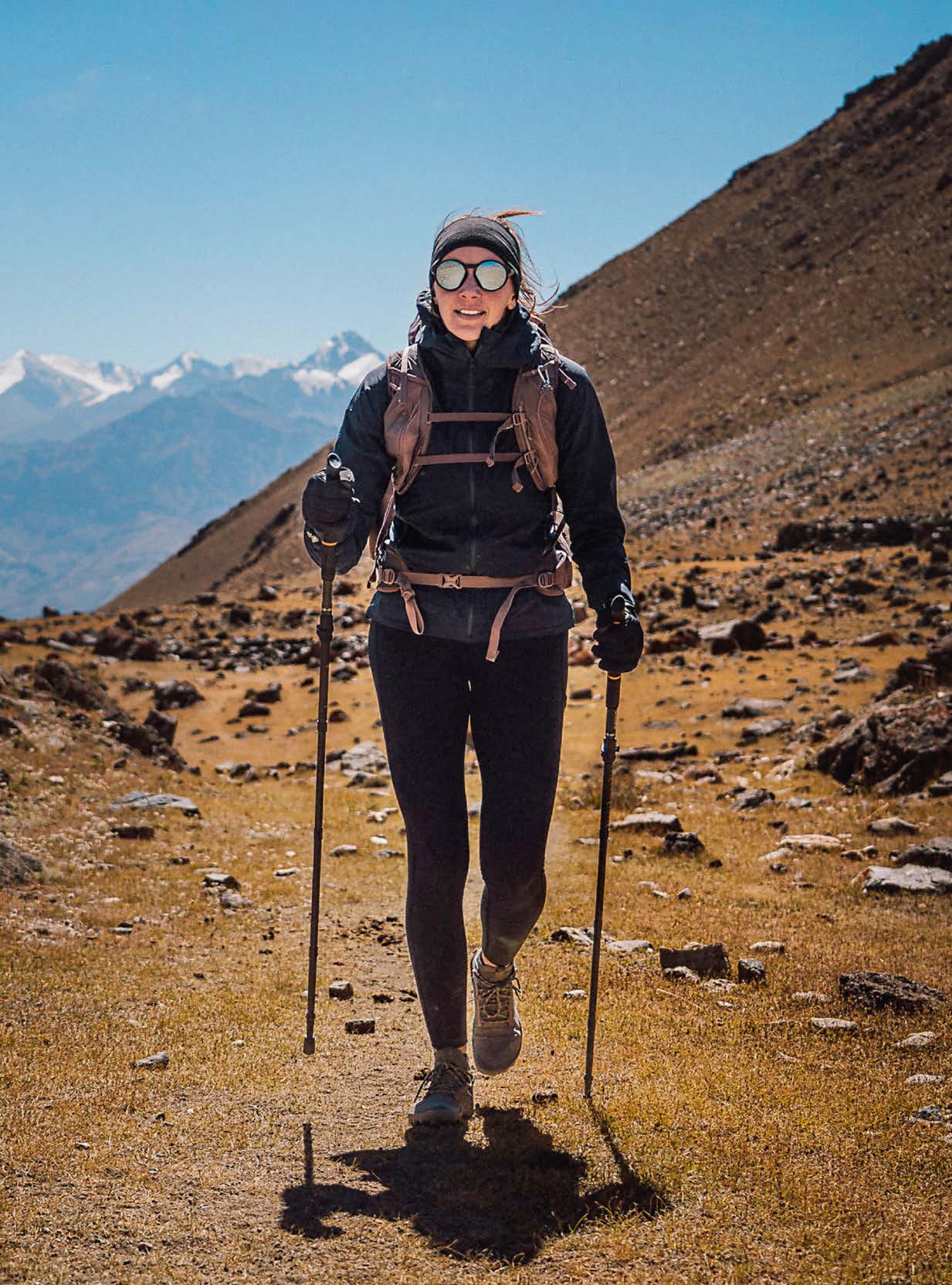
“Wind rips across the exposed top, and the only sound I can hear is hundreds of violently flapping prayer flags… I touch the cairn before collapsing onto a pile of rocks”
Iclutch my carbon poles for balance and attempt to fill my lungs. My head spins and my legs ache. I’m glad John Summerton – my photographer and partner – is enough paces behind me that he can’t hear my ragged breathing.
We’re nearing the la (Tibetan for pass), which sits slightly below 5,500m. The first of the vibrant, colourful prayer flags that mark the peak come into view in the distance, but they might as well be hours away for how rough I’m feeling.
I force myself to take another step. The only way to feel better, I reason, is to cross the la and descend the other side. I place the tip of a pole on the rocky surface and shift one foot forward. Then I repeat with the second pole and the second foot. I have less than 200m of climbing before we reach the pinnacle of this trip. Ever so slowly, I inch my way upwards.
We’re in Ladakh, northern India, fastpacking a three-day, 60km route from the outskirts of the region’s joint capital, Leh, into the heart of the Nubra Valley via the summit of Lasimiru La. A plateau flanked by numerous mountain ranges including the Himalayas, Ladakh translates as the ‘land of high passes’ – a fitting name given that most of it is more than 3,000m tall – and has long held a fascination for me. Situated at impossibly high altitude, the inhospitable mountain ranges effectively cut off the region from the rest of India, preserving a distinct culture rich in Buddhism, with many Tibetan refugees.
Part of my curiosity was the authentic and widespread Buddhist culture; many hidden monasteries are perched high on steep mountainsides, incredibly isolated and stunning in their simple Tibetan architecture. My other interest was the mountains themselves. I finished a solo project to fastpack the length of a
mountain range on six continents in 2021 and was ‘free’ to explore and pursue the hybrid sport I’m passionate about. The mountains of Ladakh stand as a truly wild, isolated place that I was dying to immerse myself in.
For the uninitiated, fastpacking is best described as something between ultrarunning and thru-hiking. Its ethos is to be entirely self-sufficient and pack incredibly minimally. With a lightweight but functional set-up, you’re free to go anywhere, as far and fast as you like. Fastpacking has always felt like the greatest sense of freedom I’ve ever encountered. I cut myself off from the material world and move my body across terrain at an enjoyable pace. There’s no phone signal, and my hair is a mess. It’s pure, wild bliss.
This is the first time John has joined me on one of these excursions, and the

Sleep it off
An inflatable mattress is essential to staying warm. I recommend a hydrophobic down sleeping bag, too. Whether you bring an extra layer like a shell bivouac or a tarp depends on your needs and the weather.
Get lit
On high mountains with low temperatures, a small, lightweight stove and titanium pot will help you stay warm, boil drinking water and cook caloriedense meals. Dehydrated food is lighter to pack, and you need the extra calories at high altitude.
Layer up
Dress in layers to stay dry and comfortable. Natural fabrics like Merino wool make the best base layers, then bring a mid-layer like a fleece, and a down jacket and waterproof as outer layers. For Ladakh, I had two down jackets, down trousers, down mittens, and even down slippers.
Plan ahead
Go online for inspiration on trails, campsites and adventures. When planning your route, be realistic about distances and elevation gain, and ensure there are stops for water, supplies and shelter. Practise navigation, and always tell someone where you’re going.
Even at an extreme altitude there’s wildlife and yak herds, so all water must be filtered; (opening page) the Ladakh Himalayas are wild, remote, steeped in tradition, and very high


Fastpacking embraces the ethos of ‘fast and light’. Move with freedom, and carry as little as you need to survive
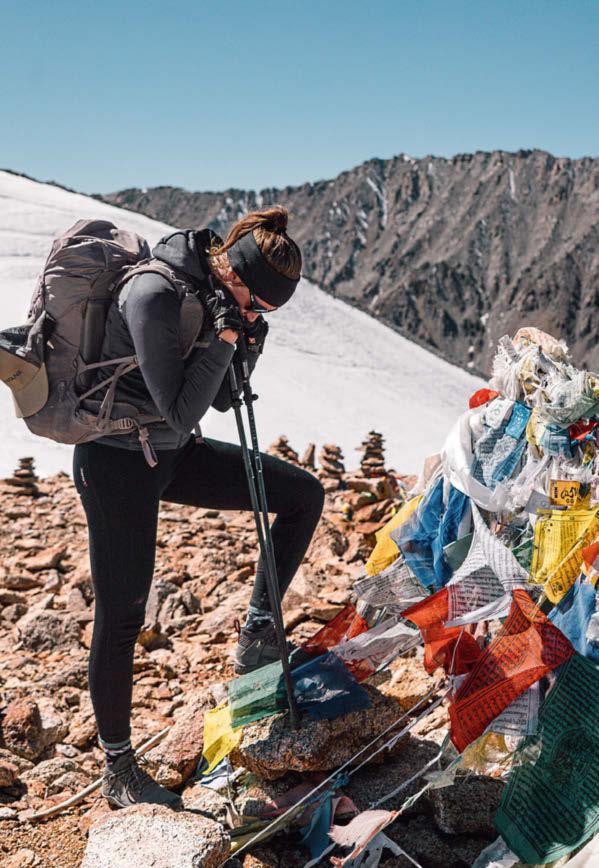
first time he’s experienced my definition of no comfortable luxuries. On our first day, having completed a six-hour run with more than 1,000m altitude gain from our starting point just off the main highway from Leh, we bivvy under the la at almost 5,000m in altitude. Without a tent, we can gaze at the stars, unhindered by light pollution; at this elevation, we feel closer to them than ever before.
The mild late-September weather plummets below -10°C overnight. While the lack of a tent gives the atmosphere of truly sleeping wild, it makes for a long, cold night. Waking in the morning, all of our water and the nearby river has frozen, and we have to work with numb fingers to turn ice into
Leh is the joint capital (with Kargil) of Ladakh, and for most of the year the only reliable way to arrive is by plane – there are daily domestic flights from New Delhi and Mumbai. The city is at an altitude of 3,500m, so spending time here acclimating before adventuring in the region is strongly advised.
hot coffee before either of us is willing to get out of our sleeping bags.
After packing up our primitive camp, there’s another two-and-a-half hours of ascent before I crest the final stretch to the 5,440m la. Wind rips across the exposed top, and the only sound I can hear is hundreds of violently flapping flags. I try to find enough air in my lungs to let out a whoop to let John know I’ve made the top, but my voice is lost in the roar. I touch the cairn before collapsing onto a pile of rocks.
The air is so thin and cold, we can’t stay long to soak in the views. When John arrives, we take some quick photos as evidence of the highest ‘run’ we’ve ever experienced, then pull on our microspikes to negotiate the snowy north-face descent. We’re feeling the altitude now, and I worry that the traverse we must make across a few kilometres of snow and ice could easily lead to accidents. I’m torn between wanting to move at a safe pace and being equally desperate to run quickly to a lower altitude where the air will be warmer and, hopefully, rich enough in oxygen to stop my spinning head and laboured breath.
A wide smile spreads across my face as my microspikes gain traction in the snow; my fear subsides, and I realise I can truly run. After a long, slow morning of climbing to the top, it feels liberating to move quickly again. I break into a steady jog, flowing with the rhythm of snow crunching beneath my feet.
Reaching the snow line, we stop to remove our microspikes and warmest layers. We can finally look around properly: the mountain amphitheatre is still. Not another soul is here, although the resident snow leopards could be nearby. It’s reminiscent of a moonscape, nothing but rocks and ice. No clouds interrupt the azure sky, and the sun’s warmth is welcome after being so cold.
Continuing north towards the Nubra Valley, I’m overwhelmed with gratitude. It’s such a rare privilege to find untouched nature and have moments like these in total isolation from the material world. Carrying nothing more than what we need, we are momentarily free and completely immersed in this special place. We feel part of it. Wild. Jenny Tough is an endurance athlete and adventurer, and the author of SOLO: What Running Across Mountains Taught Me About Life. She has completed world-first solo runs across three mountain ranges and is a twotime winner of the Silk Road Mountain Race; jennytough.com



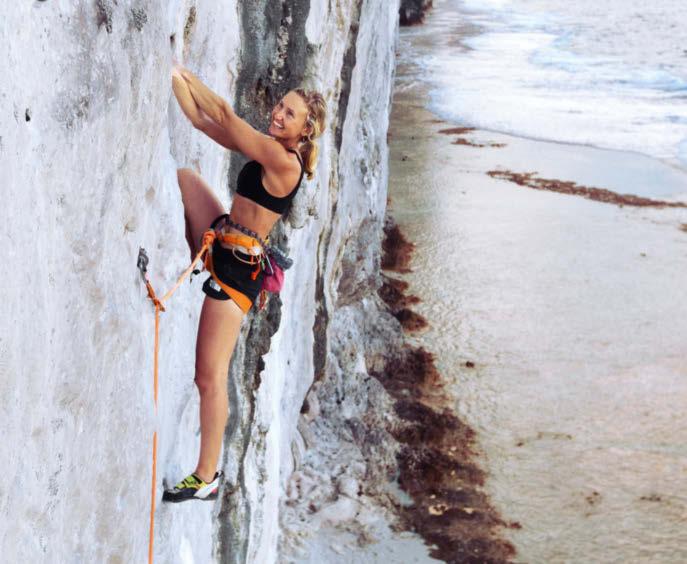
rock climber Sasha DiGiulian, 31, on why failing is her biggest strength
“Climbing is a sport of failure – maybe more than 90 per cent of the time you fall,” says Sasha DiGiulian, an American climber who has made a career of overcoming the odds, with more than 30 first female ascents to her name. “Mentally, it trains me to accept failure as a part of the process. Sometimes we look at progress as this linear expectation of progressing every single day. But sometimes you have regression before you have progression, and through the act of consistently falling in my sport I’ve learnt how to get back up time and time again. It’s like that proverb: ‘Fall down seven times, stand up eight.’ That’s what’s beautiful about climbing: you learn to expect that if you’re not falling, you’re not pushing yourself hard enough.
“In climbing, the mental game needs to be just as strong, if not stronger, than the physical, because it’s like a live, interactive jigsaw puzzle. You’re looking up at this blank cliff, trying to figure out the sequences and the ways in which you can put all these seemingly disparate
aspects of a rock wall together in your mind. Then you’re challenging your physical body to actually do it. Having a strong mind enables you to think outside the box and be more creative, as well as [giving you the skills to] assess risk and operate as safely as possible in extreme conditions.
“I’ve had plenty of times where I’ve been physically struggling, like my ascent of Logical Progression [a famous route in Chihuahua, Mexico, which DiGiulian was the first female climber to conquer, in May 2021]. I did it five weeks after my final surgery. [The previous year, she was diagnosed with hip dysplasia, a condition where the hip socket doesn’t form properly at birth, which resulted in five surgeries across 18 months.] I really went through the struggle on the wall, of doing something that maybe I wasn’t as physically prepared to do. But mentally I was so set on the fact that I needed this [to help with the] fear I was manifesting. It was an important part of my physical and mental comeback.”

“In some tasks, you have to fail many times,” says York-Peter Klöppel, head of Mental Performance at the Red Bull Athlete Performance Center in Austria. “Even the greatest tennis players of all time, like Federer, Nadal and Djokovic, lose 45 per cent of the points [in a match]. And in the specific example of climbing you learn every time you fall. It’s the only way to find out what works and what doesn’t.
“There’s a saying that best athletes have the shortest memory: you have to learn tools to move on quickly. It may take them time to process, but the important thing is that at some point you find a way to move on and continue. Find the people you trust, and speak about it. That’s the best way to process it. If you keep it to yourself, it’s going to be harder.
“We all tend to avoid situations where we know we’re going to fail. But it’s a positive thing to be prepared to experience that a little bit more.”
Scan the QR code to hear the Mind Set Win Podcast

From pan-flat paths to extremealtitude exploring – gear for every clime and climb
Words Charlie Allenby
Illustrations Rachael Stott
For the majority of us, especially those living in a city, outdoor exploring mostly takes place at sea level. The terrain may change – from pavements and gravel bridleways to loam paths and stone singletracks – but the technicality of the trails remains firmly on the relaxed end of the scale. You don’t need to go all-in on gear with flashy features promising big-mountain credentials; instead, keep things minimalist and lightweight.
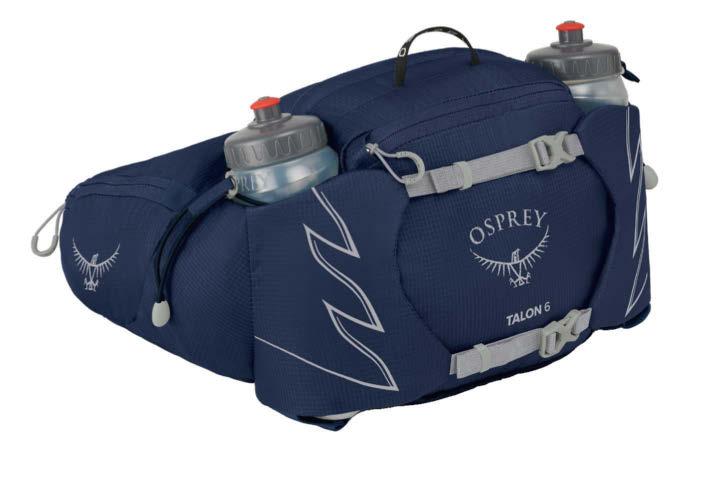
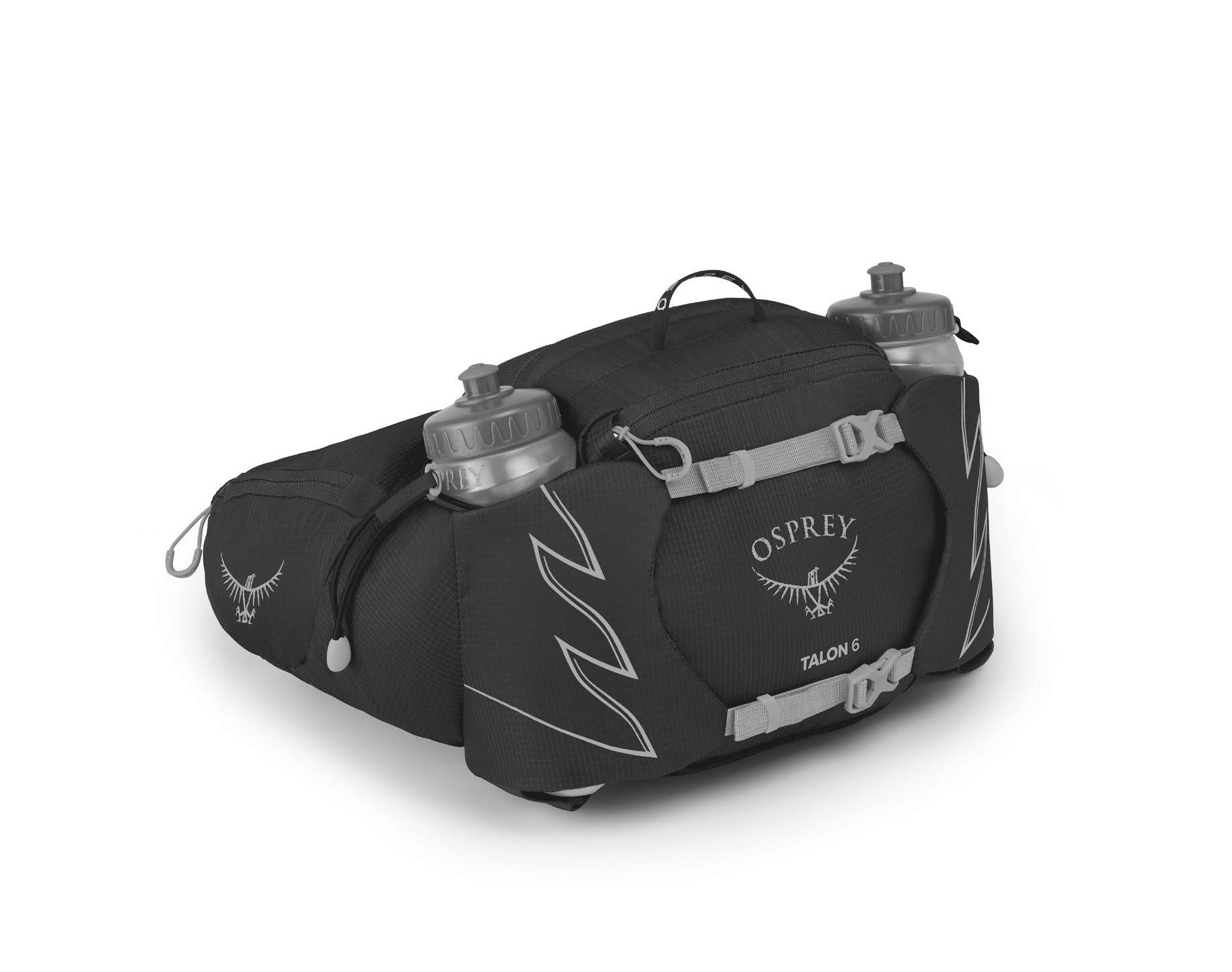
The day bag is a perfect example of when bigger isn’t always better. “You’re not going to need anything too large,” says professional expedition leader Rebecca Coles, “just enough for snacks, drink and a windproof-type layer. So around 20-ish litres.” The compact Osprey Talon 6 Lumbar Pack (osprey.com) falls firmly within this limit, but don’t be fooled by its svelte form. Padded sleeves with bungee-retention straps can securely hold two bottles, and its main compartment and hip-belt pockets keep trailside essentials such as an outer shell and snacks within arm’s reach.
When it comes to the jacket, don’t get sucked into the Gore-Tex arms race, says Dan Moore from the International Federation of Mountain Guides Associations (IFMGA). He



recommends a lightweight, windproof layer such as the Jack Wolfskin Prelight 3L Jacket. “Even if you’re wearing a nice woolly fleece, certain wind speeds will just whip straight through that,” Moore explains. “So a light windproof makes a huge difference, whether you’re going to get cold or not.”
In a sea-level setting, waterproof shoes can also prove a liability – they’ll retain water if it gets inside. Instead, Moore recommends a breathable material that will also dry quicker. The open nature of the Merrell Hydro Next Gen Moc (merrell.com) takes breathability and drying to the extreme. “Even if you walk straight through a river they’re completely porous, so in 10 minutes of pounding they’re dry.”

The Jack Wolfskin Prelight 3L Jacket (jack-wolfskin.co.uk) is a great outer layer to have in your armoury. The brand’s exclusive Texapore Pro ripstop fabric ensures freedom of movement, is breathable, and offers complete protection in the most extreme weather conditions. Also, its fixed hood will shelter your neck and head when a gale-force wind is blowing.
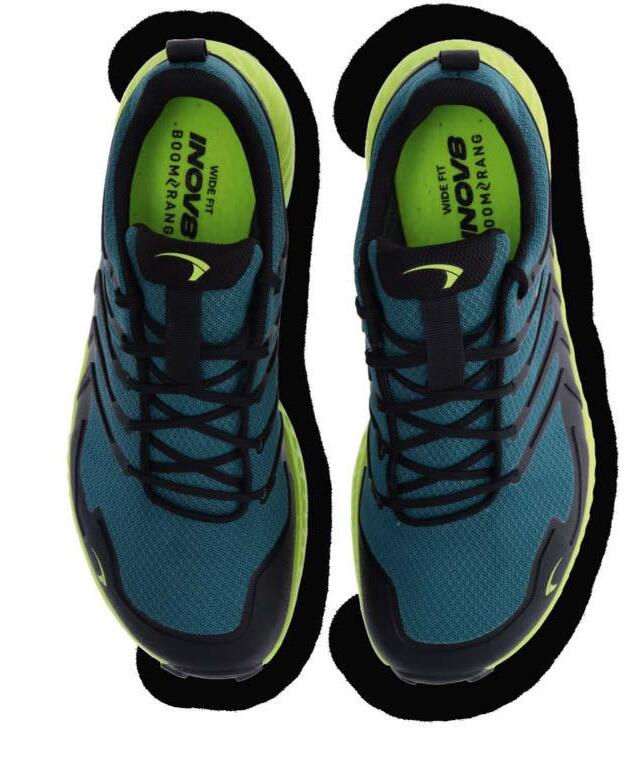

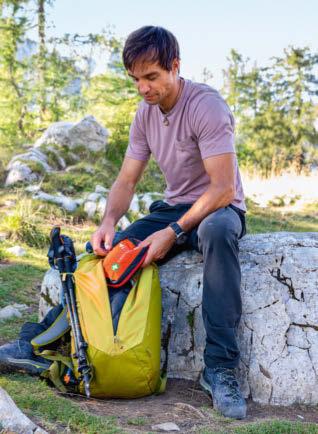
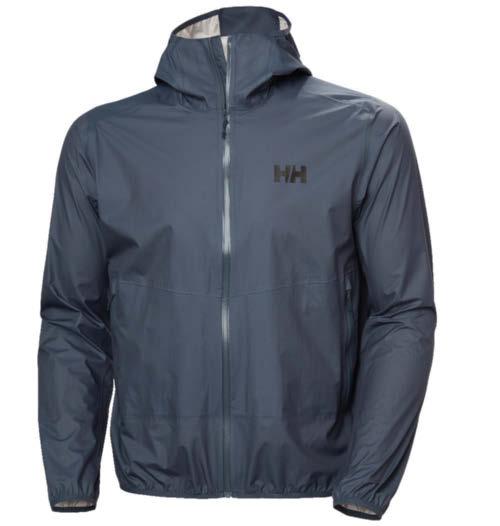
The tree line is where mountain conditions become too inhospitable for vegetation to thrive. Its altitude isn’t the same around the world, though. In the UK, it can be as low as 200m above sea level, while in Tibet it reaches 4,900m – higher than Mont Blanc. Below this point, adventures can vary from dense woodland to alpine grassland meadows, and your kit needs to be adaptable. IFMGA mountain guide Tom Ripley’s footwear of choice here is trail shoes. “When I’m walking in the UK I want them to be waterproof, and in the Alps, where it’s normally drier underfoot, I need a spongier sole,” he explains. Lake District-based brand Inov8’s Roclite GTX Hiking Shoes (inov8.com) tick both boxes by pairing a Gore-Tex waterproof membrane with a cushioned foam midsole and springy footbed to keep your feet dry and fresh. Outer shells should be a bit beefier than those used at sea level, but Ripley warns against too many other features. “Zips and pockets add weight,” he says. “Simple designs that are lightweight but made of hard-wearing materials are best.” The water- and windproof Helly Hansen Verglas 2.5 Layer Fastpack Jacket (hellyhansen. com) weighs 180g, making it one of the most packable shells around. This mantra extends to the Deuter AC Lite 17 (deuter.com), an ultralight rucksack with an impressive comfort-to-weight ratio that has an easy-access main compartment to keep essentials to hand.

Here, conditions become less predictable. The weather is changeable and the lack of vegetation means you’re completely exposed, while trails turn into rocky scrambles and your hands come into play.
Navigating an off-piste path requires extra protection. “That’s when I’d consider an over-ankle boot,” says Moore. “Scrambling through loose rock, something always whacks you on the ankle bone – not pleasant.” Salomon X Ultra Alpine Mid Gore-Tex Hiking Boots (salomon.com) shield against rock strikes, and the brand’s stickiest rubber compound keeps you gripped to any terrain. When using your whole body for propulsion, you must factor into your bag of choice. “It needs support in the back so you can comfortably carry quite a heavy load, but if it’s too stiff it won’t move well with your body,” warns Ripley. The Rab Aeon 27L Day Pack (rab.equipment) fits the bill: the semi-rigid structure of its close-fitting Air Contour X system moulds to your shape and moves with rather than against you. Lastly, Moore recommends extending your arms above your head when trying on a waterproof jacket, to simulate scrambling and climbing. “If you can’t find one that doesn’t lift up, consider a larger size so that when you put your arms up to climb you don’t hoick the jacket out of your harness and get the wind on your kidneys.” Designed with a ‘Mountain Fit’ cut, you won’t have this issue with the Montane Phase XT Waterproof Jacket (montane.com).





Everest’s summit is the most inhospitable place on Earth. So if a jacket can withstand such extremes, all other settings will be a breeze. ThruDark’s Patriot (thrudark.com) has the same DNA as the Summit Suit worn by record-breaking mountaineers, with Dyneema shoulder pads, a storm hood, 850-fill-power goose down, and a Pertex outer that repels water, ice and snow.


At the extreme altitudes of the world’s highest peaks, the elements can feel like they’re conspiring against you, and your kit choice can spell the difference between life and death. Fight fire with fire or, in this case, ice with insulation – from head to toe.
“You can experience big temperature differences when makingan alpine start,” says Coles, who has led expeditions to altitudes of 7,000m. She says it’s important to have adaptable layers to put on and take off as you go, although these can soon add up on really cold summits: “You need to be able to get them into a pack when not wearing them.” The tearand abrasion-resistant Mountain Equipment Fang 42+ Pack (mountain-equipment.com) can accommodate even the most heavy-duty jackets in its main
With sub-zero temps and hostile terrain, insulation enters the equation
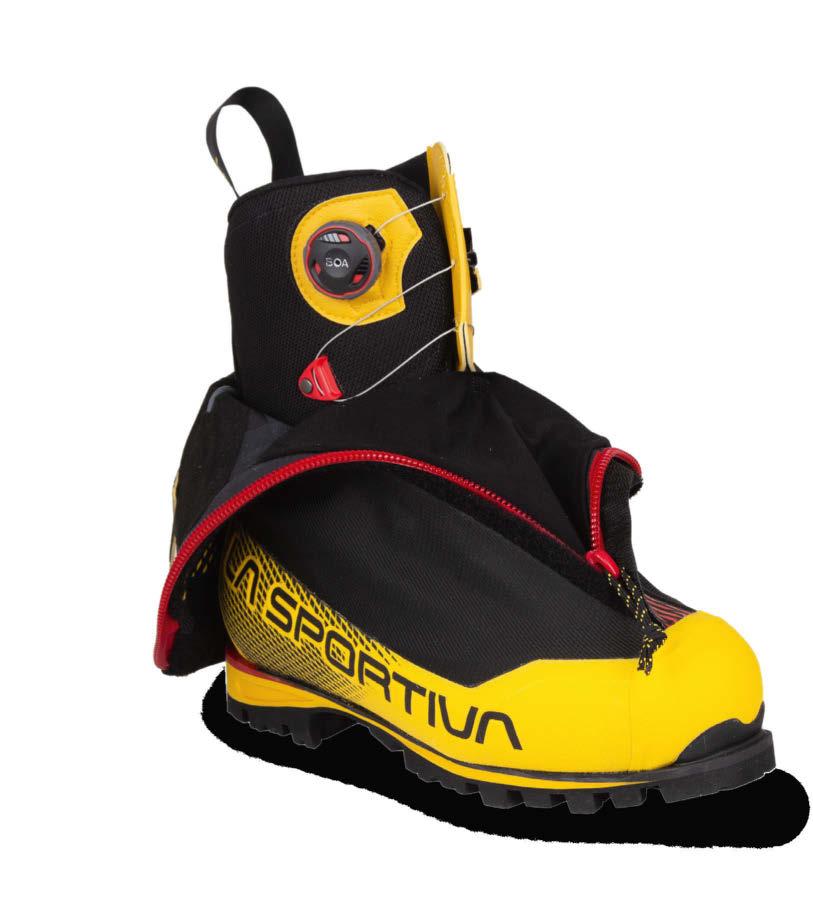

compartment, while its floating lid with a spacious zipped pocket is ideal for head torches, hats and gloves.
Arguably the most important decision, though, is what you’ll wear on your feet. “When getting into more serious alpinism – climbing snow, ice and ridges – you need something with a ledge on the front and back for the crampons, and a stiffer sole,” says Moore, adding that a built-in gaiter will keep your feet dry, while a double boot – which has a removable inner boot for additional insulation – is aimed at Himalayan and huge snow climbs. La Sportiva’s G2 Evo Mountaineering Boot (lasportiva. com) combines an insulated internal bootie with a Cordura gaiter outer that can be adjusted on the fly via an external BOA dial – critical when simply removing your gloves could result in instant frostbite.
We know how.

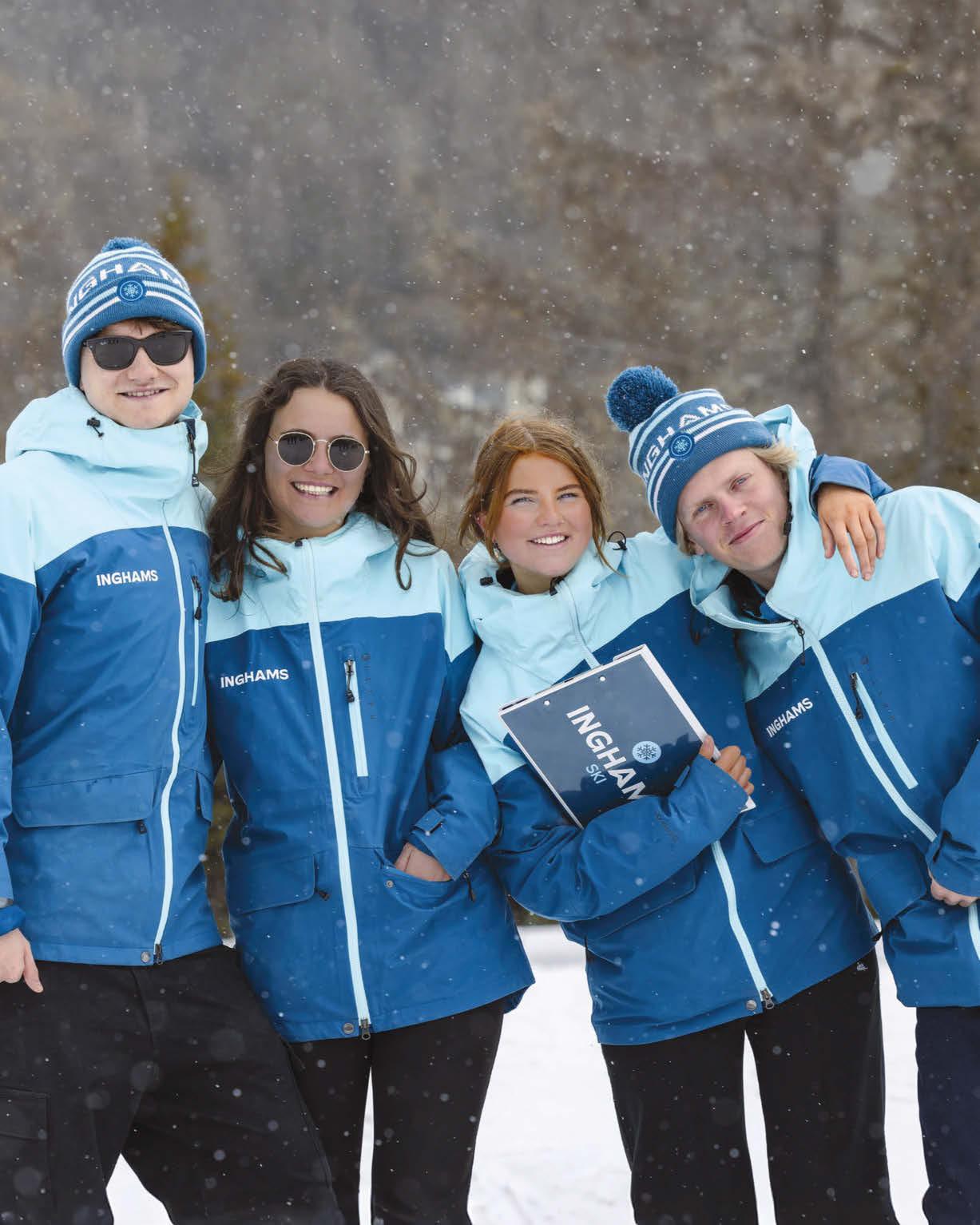


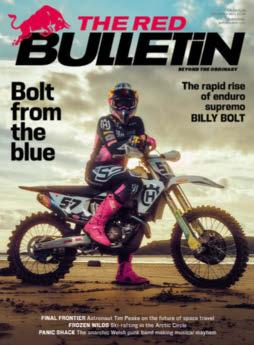

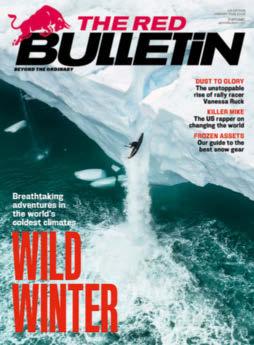

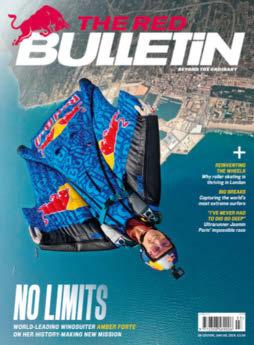


B-boy Johannes ‘Hatsolo’ Hattunen on why breakdancing should be a staple of your workout routine
Headspins. Flips. Gravity-defying freezes. Breakdancing is one of the most physical forms of dance, requiring B-boys and B-girls to display superhuman strength, endurance and creativity in a 60-second throw down at a battle or cypher (a circle of competing breakers).
Johannes ‘Hatsolo’ Hattunen (pictured) knows this better than most. Having discovered breaking in the late ’90s, the 39-year-old Finn has dedicated his life to the dance form, competing globally in events such as Red Bull BC One as well as coaching others at his gym in Helsinki. Hatsolo believes the dance style is a great form of fitness for all, regardless of age or ability. “It’s never too late to start,” he says. “In Sweden, there’s a breaker named Krazee Grandma, who started in her sixties and is now in her late seventies. Even if you’re injured, you still have ways to dance. A lot of the high-level dancers –even myself – created their style because of some injury, and it transforms the dancing into something unique.”
Now an Olympic discipline after its debut at the Paris 2024 Games, breaking is different from other sports and forms of exercise, Hatsolo adds. It’s a sociable, community-based activity where having a good time and listening to music are part of the package – more like play than pounding the streets or lifting weights. “There’s no winner or loser. You succeed or fail. And if you fail, you try again.”
Breaking taps into all forms of exercise. “It has cardio, callisthenic [bodyweight] movements,” says Hatsolo. “You have to put yourself in hard physical positions, [and] it’s great for your flexibility. But the benefits extend beyond dancing: “There’s a lot of skill transfer with different sports, hobbies, even everyday life. For example, I’ve started playing padel and found a lot of similarities [with breaking] in the rotation, moving in a small space, digging deep, and getting low to play the ball better.”
A study conducted by researchers at the University of Brighton with help from


“Toprock is all about dancing on your feet. There are hundreds, even thousands of unique steps. If you’re starting from the basics, try the two-step. Imagine that you’re standing in the middle of a circle. Step forward with your right foot pointing at 10 or 11 o’clock. Bring your right foot back. Repeat on
the other side, aiming your left foot between one and two o’clock. This is a great full-body exercise and an excellent way to wake up your nervous system for bigger moves or exercises. Keep it light and aim to stay on the balls of your feet. Try it for 30 seconds on, 30 seconds off, and do a couple of rounds to see how it feels. You’ll soon feel it in your calves, for sure.”
The Red Bull BC One World Final takes place in Rio de Janeiro, Brazil, on December 7. Watch it live on Red Bull TV; redbull.com
dancers at London’s City Academy found that street dance like breaking burns around 600 calories per hour, matching common forms of cardio such as cycling, swimming and running. But the burn lasts beyond the breaking session, giving you more bang for your workout buck. Its highintensity interval nature promotes excess post-exercise oxygen consumption (EPOC), an effect where your body continues to burn calories to aid recovery. “If you run at a low intensity for an hour, that’s it,” says Hatsolo, “but a hard breaking session gets your heart rate up multiple times, so the need for recovery is elevated. Your body burns more calories for hours afterwards.”
You don’t have to commit to a battle to reap the benefits of breaking. “[When circuit training], it’s good to incorporate some kind of movement that raises your heart rate, whether it’s running, an assault bike or a rowing machine,” says Hatsolo. “But you should also consider breaking. It gets the heart rate up, and you can do specific movements like push-ups, sit-ups or chin-ups in between to strengthen the body parts you’re focusing on. It’s a great way to make regular training more fun.”

The new Compex Fixx Mini is the ultimate way to massage on the move
The pursuit of constant progression and marginal gains has seen professional athletes and amateur wellness enthusiasts alike look beyond what they do when donning their workout gear to achieve their personal bests.
Nutrition has been refined, sleep patterns analysed, resting heart rate tracked. And that’s before you delve into the world of recovery.
The concept is simple: the better you recover, the faster you can perform at your peak again, and the lower the risk of injury. But it’s not limited to the post-workout stretch and cool down. Warming up using a muscle massager can ensure
you’re ready for any training session from the first effort; loosening tight muscles can aid flexibility and form and keep you off the physio table.
Historically, this approach would have been the preserve of elite athletes and their army of support staff. But thanks to pioneering muscle stimulation experts Compex, the same techniques and tools are available to everyday fitness fans. This doesn’t require an investment in expensive and bulky kit either, as its new Fixx Mini proves.
A portable, lightweight massager, the compact design can fit into the palm of your hand and provide instant relief on the go. At 483g, it’s incredibly portable and can be taken with you wherever you go –whether that’s the gym, travelling or commuting to the office. Its quiet, 60dB motor also means it can be used discretely, making it ideal for quiet environments such as watching TV while sitting on the sofa.
Three speed settings – 25, 33 and 42 strokes per second – provide a variety of different massages, from a light pre-workout activation and post-training shifting of lactic acid to a deep-tissue kneading


that can target any trigger points and will help rid you of any knots. Its interchangeable, different-shaped tips enable you to customise the experience to your exact needs, too, while it’s compatible with all Fixx 1.0 and 2.0 tips.
Its convenience is backed up by a powerful and long-lasting battery that packs up to 120 minutes of massage into each charge, enabling you to get in a full recovery or multiple uses without needing to be near a plug. And if your Fixx Mini requires some juice, its USB charger will return it to full battery in as little as 60 minutes.
Finally, unlike other massage guns the Fixx Mini can be used with an optional extension handle, meaning no muscle group is neglected and you can soothe any hard-to-reach areas.
So if you’re in need of some relief after a testing workout or just want to boost your relaxation after a hard day at the office, the Compex Fixx Mini is adaptable and versatile enough to fix any muscular matters.
Find out more at compex.com

Dream of nailing a new challenge? Tom Bridge knows how. The 23-yearold recently achieved his niche goal of kitesurfing from the top of Richard Branson’s cruise liner, making history in the process
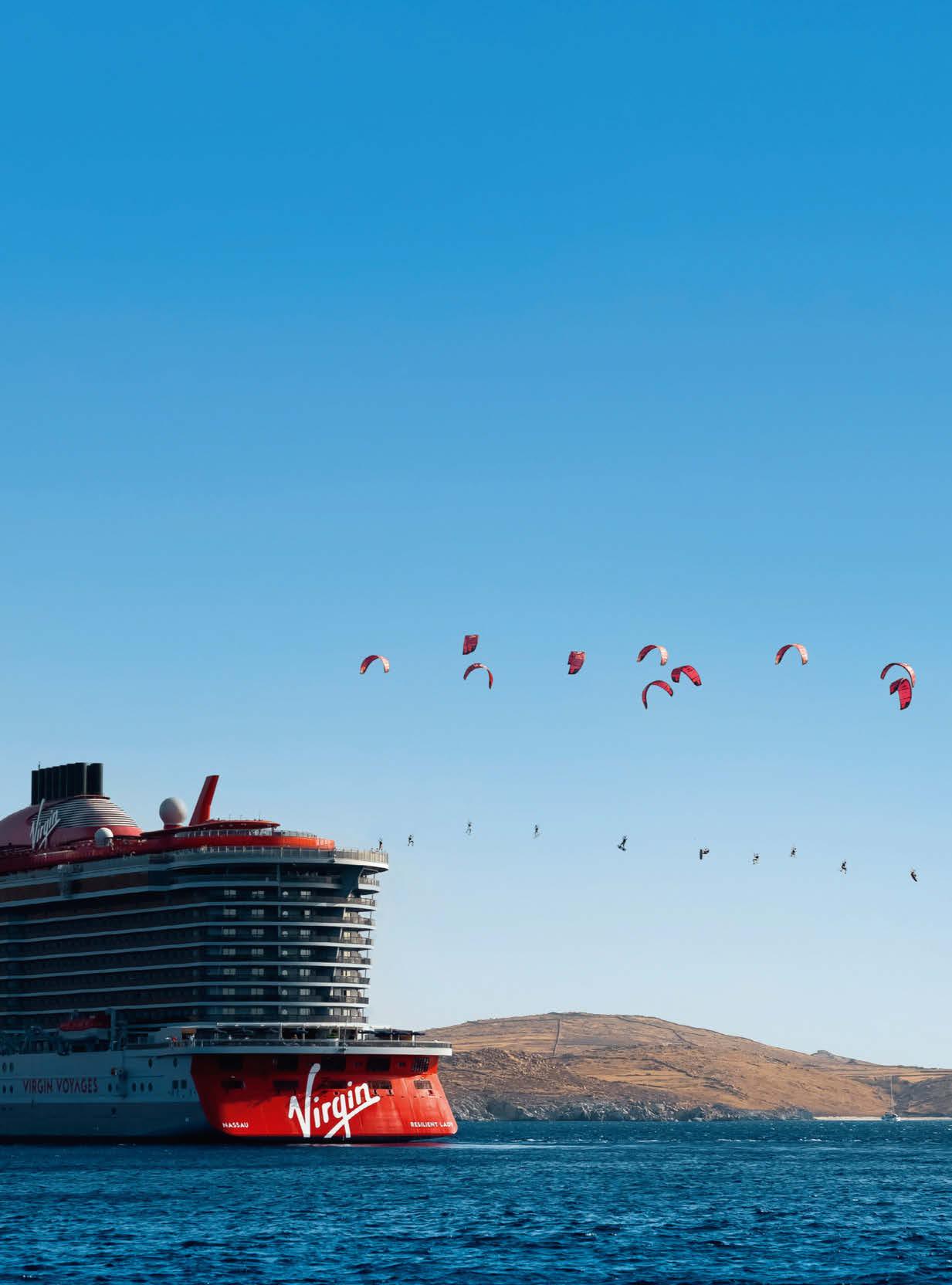
Aged only 23, kitesurfer Tom Bridge has already amassed an enviable collection of tricks, titles and trophies. But the former Pro Men Freestyle champion at the British Kitesurfing Championships isn’t one to rest on his laurels. In 2017, he became the first-ever kitesurfer to land a Triple Half Cab. Three years later, he kitesurfed in Storm Ciara’s 150kph winds near his home in Exmouth, Devon. Then, this summer, he levelled up even further.
Sixteen decks higher, to be precise. Bridge kitesurfed off deck 16 of the cruise ship Resilient Lady, from a height of around 40m, in a sport where elevated takeoffs aren’t a thing. Needless to say, it was a world first.
“Usually when you go kiting, you’re setting off from a beach that is nice and sandy and has no obstacles around,” says Bridge. “I knew this was possible, but we needed everything to go in our favour.”
One thing was definitely in Bridge’s favour: his mum, five-time kitesurfing
world champion Steph Bridge, had worked with Virgin owner Richard Branson on a number of record-breaking projects, and the billionaire allowed the young boardrider access to his company’s ship while anchored near the Greek island of Delos. It was quite a challenge: there were 2,600 guests onboard, a 40m drop to the water, and a tight time window. Add in the 12,000sq-m of wind power acting on the 16th deck and achieving it was a tall order. There was a danger Bridge could be blown off track, or fail to clear the ship at all, ending up in a dead zone known as a wind shadow, where the sheer size of the ship would block the wind, sending him plummeting into the ocean.
Despite all these potential hazards, at 7.30am Bridge climbed to deck 16 and duly boosted himself off, clearing the ship and making history in the process. Having originally aimed to cover 100m, he travelled three times that, remaining in the air for 40 seconds before landing cleanly on the water.
The kitesurfing world had never seen anything like it. Nor had the passengers
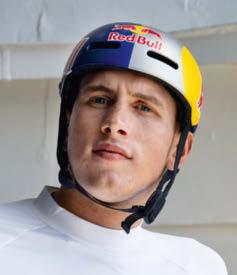
“No matter how difficult something is, you have to try to make it happen”
Tom Bridge, kitesurfing ace

lounging poolside. “It’s by far the biggest thing I’ve ever jumped off,” Bridge says, “and probably the hardest launch.” Here’s his guide to pushing your boundaries…
Keep progressing, Bridge advises, or there’s a danger you’ll stagnate. “That ship is massive!” he says. “Logistically, the whole thing was a bit of a nightmare, totally unfamiliar territory. But no matter how difficult something is, you have to try as hard as you can to make it happen. You need to push yourself or you’ll get complacent, even in kitesurfing. In any area of life, you have to set new goals to make it interesting for yourself.”
In new situations, says Bridge, you should use existing skills and instinct to guide you through. “It was scary as I didn’t know what was going to happen. The main thing I was afraid of was jumping off, suddenly having no wind, and just falling out the back of the boat, onto the lower deck.” If the kite hadn’t felt right, Bridge says, he wouldn’t have gone ahead: “But it was easier when we got the kite up. Feeling the kite flying well and holding
me up before the jump gave me a lot of confidence. I knew it was a brilliant thing to do, despite how nerve-wracking it was.”
No one, not even Bridge, can turn up for a new challenge and hope for glory. Planning is key, he says: “We were trying to do this for a year and a half before I managed it. A cruise ship is always moving, so we didn’t know it was going to happen until the last moment.” Then, once on the ship, its inflexible travel schedule and the changing wind conditions meant Bridge had a tiny window of opportunity. Previous visits to scope out the liner paid off: “If it had been my first time on the boat, it would have been a disaster,” he says. “Though I didn’t jump off on previous visits, just being there and getting used to the height and how it felt was important. I’d do exactly the same if I did it again. It couldn’t have gone any better.”
Testing yourself and accomplishing the seemingly impossible can inspire you to take on even bigger projects, Bridge says. “Being in the air was amazing. It was a brilliant thing to do. I’m happy I’ve done it, despite the risks, and I’ll remember it for the rest of my life. It feels great. You’re only going to get one opportunity to do that, and we nailed it. Now I’ve done it, I’m focusing on new challenges. Next, I want to kitesurf around the UK.” Watch Bridge conquer the cruise ship at redbull.com

If most of us had just won gold at the Olympics, we’d probably consider that job done for the year, but not Team GB’s Toby Roberts. The 19-year-old Olympic Men’s Boulder and Lead sport climbing champion joins bronze medallists Jakob Schubert and Jessie Pilz, Brooke Raboutou (silver) and 16 other world-class boulderers to compete in the third edition of this unique and gruelling, head-to-head, multi-pitch climbing race up a 200m stretch of Switzerland’s awe-inspiring Verzasca Dam. The ones to beat: last year’s winners, Slovenians Jernej and Julija Kruder. Watch it live on Red Bull TV. redbull.tv

October 2024 to 21 April 2025
Hollywood’s kookiest film director has reanimated his career this year with the box-office hit Beetlejuice Beetlejuice (someone must have uttered the magic words three times: “sequel cash, sequel cash, sequel cash”). Now comes this exhibition of his staggering resumé of work, with storyboards, costumes and props from hit films such as Edward Scissorhands and The Nightmare Before Christmas; clips from the 8mm home movies he made as a teenager; pieces of personal art (pictured), and a chance to see the first film he made as a fledgling Disney animator: 1982’s black-and-white, stop-motion short Vincent. And yes, there’s music by Danny Elfman to keep you company. The Design Museum, London; designmuseum.org
October 2024 to 25 January 2025 Dr
Actor Steve Coogan has immersed himself in roles ranging from the comedic (Alan Partridge) to the evil (Jimmy Savile). In this new stage adaptation of film director Stanley Kubrick’s 1964 Cold War satire, he draws on a bit of both, portraying the three characters played onscreen by the late Peter Sellers, including the eponymous former Nazi physicist with a twisted postArmageddon plan. It was developed by Alan Partridge co-creator Armando Iannucci, along with Sean Foley, who recently adapted Withnail and I for the stage, so expect the poster reviews for this atomic chucklefest to declare it “explosively funny”. Noel Coward Theatre, London; noelcowardtheatre.co.uk


2
The League of Legends World Championship (aka Worlds) is the biggest esports competition on Earth, and this year the UK is hosting the final. The scale of this stadium-packing event is unfathomable to non-fans – prime yourself by watching T1 Rose Together, the documentary on Worlds’ Korean reigning champions and their star player Faker (pictured). This phoenixfrom-the-ashes story is now playing on Red Bull TV. redbull.tv
23 October to 3 November London Literature Festival
This might sound like 12 days spent in a public library, but you won‘t be shushed at Britain‘s longest-running celebration of the spoken word and written arts. Mercury Prize-nominated Ghetts performs live on stage on the first weekend (Saturday

26th); the rapper also cocurated the festival, which features writers and musicians including Somali poet Asha Lul Mohamud Yusuf (pictured), exiled to the UK 25 years ago. Southbank Centre, London; southbankcentre.co.uk
Publisher Andreas Kornhofer
Editor-in-Chief
Andreas Rottenschlager
Global Content
Tom Guise (Manager), Lou Boyd
Executive Creative Director Markus Kietreiber
Creative Directors
Erik Turek (Manager), Kasimir Reimann
Designers
Marion Bernert-Thomann, Martina de Carvalho-Hutter, Miles English, Kevin Faustmann-Goll, Carita Najewitz, Tara Thompson
Photo Editors
Eva Kerschbaum (Manager), Marion Batty (Deputy), Susie Forman, Rudi Übelhör
Production Editor
Marion Lukas-Wildmann
Managing Editor
Ulrich Corazza
Publishing Management
Sara Car-Varming (Manager), Hope Elizabeth Frater
Art Direction, Commercial Peter Knehtl (Manager), Lisa Jeschko, Martina Maier, Julia Schinzel, Florian Solly
Head of Publishing Operations
Sigurd Abele
Direct to Consumer Business
Peter Schiffer (Manager), Marija Althajm, Matteo Luciani, Melanie Schmid, Katharina Tirouflet, Yoldaş Yarar
Retail & Special Projects
Klaus Pleninger
Production
Veronika Felder (Manager), Martin Brandhofer, Walter O. Sádaba, Sabine Wessig
Repro
Clemens Ragotzky (Manager), Claudia Heis, Nenad Isailovic, Josef Mühlbacher
Finance
Ziga Balic, Nora KovacsHorvath, Simone Kratochwill
Project Management, Publishing Katrin Dollenz
Assistant to General Management
Sandra Stolzer
General Manager, Red Bull Media House Publishing Stefan Ebner
Editorial Office
Am Grünen Prater 3, A-1020 Wien Tel: +43 1 90221-0; redbulletin.com
Published by Red Bull Media House GmbH, Oberst-Lepperdinger-Straße 11–15, A-5071 Wals bei Salzburg, FN 297115i, Landesgericht Salzburg, ATU63611700
Executive Directors Dietmar Otti, Christopher Reindl, Marcus Weber
The Red Bulletin UK. ABC certified distribution 134,729 (Jan-Dec 2023)
THE RED BULLETIN
United Kingdom
ISSN 2308-5894
Publishing Manager
Ollie Stretton
Editor Ruth McLeod
Art Director Miles English
Photo Editor Susie Forman
Chief Sub-Editor Davydd Chong
Advertising Sales Mark Bishop; mark.bishop@redbull.com
Printed by Quad/Graphics Europe Sp. z o.o., Pułtuska 120, 07-200 Wyszków, Poland
UK Office Seven Dials Warehouse, 42-56 Earlham Street, London WC2H 9LA Tel: +44 (0) 20 3117 2000
Subscriptions getredbulletin.com
Enquiries and Orders subs@uk.redbulletin.com
Back issues are available to purchase at getredbulletin.com
Basic subscription rate is £20 per year. The Red Bulletin is published six times a year. Please allow a maximum of four weeks for delivery of the first issue Customer Service +44 (0)1227 277248; subs@uk.redbulletin.com
Distributed by Marketforce UK Limited, 121-141 Westbourne Terrace, Paddington, London W2 6JR; marketforce.co.uk
Get in touch via mfcommunications@futurenet.com
THE RED BULLETIN Austria ISSN 1995-8838
Editors Nina Kaltenböck (Manager), Stephan Hilpold (Senior Editor) Lisa Hechenberger, Petra Sturma Publishing Management Julian Vater
THE RED BULLETIN France ISSN 2225-4722
Editors Pierre-Henri Camy (Manager), Marie-Maxime Dricot, Christine Vitel (Country Coordinator) Publishing Management Marin Heitzler
THE RED BULLETIN Germany ISSN 2079-4258
Editors David Mayer (Manager), Stephan Hilpold (Senior Editor) Publishing Management Natascha Djodat
THE RED BULLETIN Switzerland ISSN 2308-5886
Editors Anna Mayumi Kerber (Manager), Stephan Hilpold (Senior Editor) Publishing Management Meike Koch
THE RED BULLETIN USA ISSN 2308-586X
Editors Peter Flax (Manager), Melissa Gordon, Nora O’Donnell
Publishing Management Branden Peters
At the 2025 FIS Alpine World Ski Championships in Saalbach, you get the chance to mix with the stars, watch all the races on a single mountain, and experience skiing at its most relaxed and enjoyable

“This place has it all”
The sun has just risen, there’s not a cloud in the blue sky, and you can see people’s breath as they exhale. It’s just after 8am when we see Mikaela Shiffrin trudging over the snow on the Zwölferkogel, skis over her shoulders. She looks up at Marco Odermatt, who’s swinging his legs in the air and making others duck, and gives a cheerful wink. The most successful female skier of all time is here in the home of lässig – or, to give its English meaning, cool and laidback. Welcome to the Skicircus Saalbach Hinterglemm Leogang Fieberbrunn, just a 90-minute drive from the city of Salzburg. The World Ski Championships will be held here at the home of lässig in February 2025. But why lässig, we hear you ask? What does that even mean? Here are 12 answers, starting with words from the great homecoming king, Marcel Hirscher… 3, 2, 1,
Lässig means… …World Ski Championships magic and non-stop inspiration.
“It matters whether it’s any old world championship or your home one,” says Hirscher. “When an unheard-of Stephan Eberharter became double world champion the last time the World Ski Championships came to Saalbach in 1991, I wasn’t yet two. But even if I wasn’t aware of that skiing tour de force at the time, I was definitely inspired by his two gold medals further down the line. That’s the magic of the World Ski Championships being held at home: the big moments become a shared memory for the whole nation for generations to come. I experienced that in Schladming in 2013: no memory is as vivid in my mind as the slalom title at the home World Ski Championships back then! For the sport stars themselves, a world championship at home is a milestone, win or lose, on a par with the Olympics. And that’s what will happen at Saalbach Hinterglemm in 2025. This place has it all, and the right people are working to make sure these World Ski Championships will be a party for everyone! I’ll be there, whatever my role, and I’m really looking forward to it!”
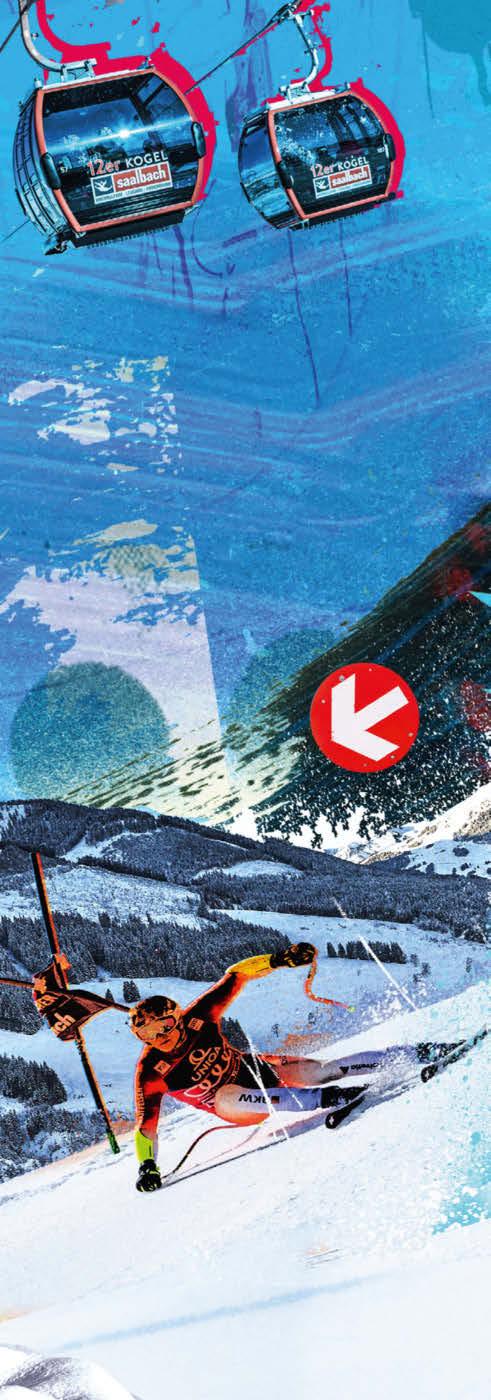

It’s also lässig…
...the way stars file past. As seen at the 2024 World Cup finale, when Vincent Kriechmayr and co walked back to the hotel after training.
...the way the bottom station of the Zwölferkogel ski lift is centrally located. Norway’s Timon Haugan says, “It’s just a few minutes’ walk from my hotel to the ski lift.”
...the way the stars like to be approached by fans. “The attention shows they like you,” says English alpine ski racer Dave Ryding.
...the way there isn’t a World Cup event in Saalbach every year.
“It makes the races on the Zwölferkogel that much more exciting,” says 2017 Swiss world champion Beat Feuz.
...the way the spectators demonstrate their enthusiasm. Ski Austria star Marco Schwarz says, “By the time you get to the final section, you can hear and see the crowds, and that gives you a push.”
...the way Saalbach is ideal for international visitors. “My wife is Dutch, and I always notice how many people from the Netherlands I meet here,” says Dave Ryding.
...the way the superstars celebrate with the fans. After the 2024 World Cup finale, Manuel Feller partied in a bar right by the finish area.
...the way even the youngest fans can get close to the action. Marco Odermatt took time to chat with children and pose for photos at the World Cup finale.
...the way Saalbach truly deserves to host the World Championships, according to our experts. “As a competitor, you want the maximum challenge possible at major events,” explains German skiing legend Felix Neureuther.
...the way the stars stay cool despite all the hustle and bustle. Steffi Venier goes for a coffee in one of the many cosy cafés: “It’s hugely important to wind down in between.”
...the way a world-record-holder from Saalbach makes pizza. Downhill mountain biker Max Stöckl makes wonderful food during the World Championships.
Skis, sarcasm and snow cannons – everything you need to know about Saalbach…

15,000
spectators can fit into the arena on the finishing slope, while many others look on alongside the course.
4,200 volunteers from around the world have applied to help make the 2025 World Ski Championships an unforgettable experience.
7.8
kilometres: the length of the new emergency road between Vorderglemm and Hinterglemm that guarantees emergency services access throughout the event. The Glemmtal, or Glemm Valley, benefits long-term from the World Ski Championships: the road’s subsequent use as a cycle and footpath along the Saalach River will increase the range of leisure activities on offer.
73
per-cent gradient: what downhill racers have to deal with at the steepest point, on the eastern slope.

25
euros for the cheapest tickets –standing room for the men’s and women’s team events
260 kilometres of cross-country skiing are there for anyone in the Skicircus Saalbach Hinterglemm Leogang Fieberbrunn who wants to take a break from the races – 150 of those are in Saalfelden Leogang, 100 in Fieberbrunn.
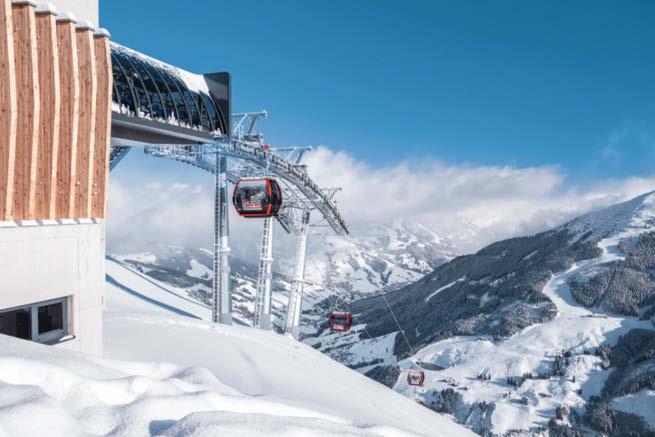
3,500
people can be taken to the summit on the 12er Kogel ski lift per hour. New additions to the Skicircus infrastructure are the 12er Nord cable car in Hinterglemm and the Streuböden cable car in Fieberbrunn right next to the Zillstatt tow lift.
125
square kilometres: that’s the total area of the Saalbach Hinterglemm municipality, and only around four sq-km of this are used for skiing.

1991
saw the legendary Didi Ziesel (pictured) take the role of stadium announcer at the Sunshine World Championships. In 2025, he and Fieberbrunn legend Stefan Steinacher will provide up-todate commentary and keep us entertained at the finish line.
2
new bus terminals in Hinterglemm will make it easier to reach the World Ski Championships. The 2025 Championships are a green event: Maishofen-Saalbach railway station has been modernised and made barrier-free to offer sustainable alternatives to private transport.
100
percent of the Skicircus can be used by our guests during the World Championships.

250,000
cubic metres of water are used to make snow on the World Ski Championships mountain. It’s collected in two storage lakes fed by meltwater and rain.
The Zwölferkogel is the centre of the World Ski Championships. It’s a mountain that requires a lot of feel
piste
Snow groomers such as Richard Mayr, who has worked on the Zwölferkogel since 1995, say the work they do with hulking machinery weighing several tonnes is, in fact, extremely precise. “I can push the snow to exactly where you want it to be,” Mayr says. His secret tool is his special feeling for snow: “There’s no technique. I have to see it with my eyes.”
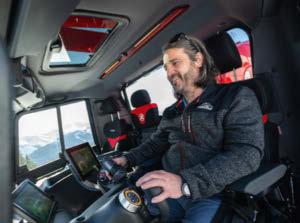
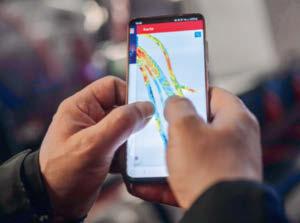
But snow groomers can fall back on one technique that makes them incredibly effective and efficient: every summer, the terrain of the Zwölferkogel – and all the other mountains on the Skicircus Saalbach Hinterglemm Leogang Fieberbrunn – is measured so accurately with the help of drones that even molehills show up on the computer-generated model. Ultrasonic measuring devices on the slope calculate in real time (ie, during preparation) how thick the snow cover is. This enables the snow groomers to make improvements that are precise right down to the last centimetre, and they’ll only produce the amount of snow required to guarantee the desired cover at every point on the slope.


Key
DH: Downhill
SG: Super-G
GS: Giant Slalom
SL: Slalom
TP: Team Parallel
Five races will be held on the Ulli Maier course: the women’s downhill, which starts at 1,835 metres above sea level; the women’s Super-G at 1,600m; the men’s slalom at 1,280; the women’s slalom at 1,260m, and the women’s team combination.
Five events are to be held here. The start of the men’s downhill is 1,974m above sea level, the men’s Super-G at 1,780m, and the men’s giant slalom at 1,520m. The women’s giant slalom starts at 1,460m, and the men’s team combination will also be held here. The team parallel competition, which opens the World Ski Championships on February 4, starts at 1,220m, just 160m above the finish line.
Alpine World Ski Championships, February 4–16, 2025
Get your tickets here!
START
A quick start: 73per-cent gradient, then a sharp left. High-speed action at its best.
Start Women’s DH

PANORAMASPRUNG
A key spot on the women’s course, requiring high technical skill and nerves of steel.
SCHNEEKRISTALLSPRUNG
The men jump 55m here while hurtling downhill at 140kph – no wonder with a 73-per-cent gradient.
OCHSENRITT
A compression, followed by a jump… The combination of pressure and difficulty demands all the stars’ skills.
The Zwölferkogel is a 1,984m peak in the Glemmtal, and the area is part of the Kitzbühel Alps. Geologically, the Glemmtal – like the Eastern Alps as a whole – are part of the greywacke zone, named after the local sandstone.
The Zwölferkogel takes its name – ‘number twelve rounded summit’ in English – from the fact that the sun is directly above the peak at noon
Six hundred sportsmen and women from more than 60 countries will compete for medals at the 2025 World Ski Championships, and all on a single mountain –every race is being run on the Zwölferkogel.
The technical events have above-average changes in altitude, as the ski stars discovered at the 2024 World Cup finale. As overall World Cup winner Marco
Odermatt put it, “The giant slalom course is fairly flat but very, very long. That makes it very difficult.”
To make the races on the Zwölferkogel even safer, the course was widened in two areas towards the top. But don’t worry: no trees were cut down; existing trenches were raised instead.
The Austrian stars enjoy home advantage in Saalbach as the Zwölferkogel has been an official test course for Ski Austria since the 2016/17 season and speed specialists have been able to test and train here at their leisure.
Depending on the event, anywhere between 150250 people are employed on the Zwölferkogel to guarantee that the races can go ahead as
scheduled on topquality slopes.
The winners will be honoured on the Medal Plaza in the middle of the Hinterglemm pedestrian zone Those 900m are the centre of the World Ski Championships, and most of the ski stars will stay in the hotels there.
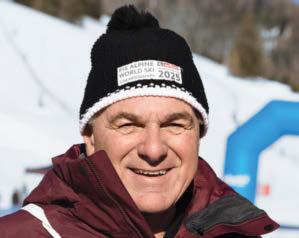
Bartl Gensbichler is considered the father of the World Ski Championships. He was part of it in 1991, too.
When Ski Austria, the Austrian Ski Association, was looking to rebrand, one short phrase – skiverrückt (German for ‘crazy about skiing’) –was enough to express their passion, emotion and professionalism. It also perfectly describes the Skicircus Saalbach Hinterglemm Leogang Fieberbrunn. Bartl Gensbichler, father of the 2025 World Ski Championships and race director at the 1991 Sunshine World Championships, remembers his childhood: “In those days, we were almost born with skis on,” he says. “I learnt to ski right behind the house. I did a couple of turns and then it was off down the slope. And at some point we made it onto the Zwölferkogel.”
100-per-cent ski operation during the Championships
“The valley used to be terribly poor,” says Gensbichler. “Tourism was our only chance. Tourism kept people here.” It changed the place and, with it, the entire Skicircus. That fact remains anchored in people’s minds and is a driving force for never-ending improvements. Yes, they’ll even celebrate Marcel Hirscher skiing for the Netherlands: “Marcel will always be an Austrian,” Gensbichler says. “Now he’s skiing for the Netherlands, which is a huge deal for us because this is a Dutch hotspot.”
NB: During the World Championships, all slopes, including those on the Zwölferkogel, will remain open.
saalbach.com
Breakfast on the mountain, partying with the stars and the lollipop helicopter are all not to be missed
Even during the World Ski Championships, the Skicircus will still offer fun on the slopes – and that includes the Zwölferkogel, right next to the championship courses.
The Zwölferkogel in Hinterglemm is easily accessible by ski or snowboard from Saalbach, Leogang and Fieberbrunn.
Explore the Skicircus Saalbach Hinterglemm Leogang Fieberbrunn at a slow pace – 270km of slopes guarantee you all the variety you need, even when the races are on.
Further proof that Saalbach is skiverrückt! The coat of arms depicts a snow crystal and a pair of crossed golden skis as a reminder that winter sports have been celebrated here in Salzburg since 1898. Also, the ski-circuit logo shows a jumping clown.
Ideally factor 30 – minimum! The 1991 World Ski Championships went down in history as the Sunshine World Championships. We expect blue skies in February 2025, too.

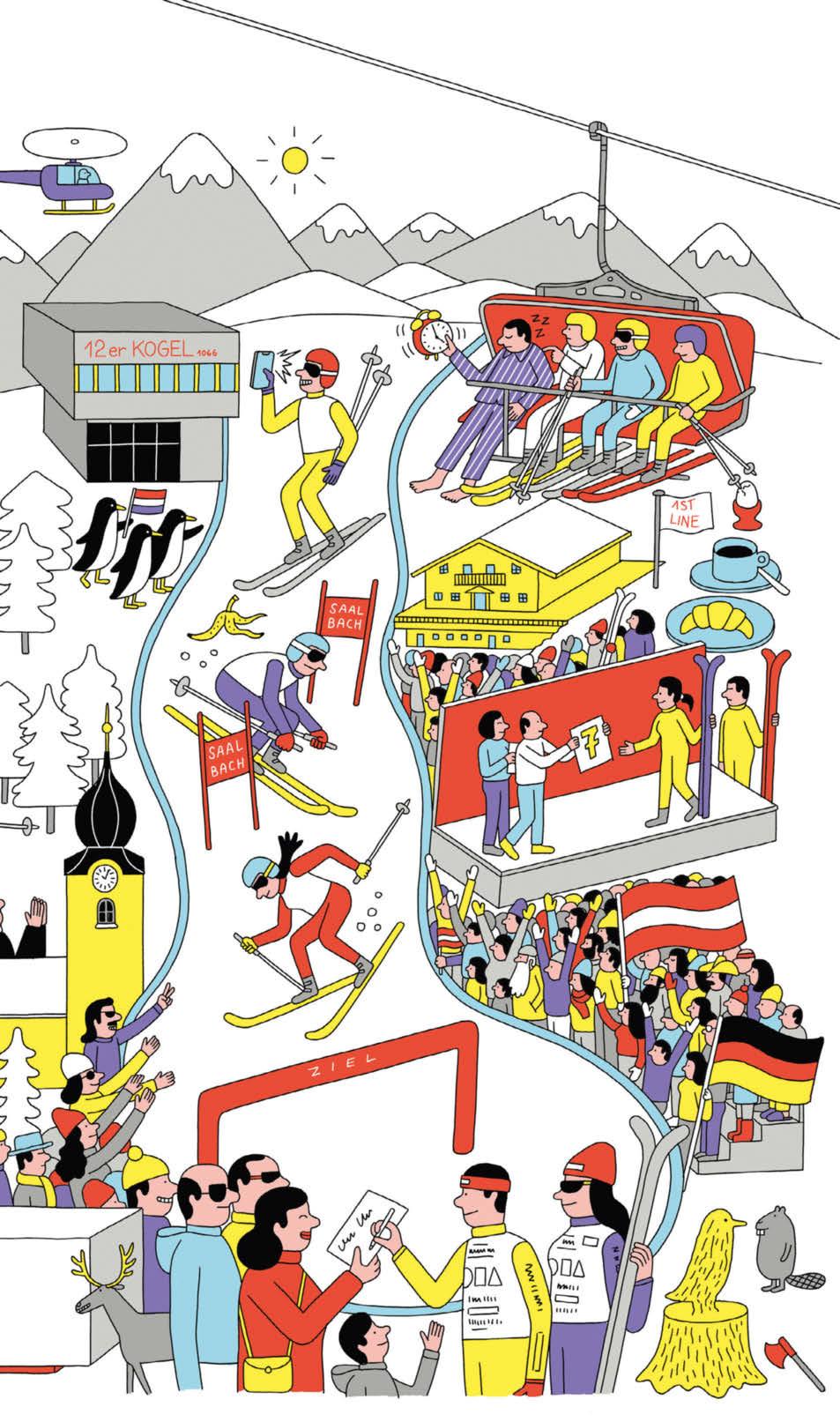
6 Keep your eyes open
Ski companies will be at the finish area with their own trucks. There’ll be merch, goodie bags, and maybe even a chance to meet your favourite star.
7 Party with the stars
Around 4,000 fans will celebrate their heroes at the Medal Plaza and the Fan Mile.
8 Attend the draw
You can see all the top stars on stage the night before their race at the Plaza. With a bit of luck, you might even get a selfie.
9
Meet relaxed ski legends
There are always autograph sessions and ‘meet and greets’ with the stars. Superstar Marco Odermatt devoted a whole hour to his youngest fans in 2024. And don’t be surprised if you come across Mikaela Shiffrin and co – the sportsmen and women usually walk from their hotels to the Zwölferkogel.
10
With any luck, you’ll be on the first lift of the day next to one of the stars on their way to inspect the slopes.
11 Visit the stands! There’s nowhere better to enjoy the atmosphere than in the stands with the fan clubs of Manuel Feller and co.
12 Breakfast on the mountain Fieberbrunn and Leogang offer a magical morning atmosphere with great breakfast options up on the mountain.

“I was out trail running with a friend last summer and uttered the dumbest thing ever to him, saying I’d only fallen while trail running three times in my entire career. I immediately said, ‘I know I shouldn’t say that,’ because, of course, you know what happens when you comment out loud on your good fortune so far in life. It took about 24 hours for the universe to correct itself as I was flying down a different trail, all by myself, the following afternoon, feeling great, knowing I had about 15 more minutes of downhill running in the sunshine before I got to my car and could drive back into town and get a pizza. Next thing I knew, I was sprawled out on the side of the trail. I looked back to see what I’d tripped on, and it was nothing. Well, almost nothing – a water bar, rising not much higher above the trail than, say, a tube of toothpaste might. And it almost put me in a really bad place. How many times have I fallen on the trail since then? I’m not talking about it any more, thank you.”
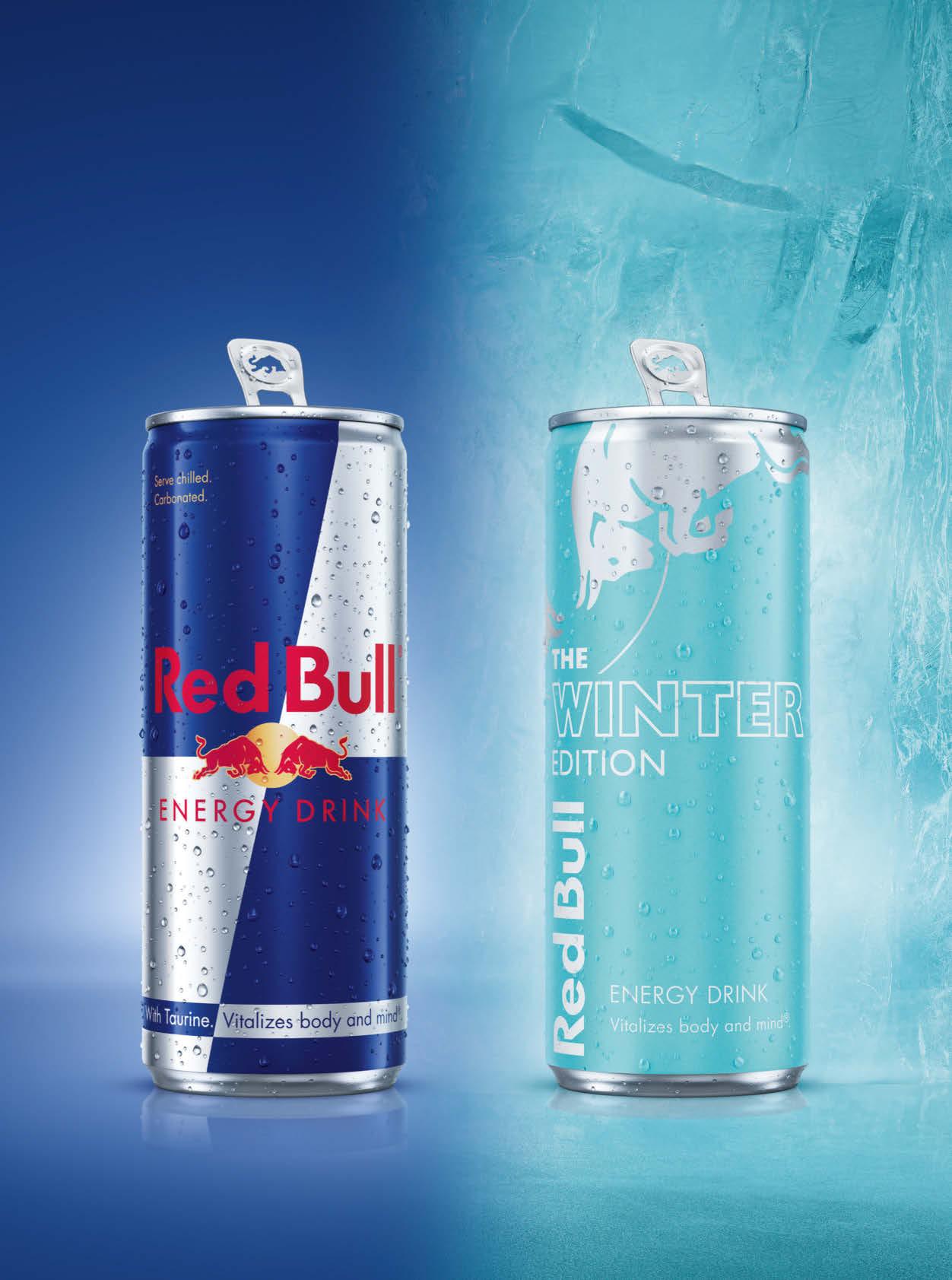



TRAIN TO PERFORM WITH THE ULTIMATE SMARTWATCH F Ē NIX ® 8
